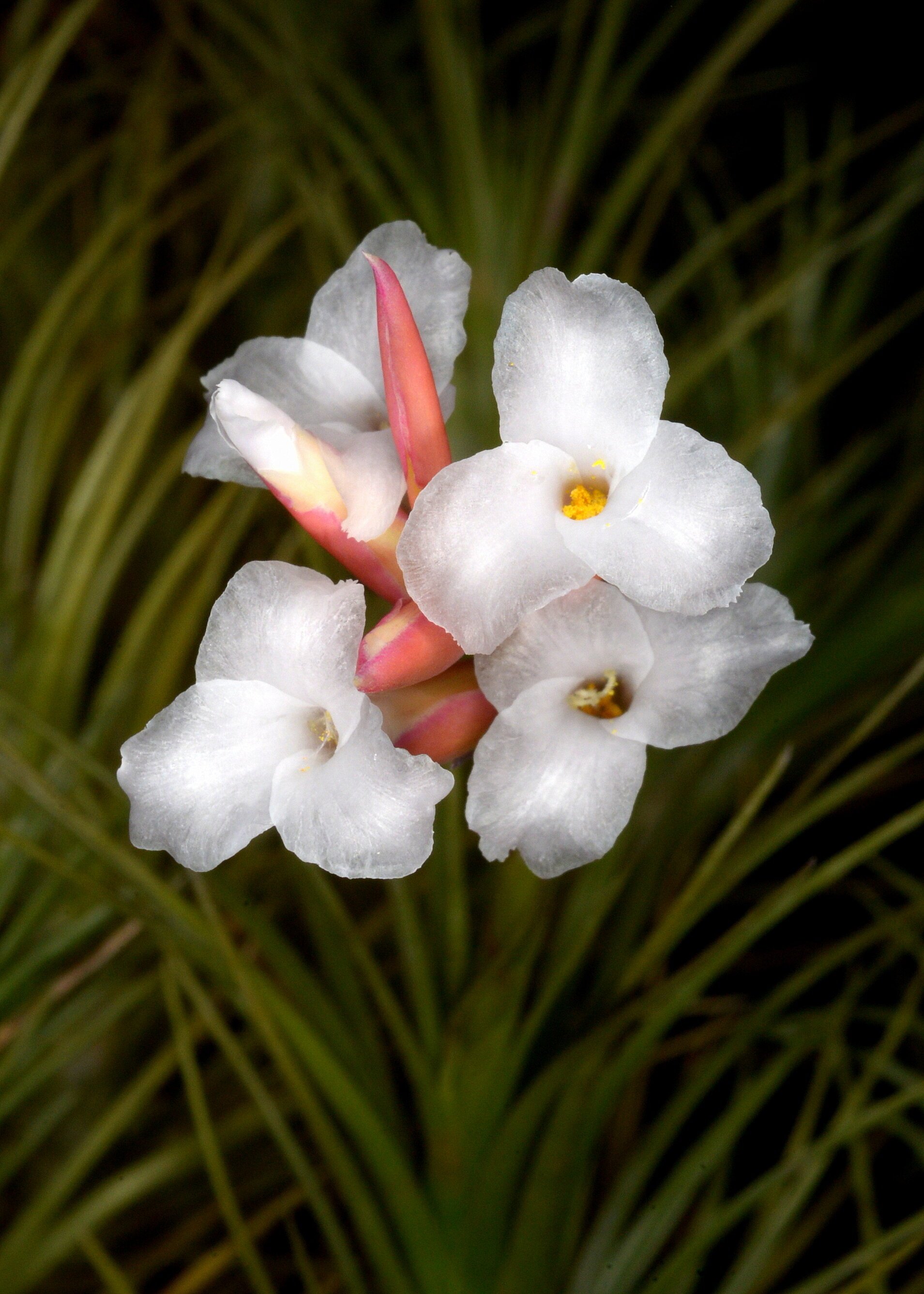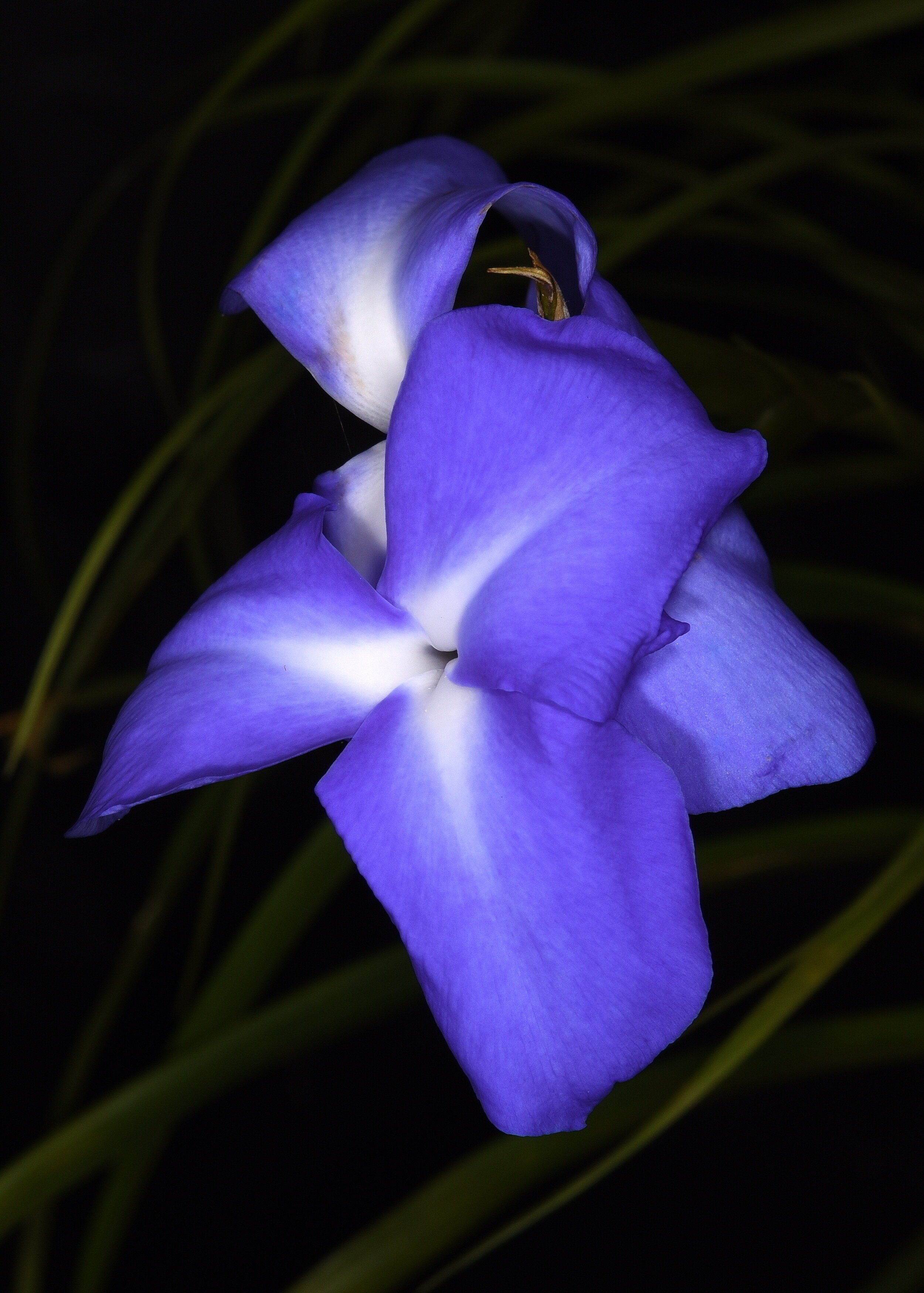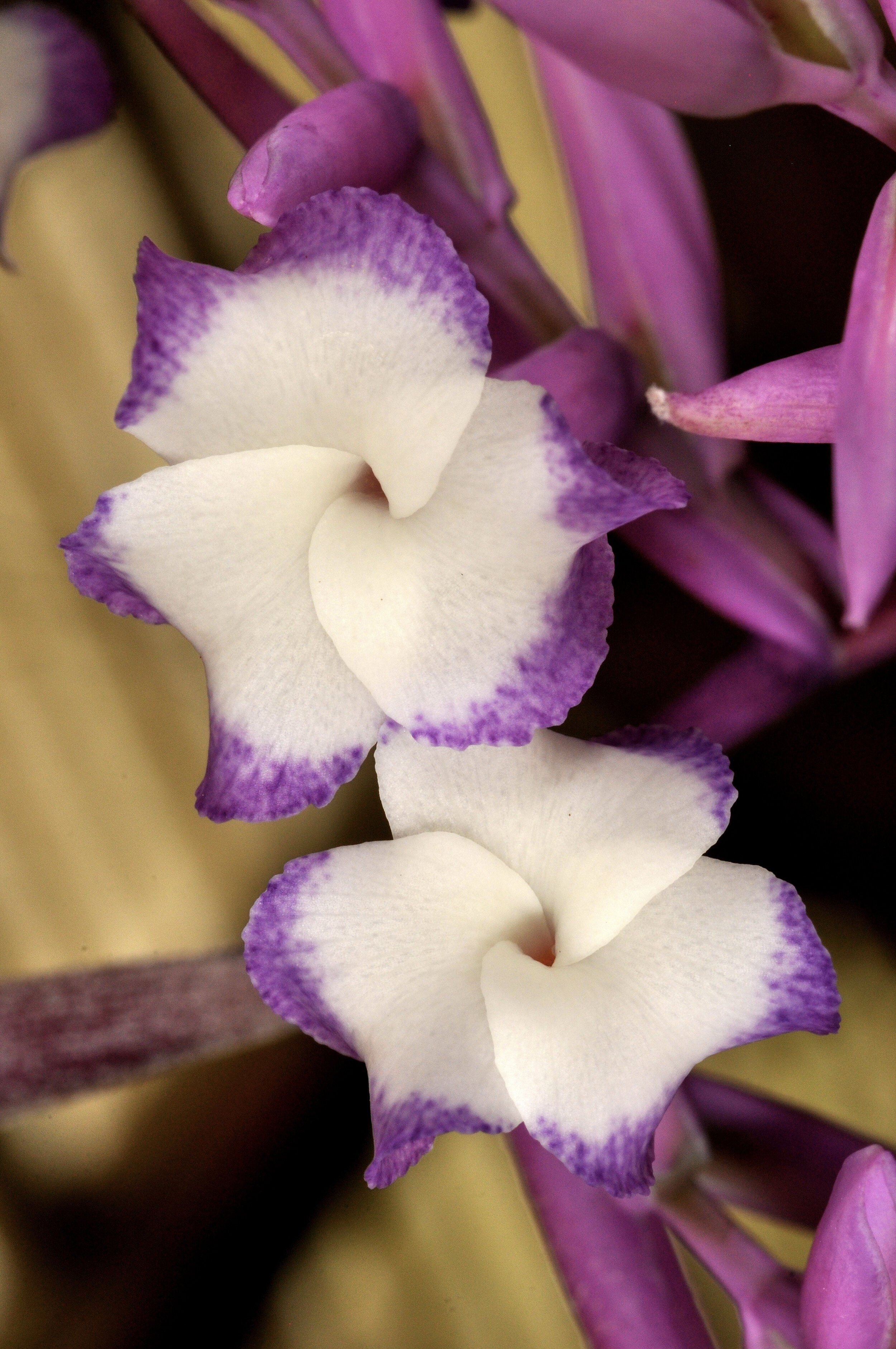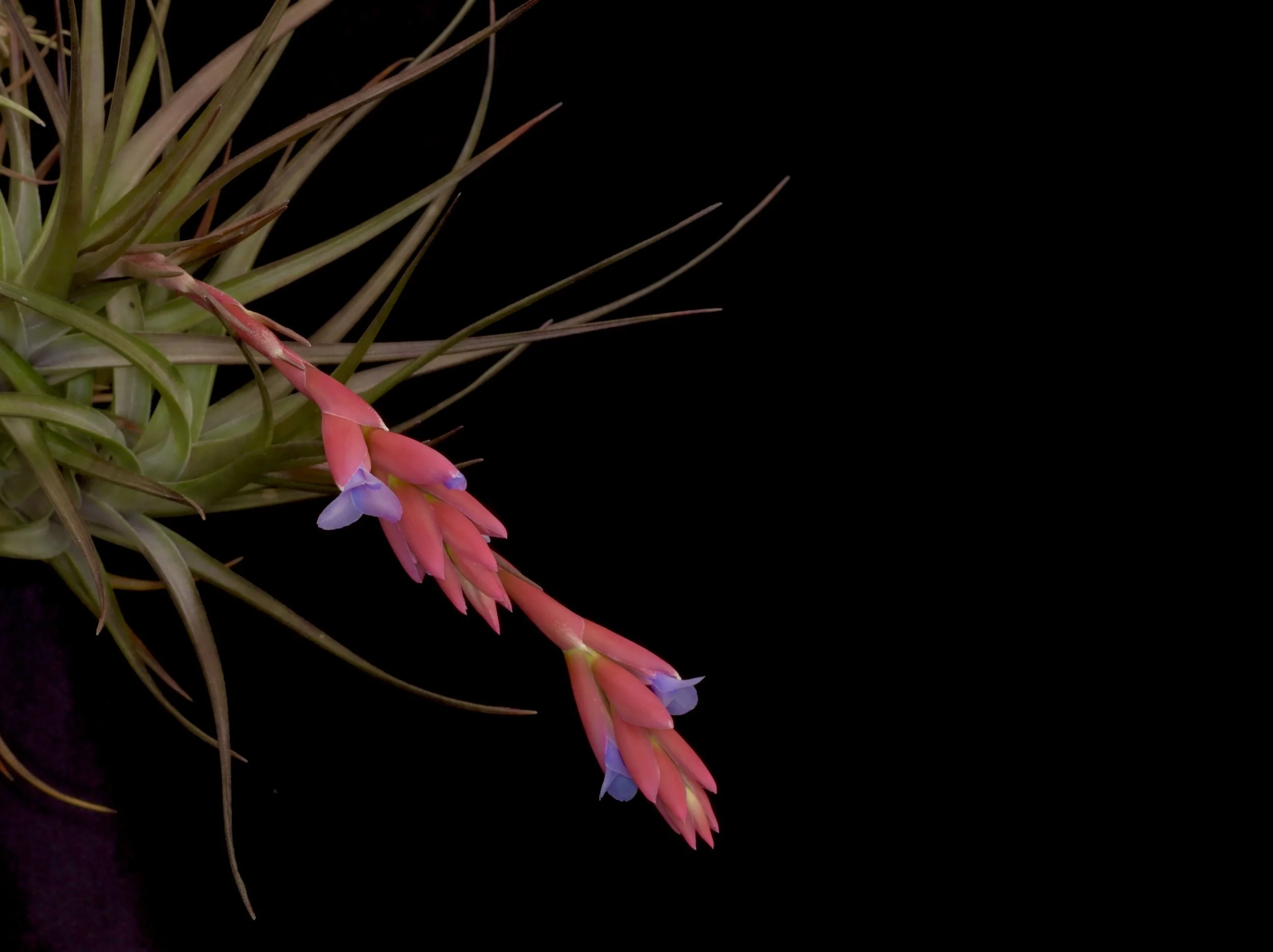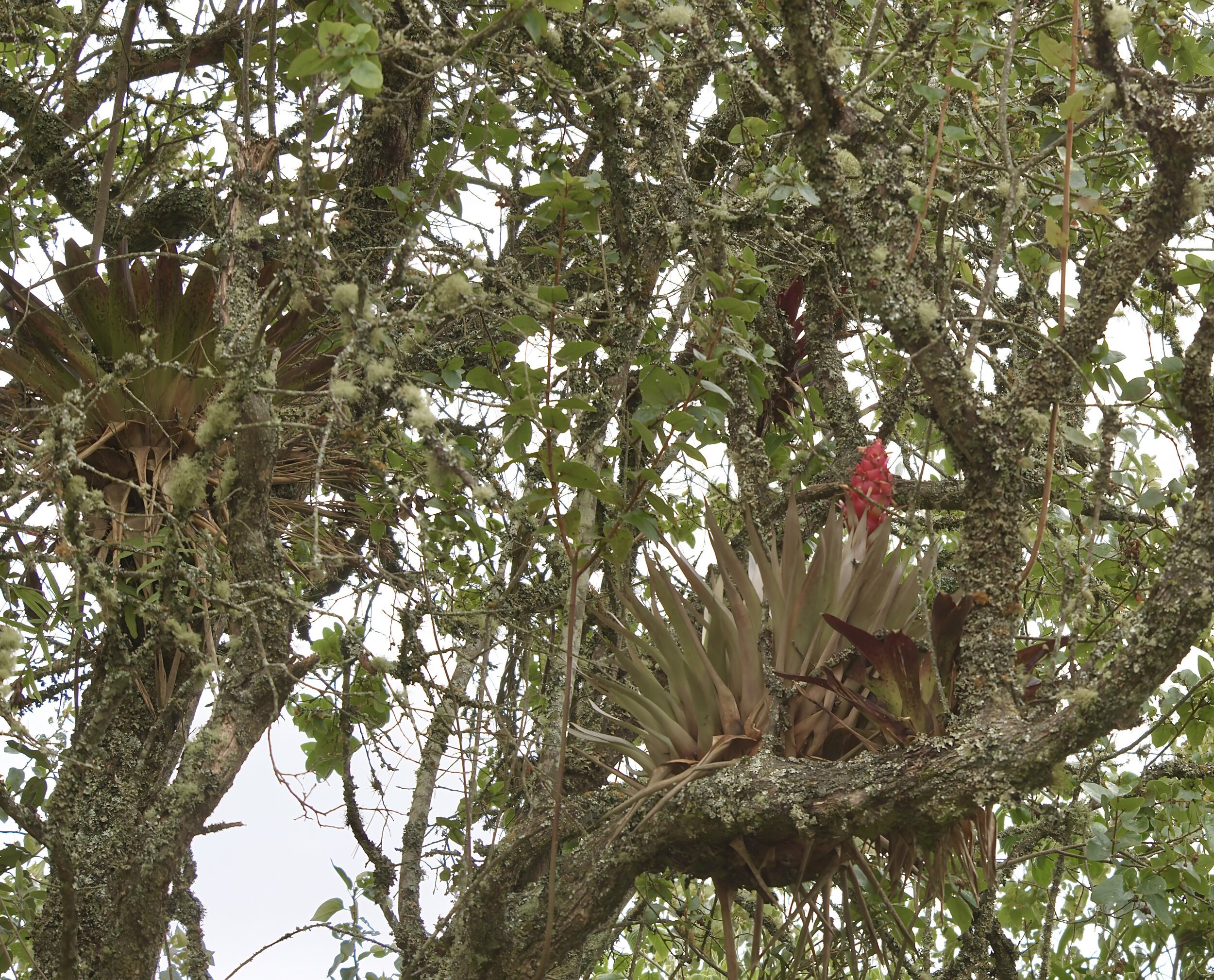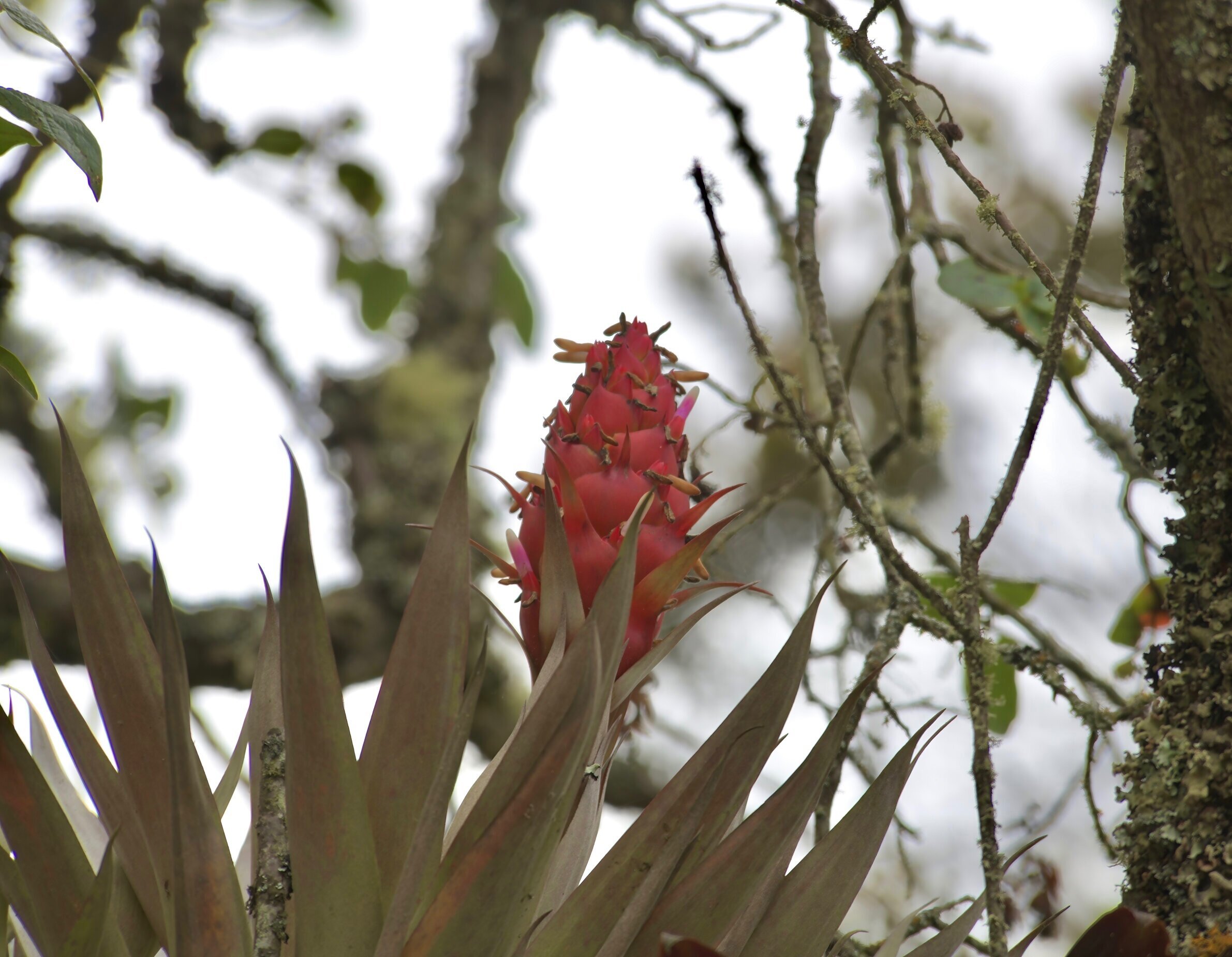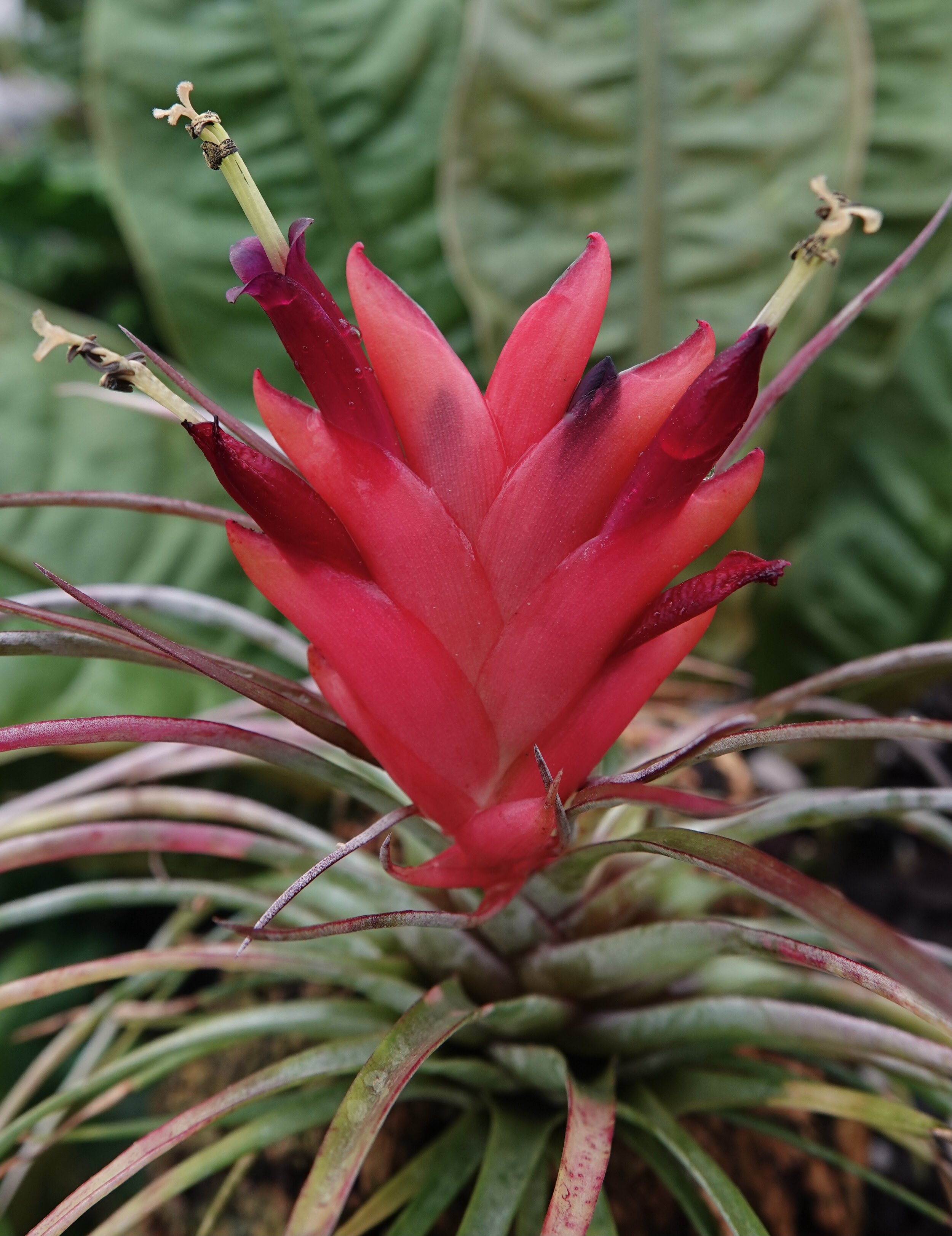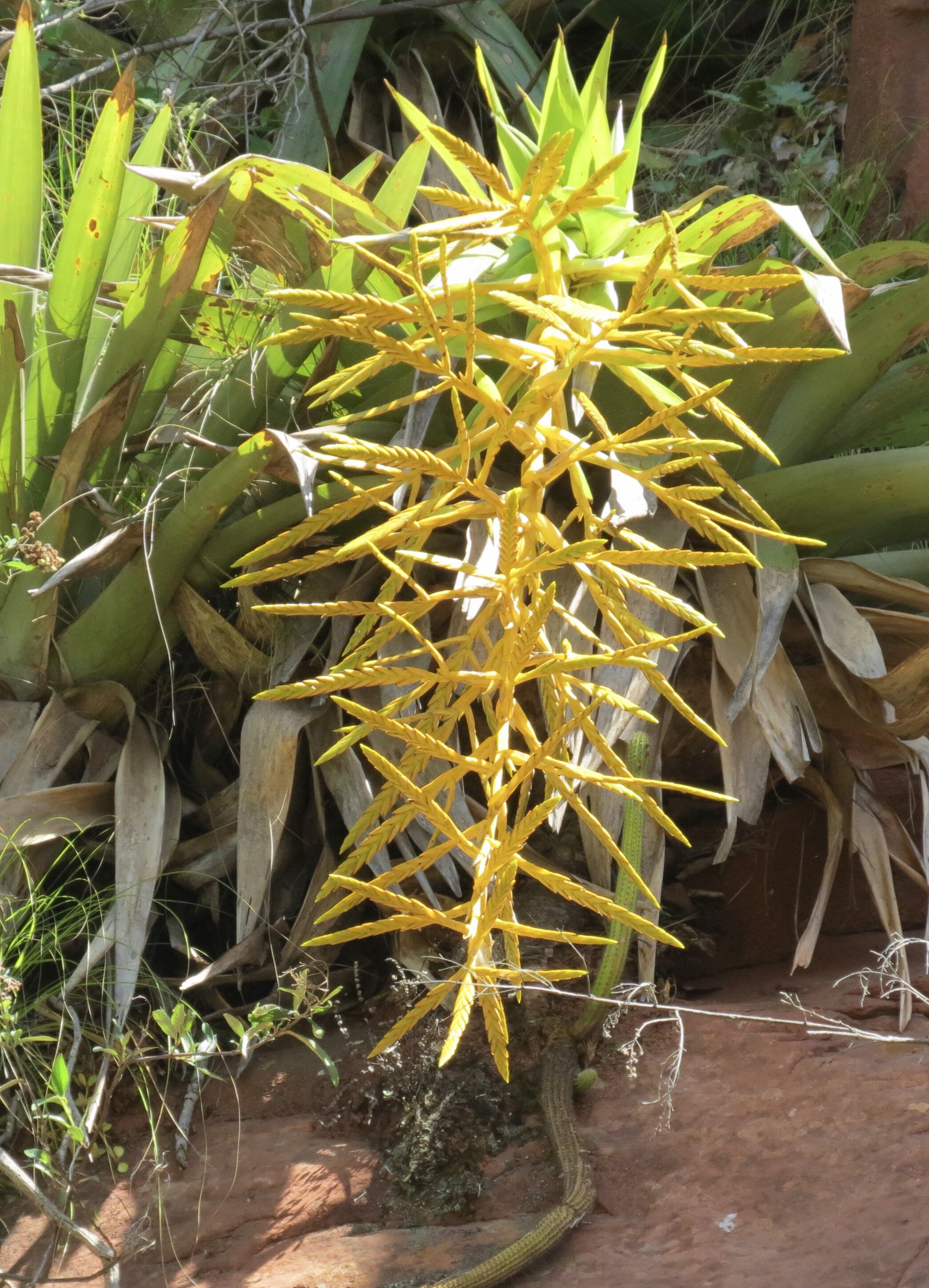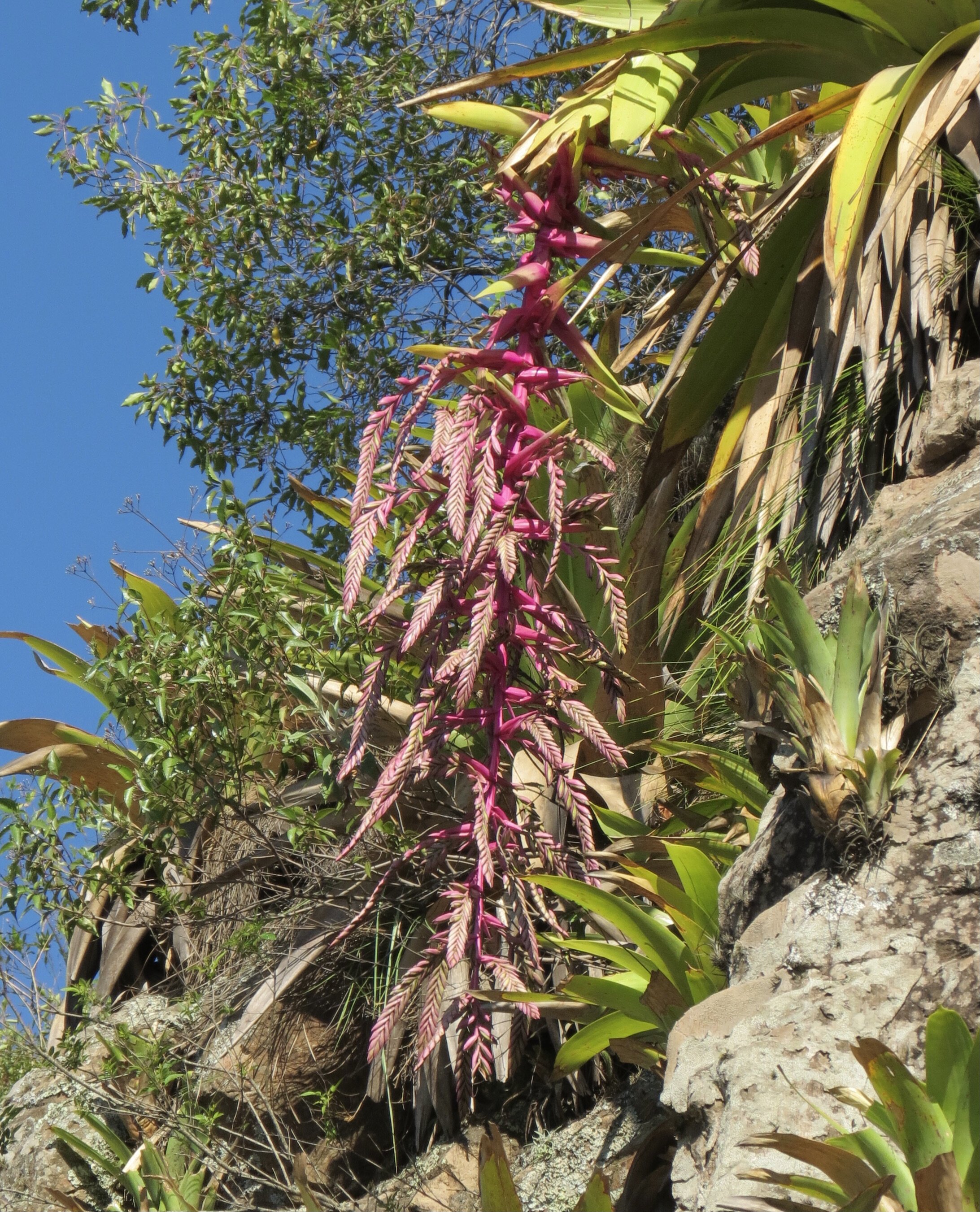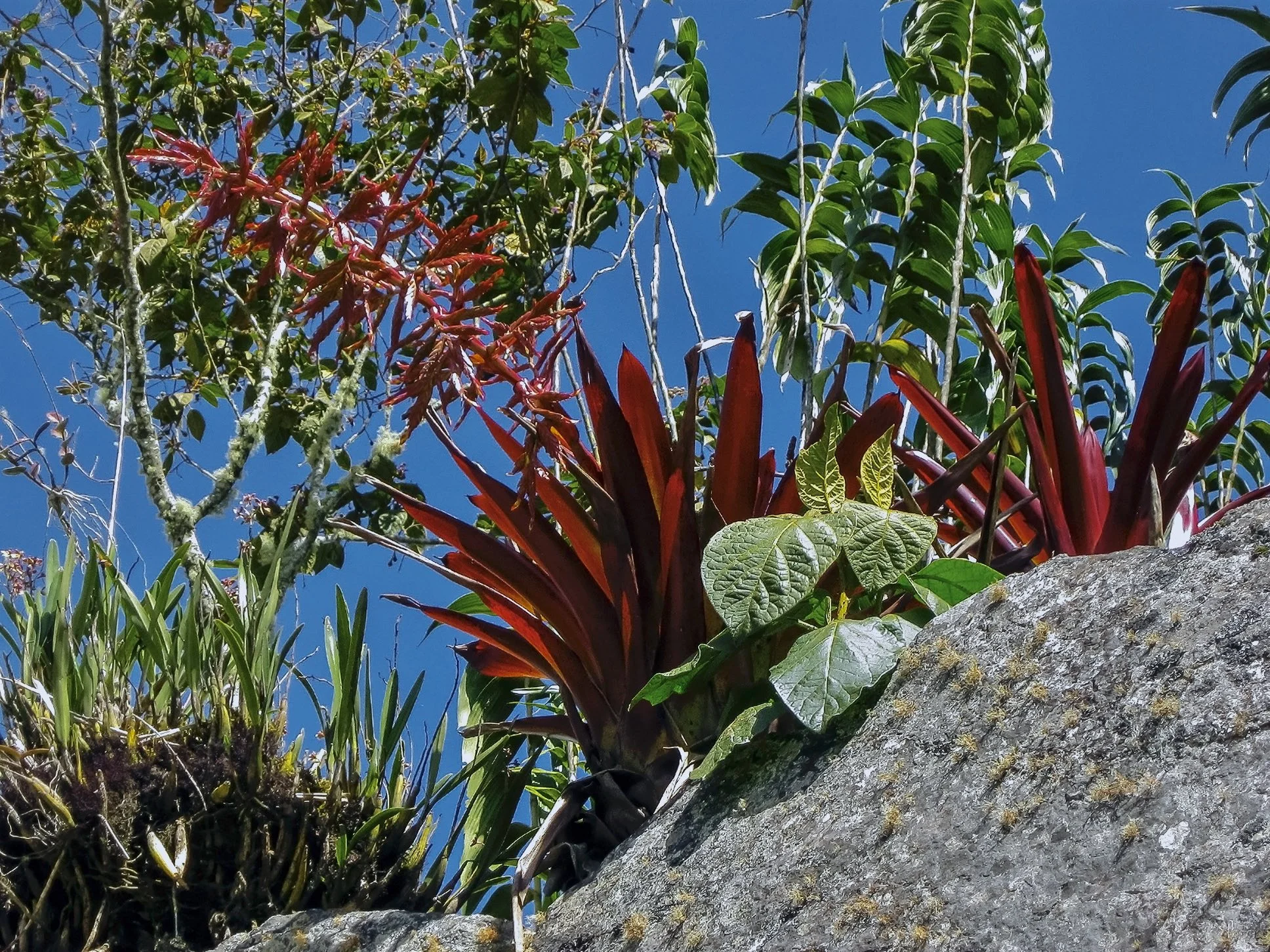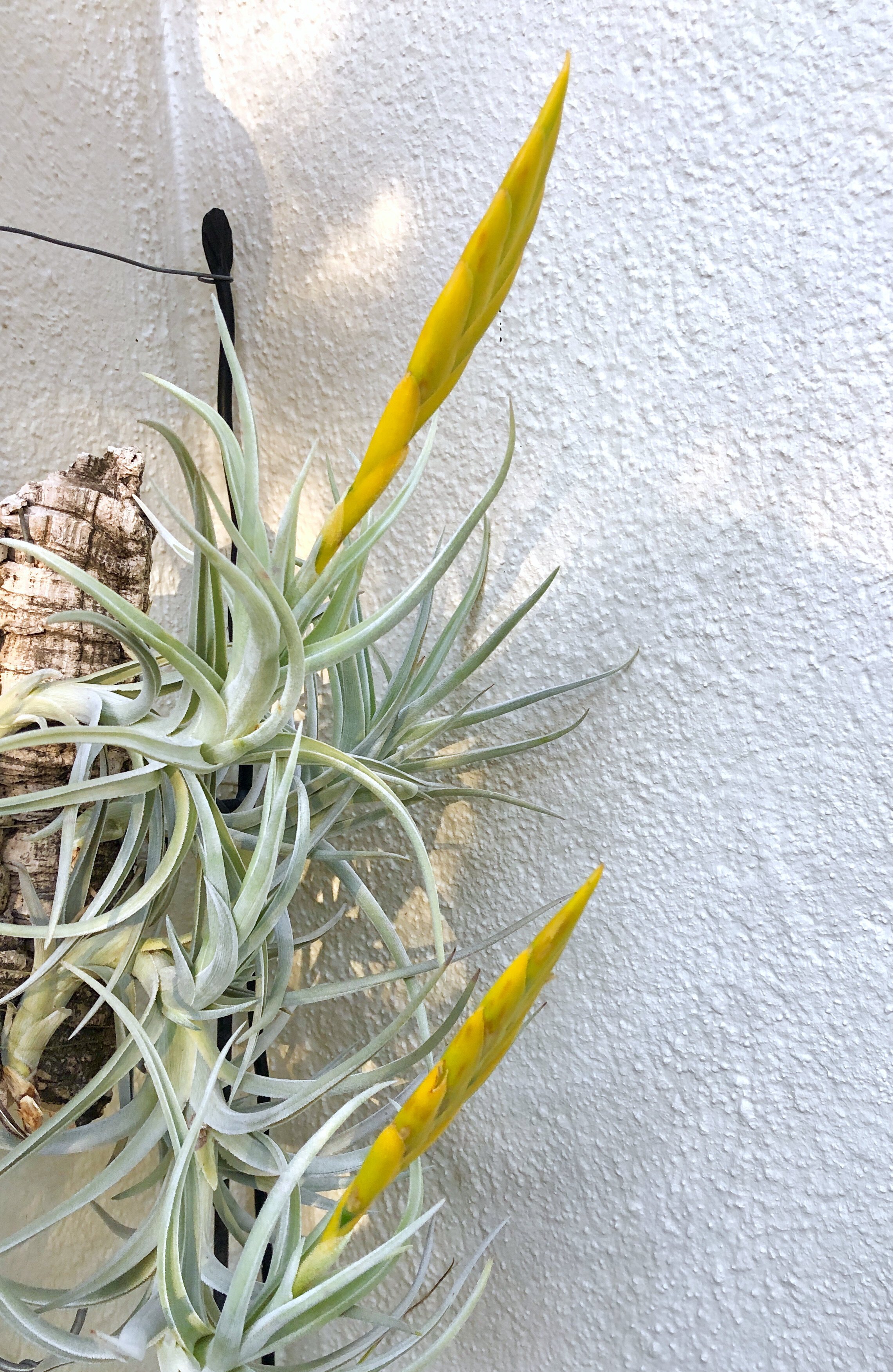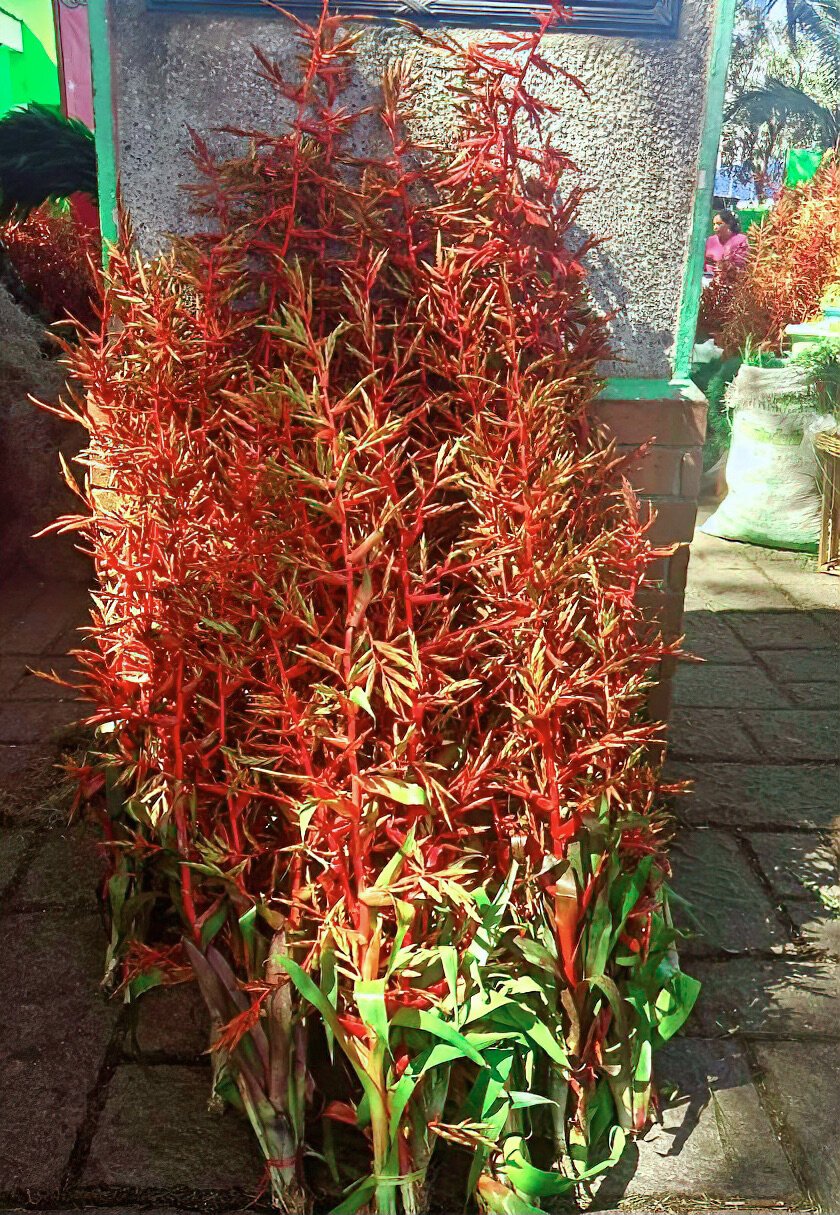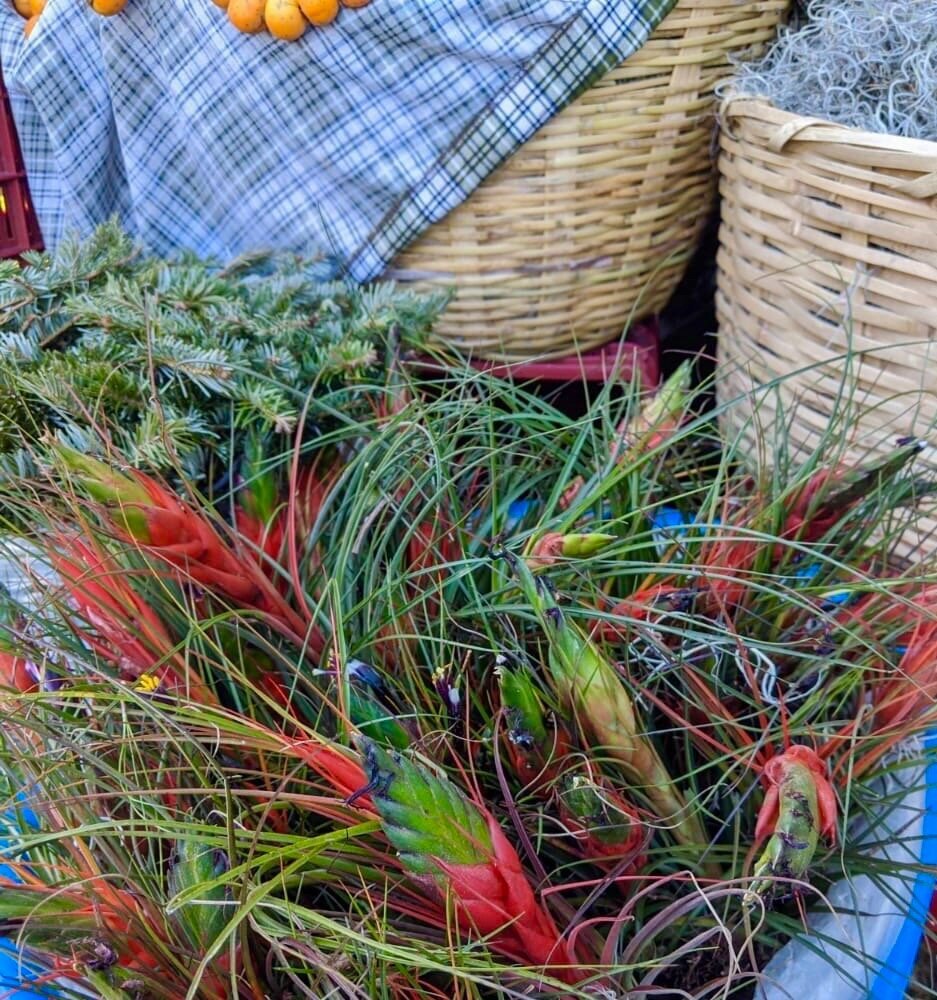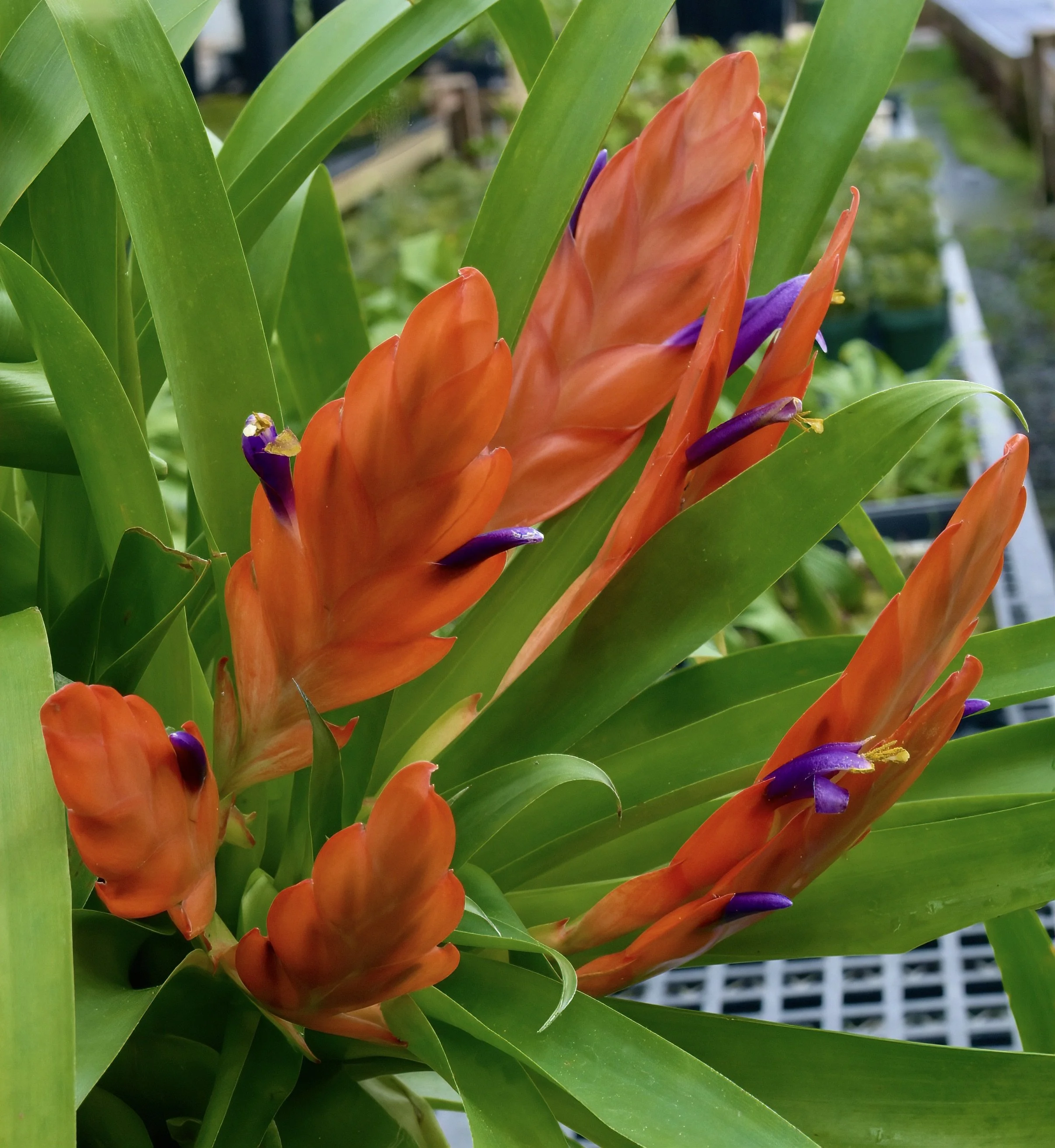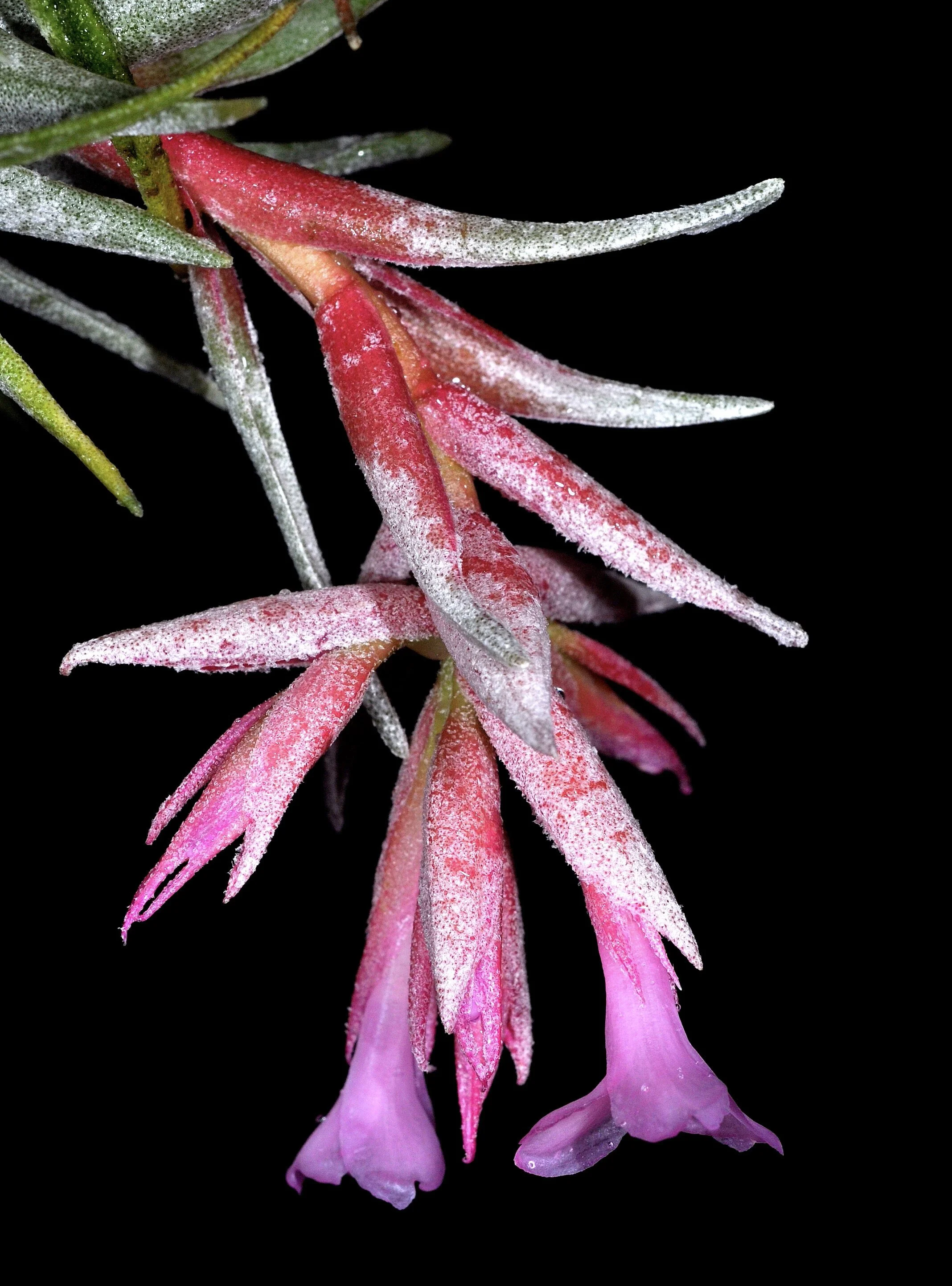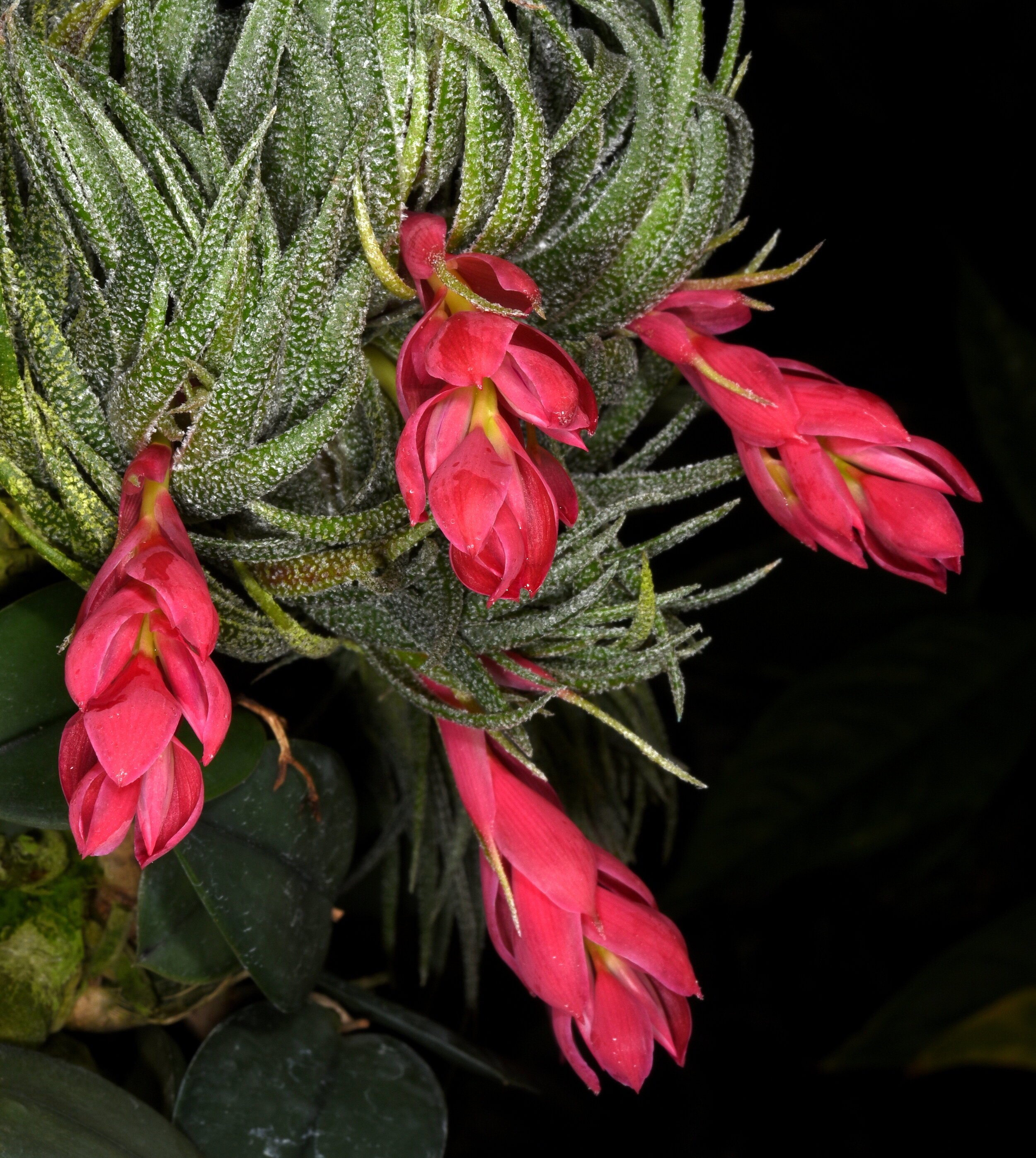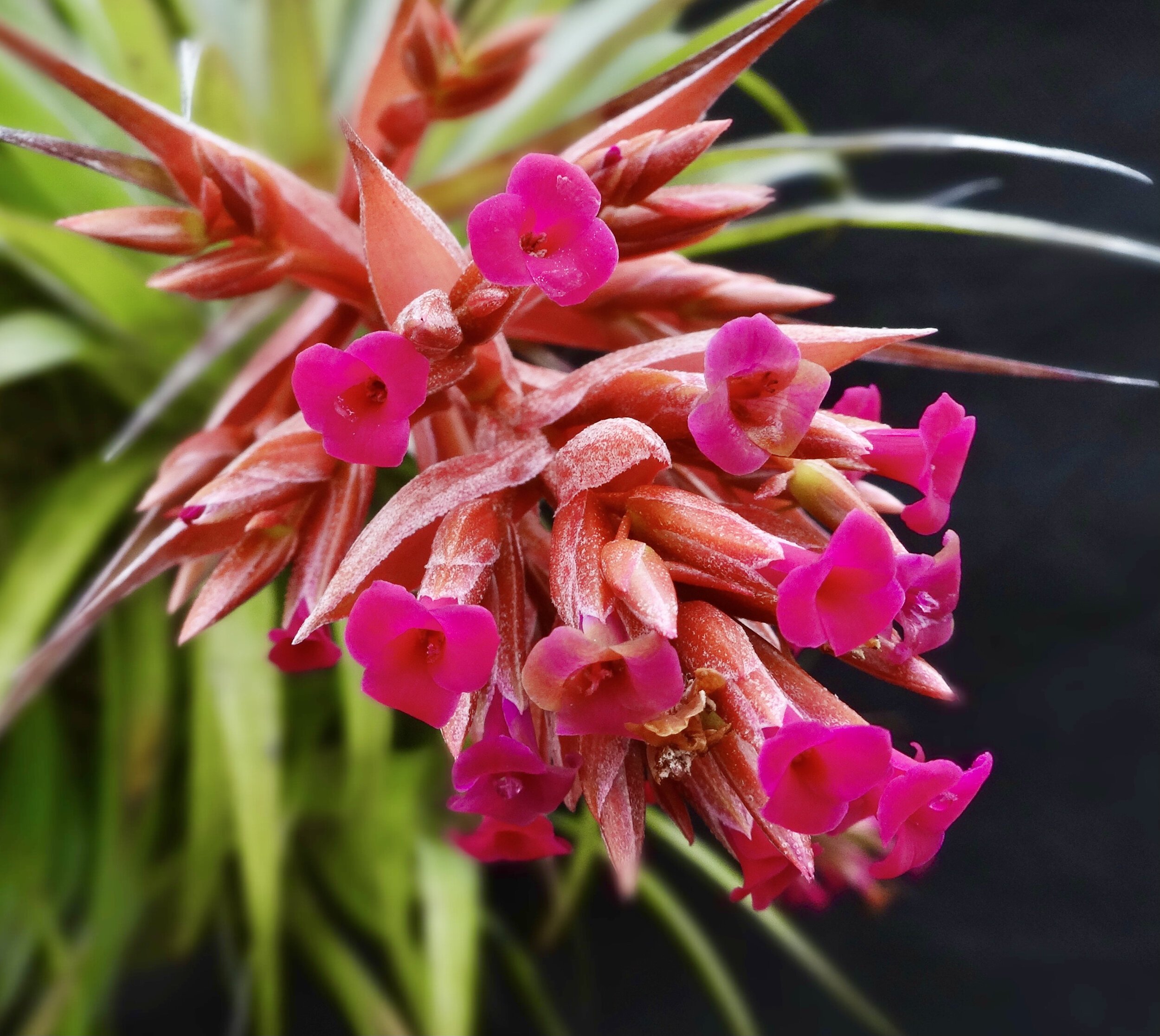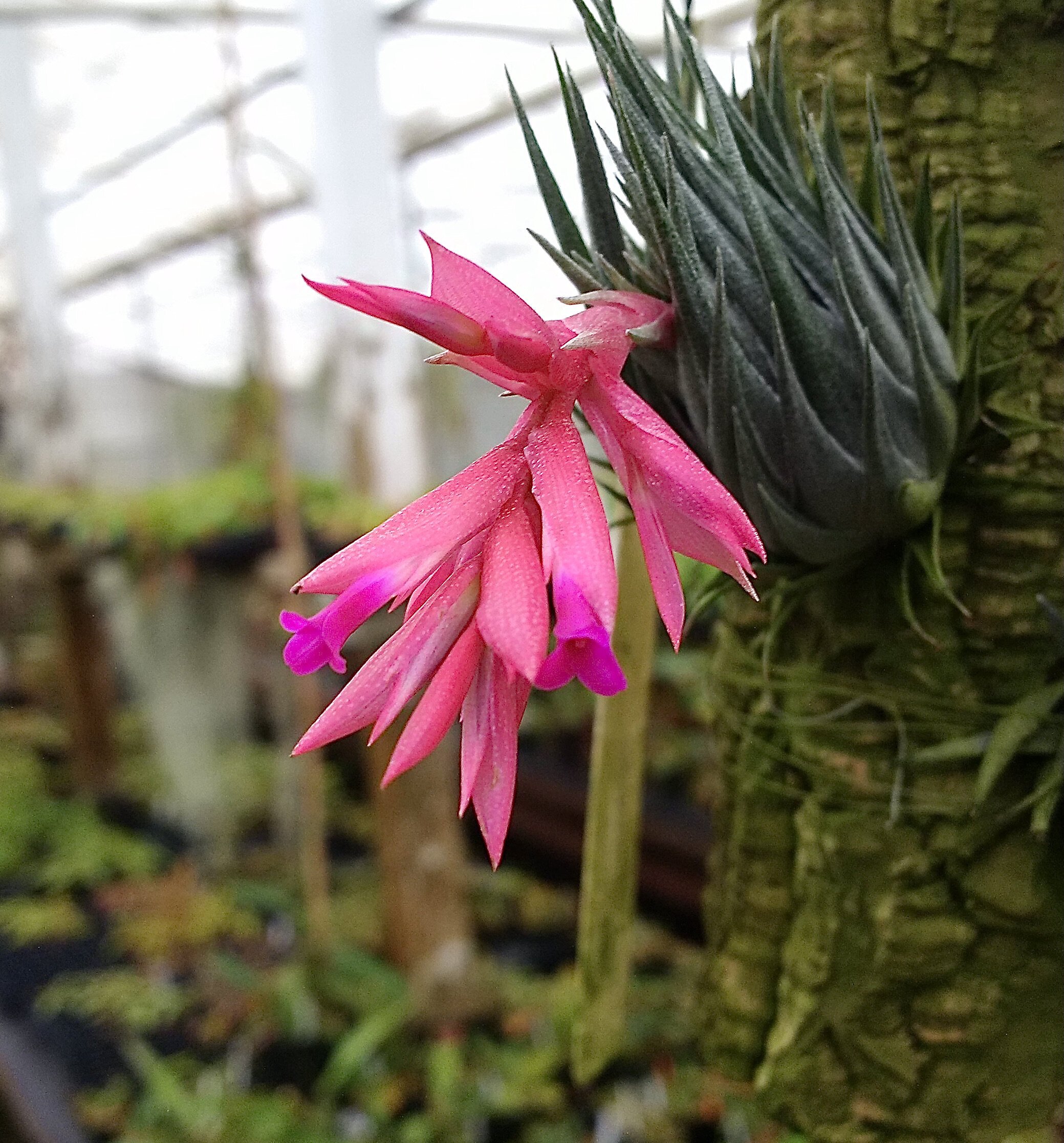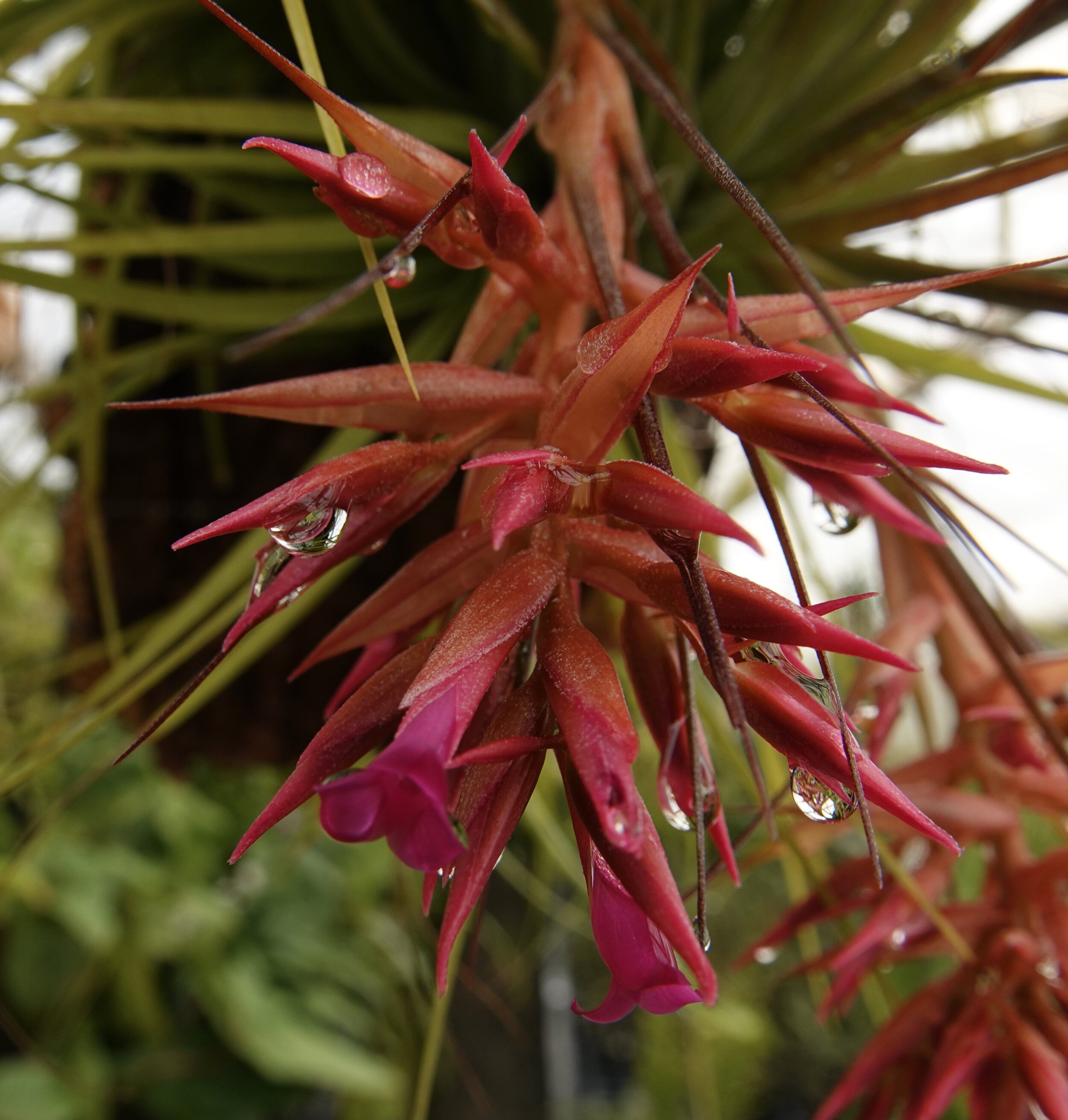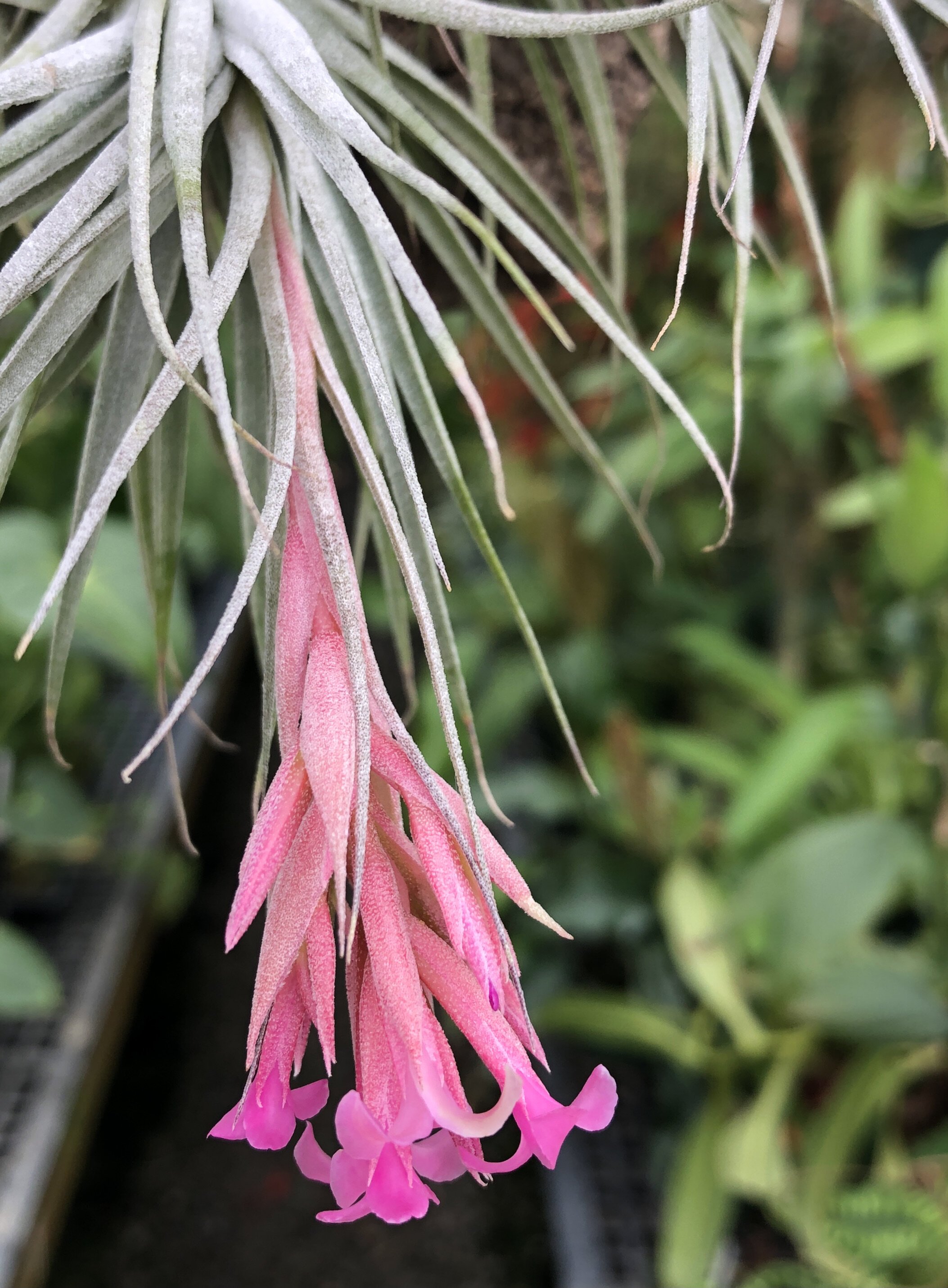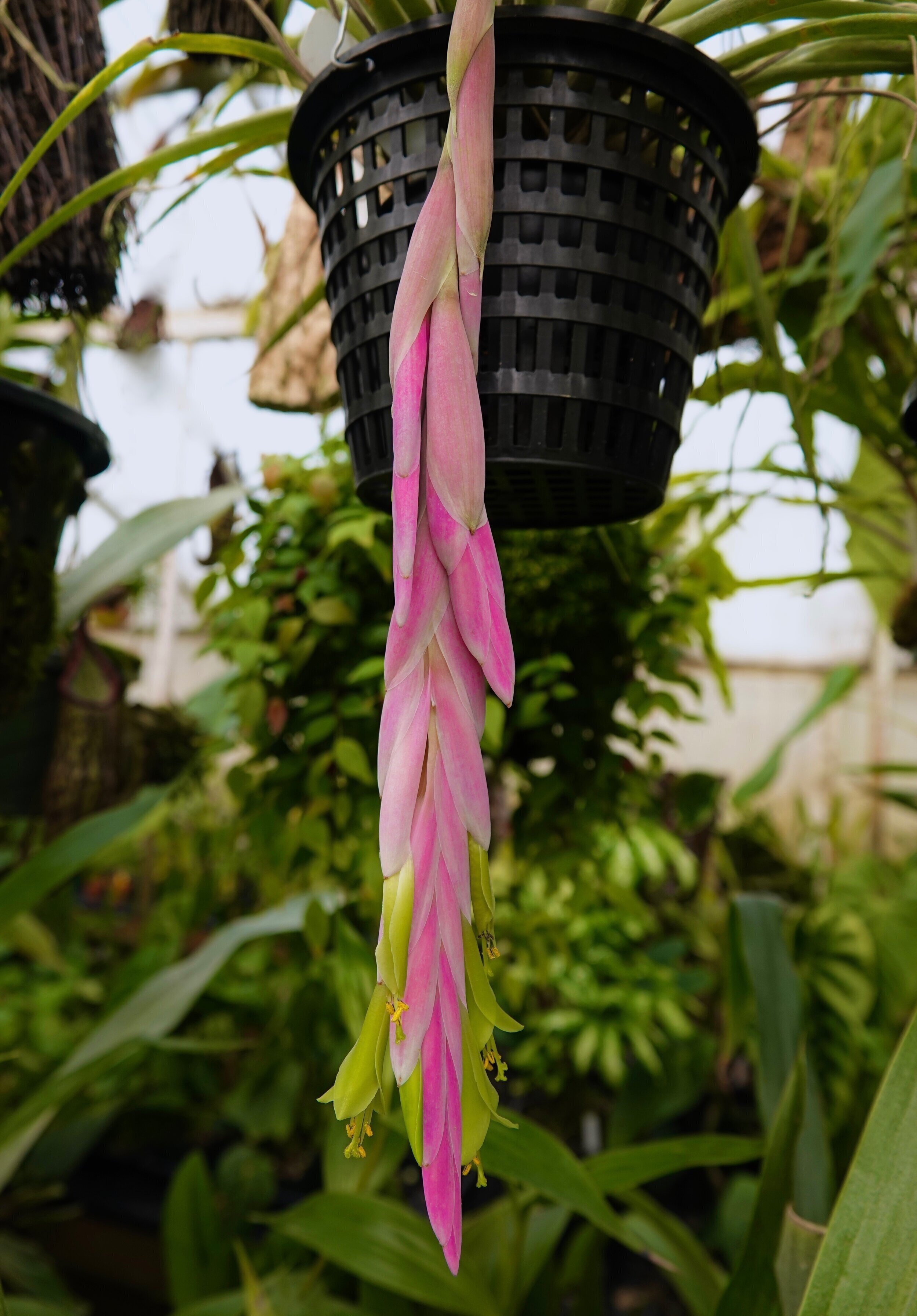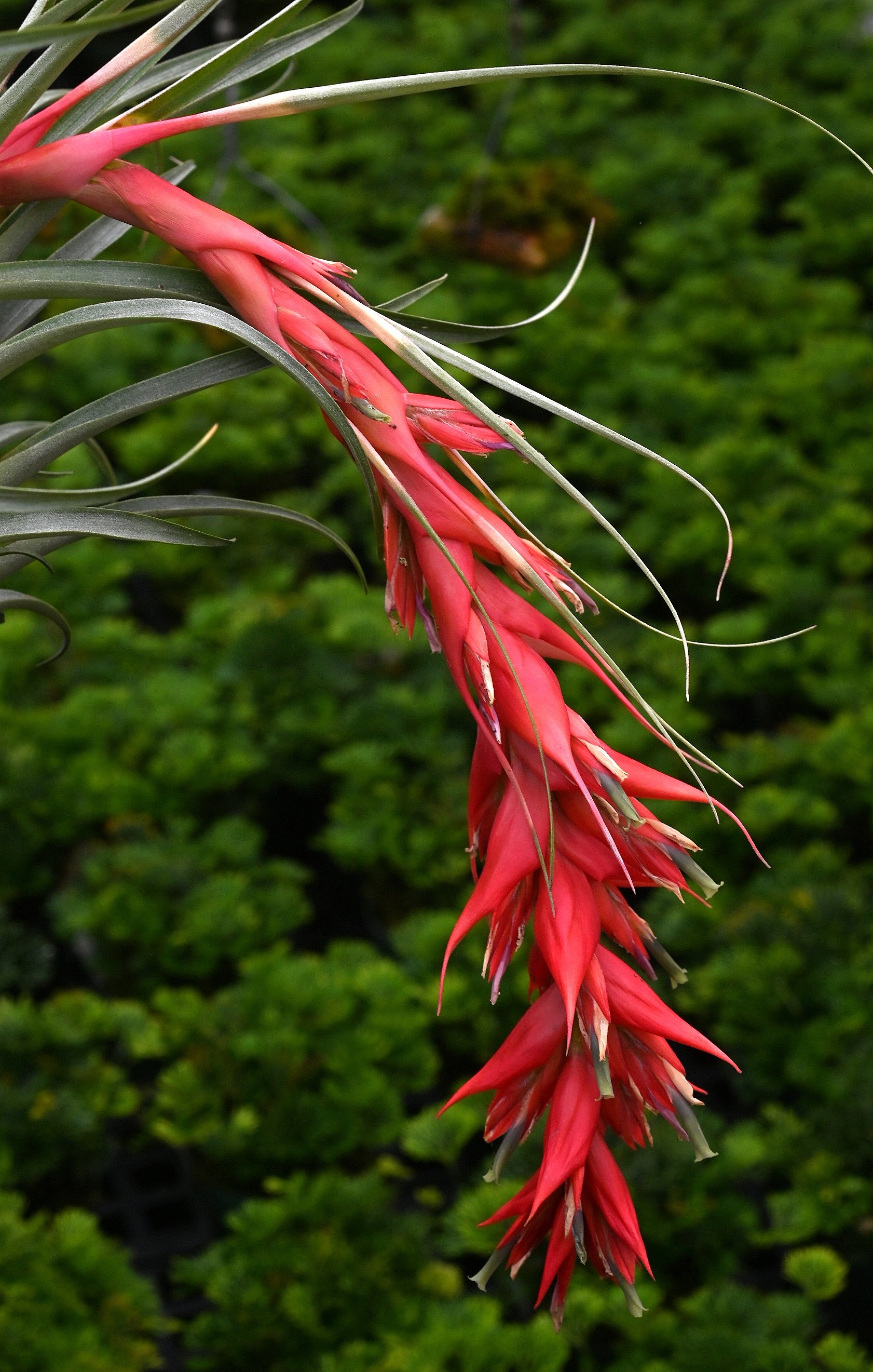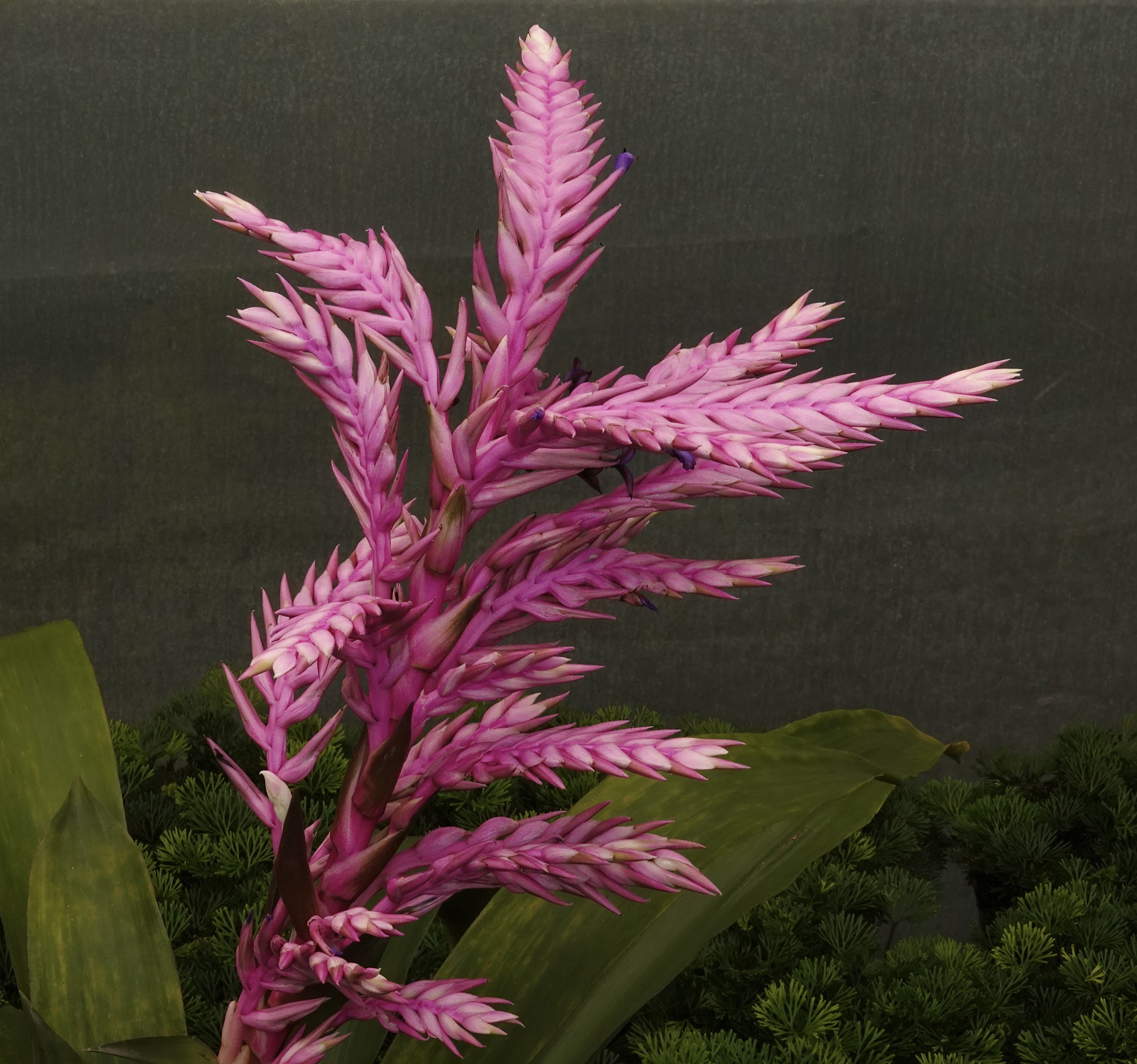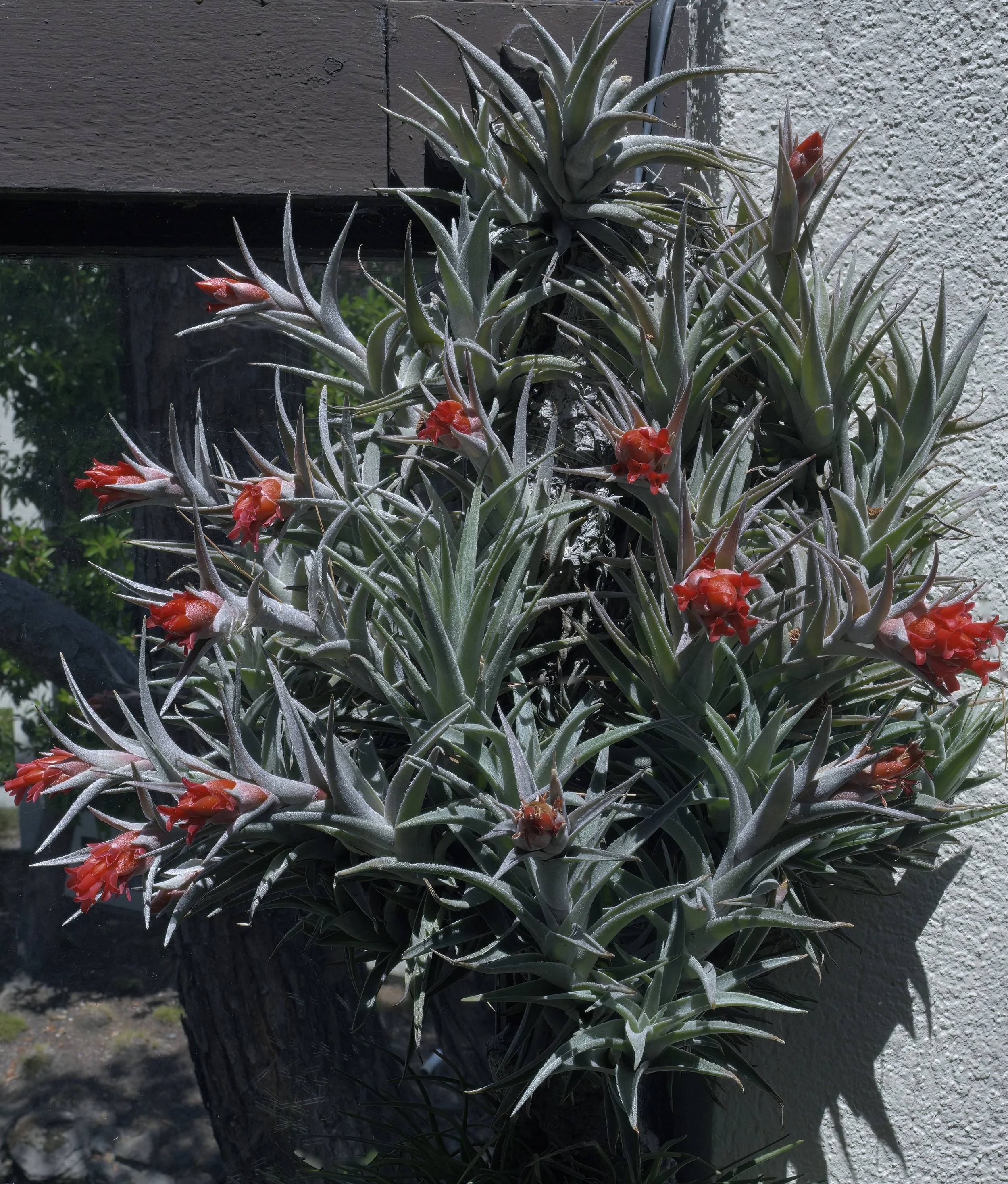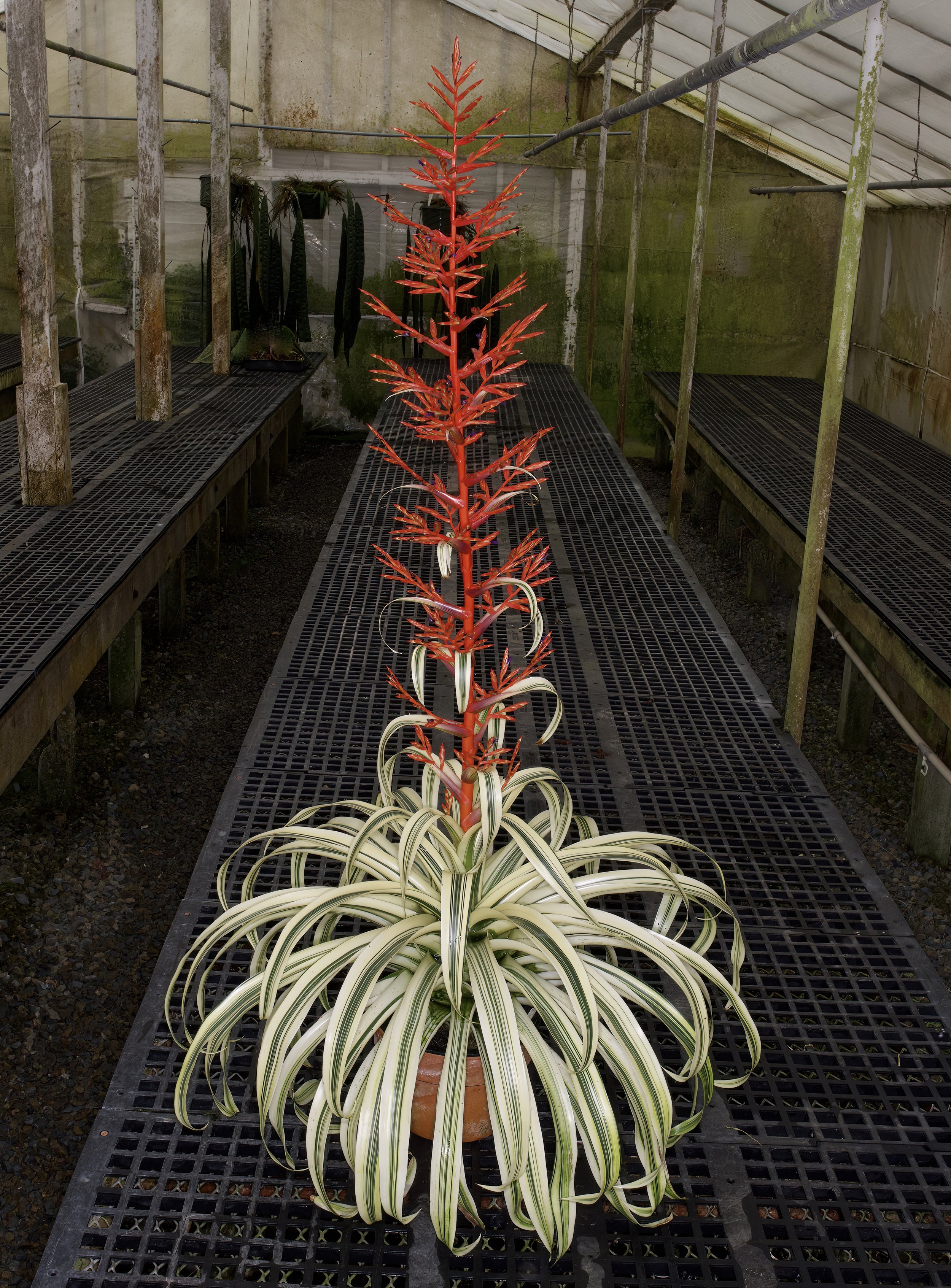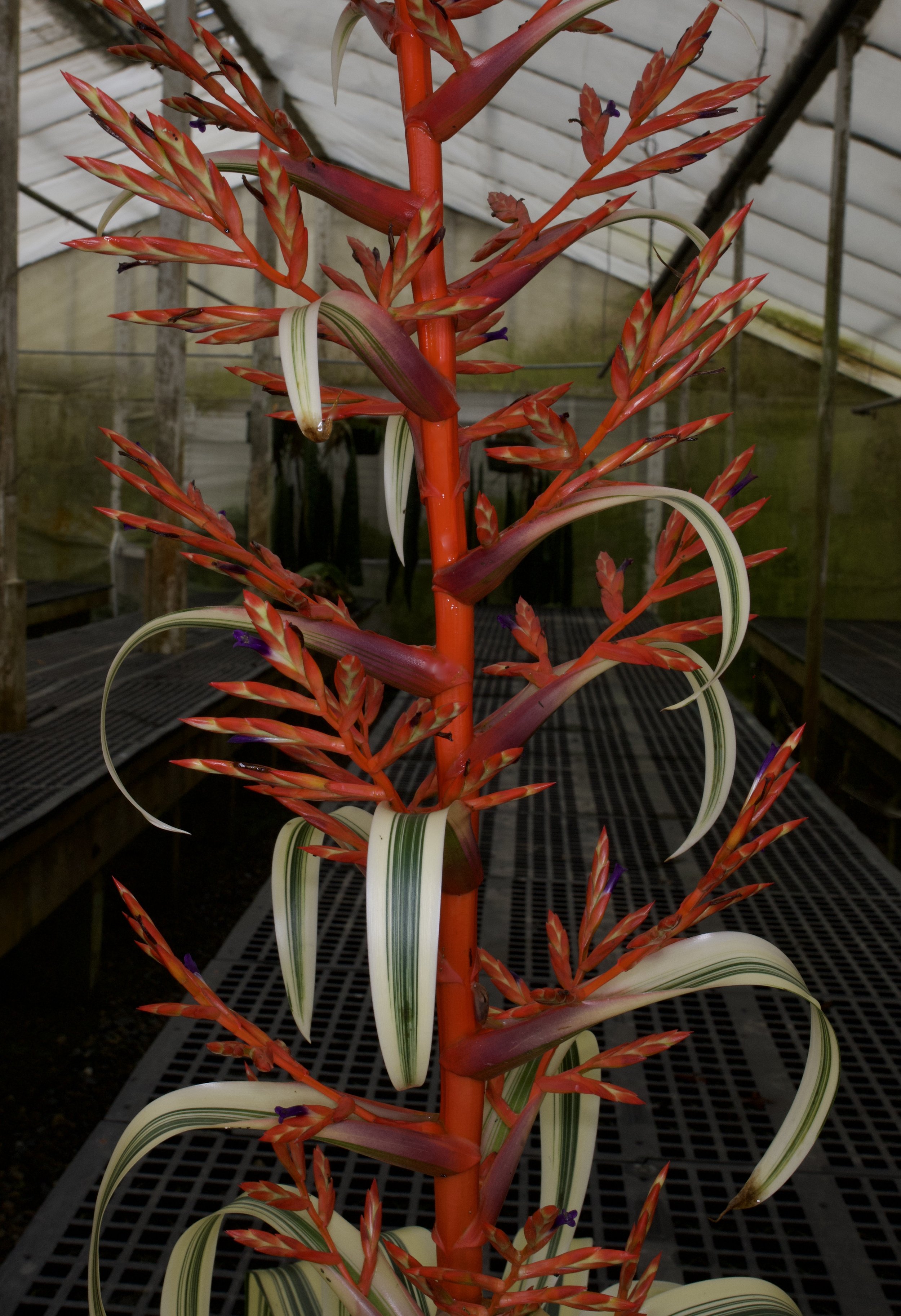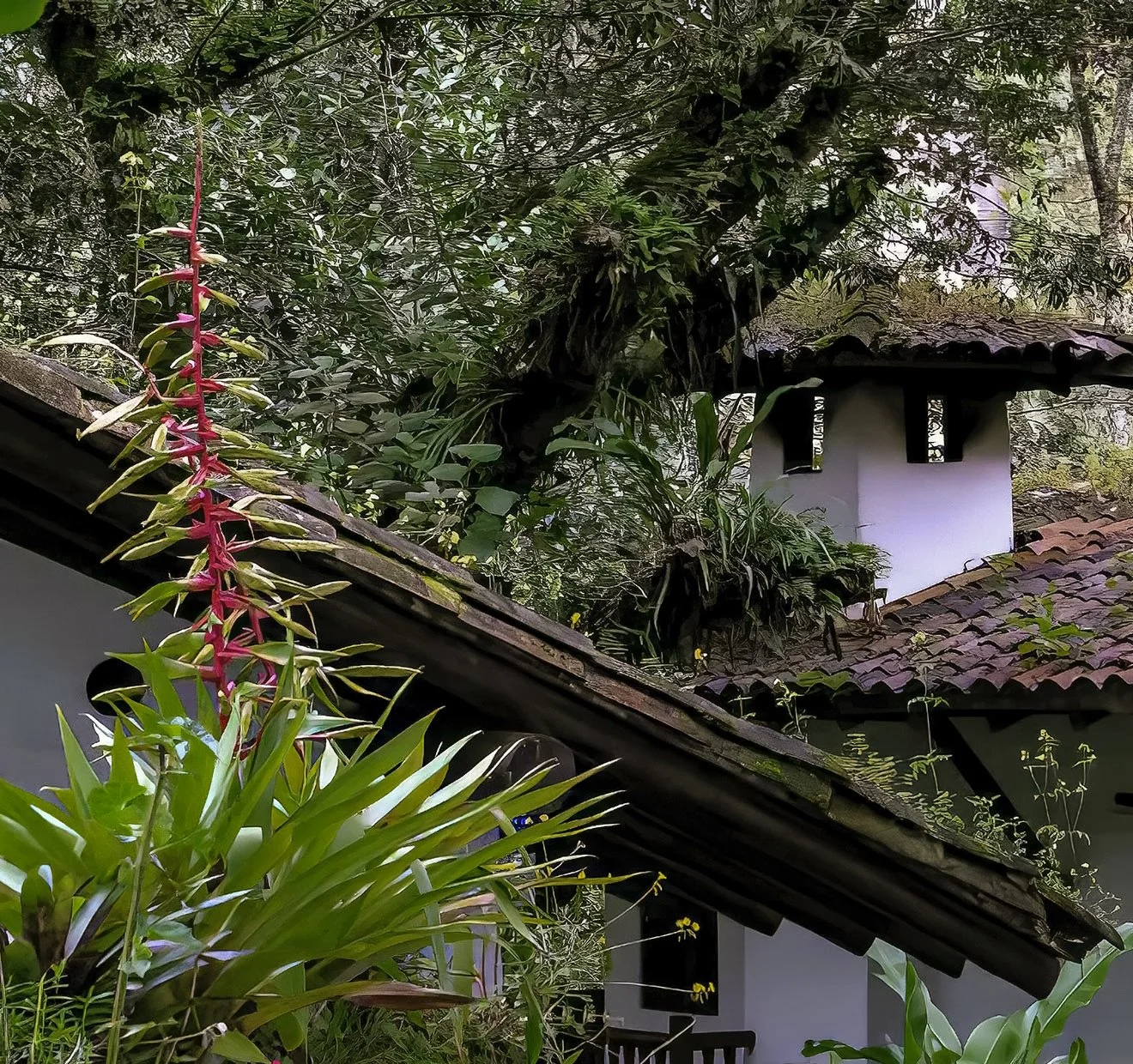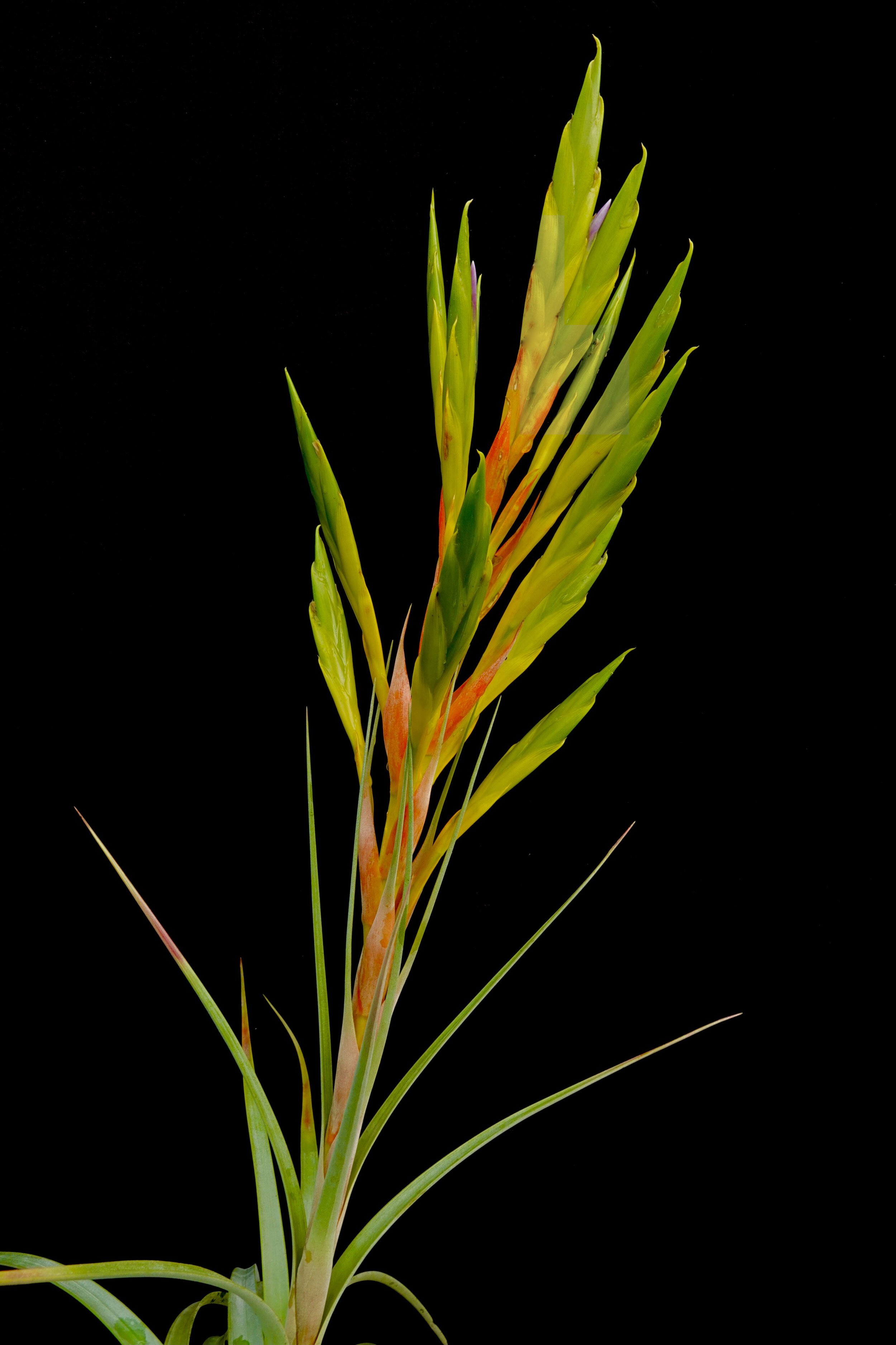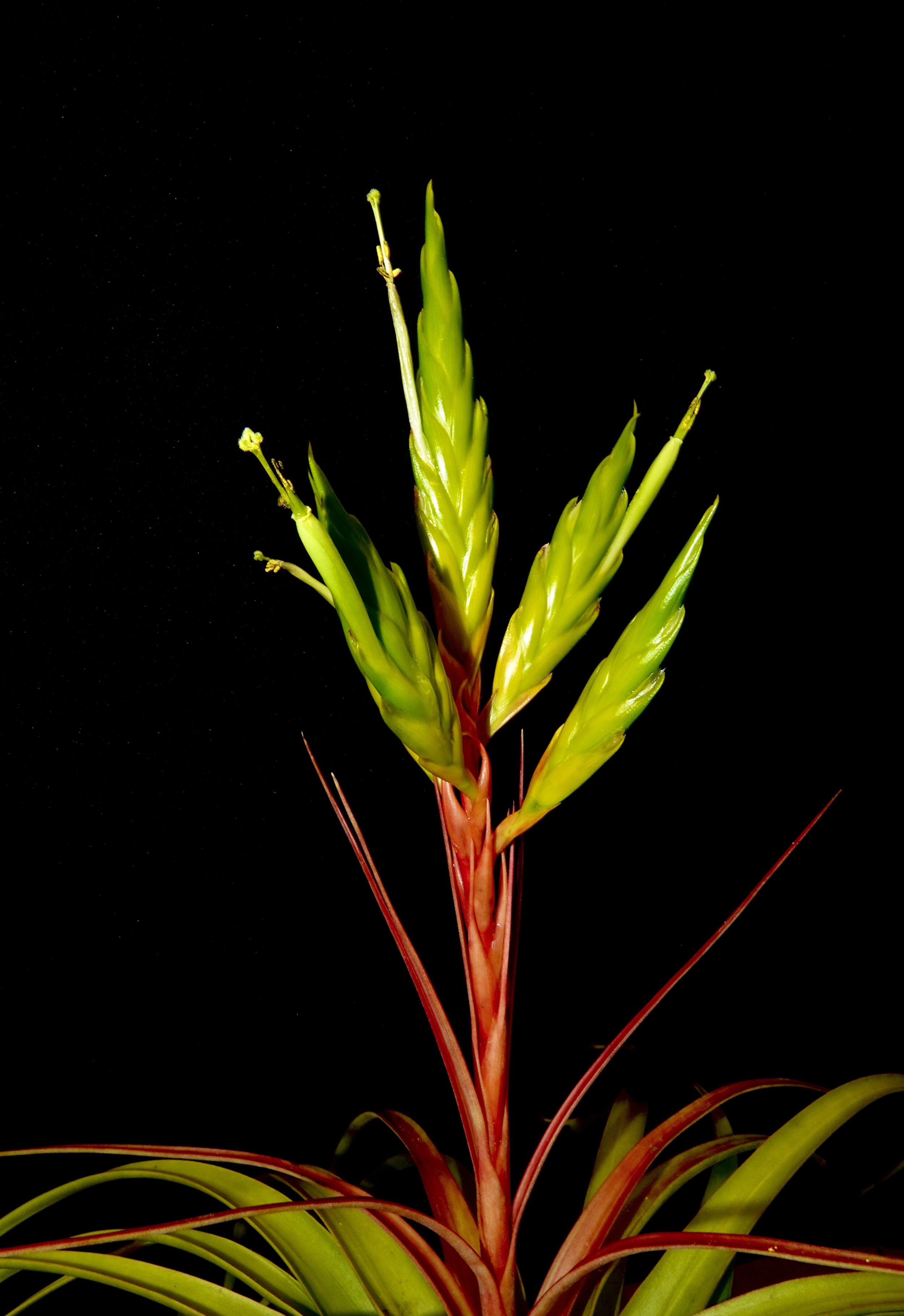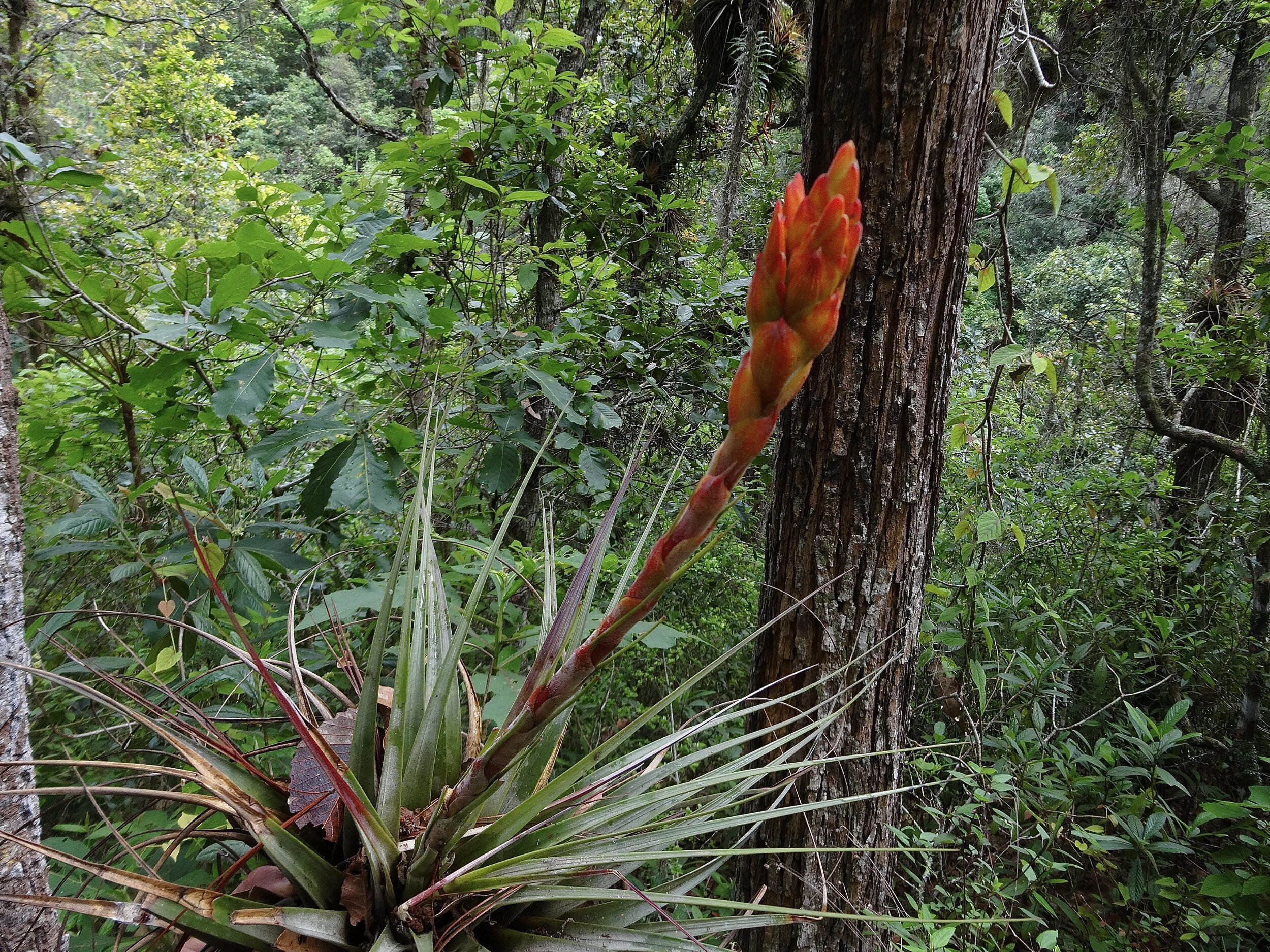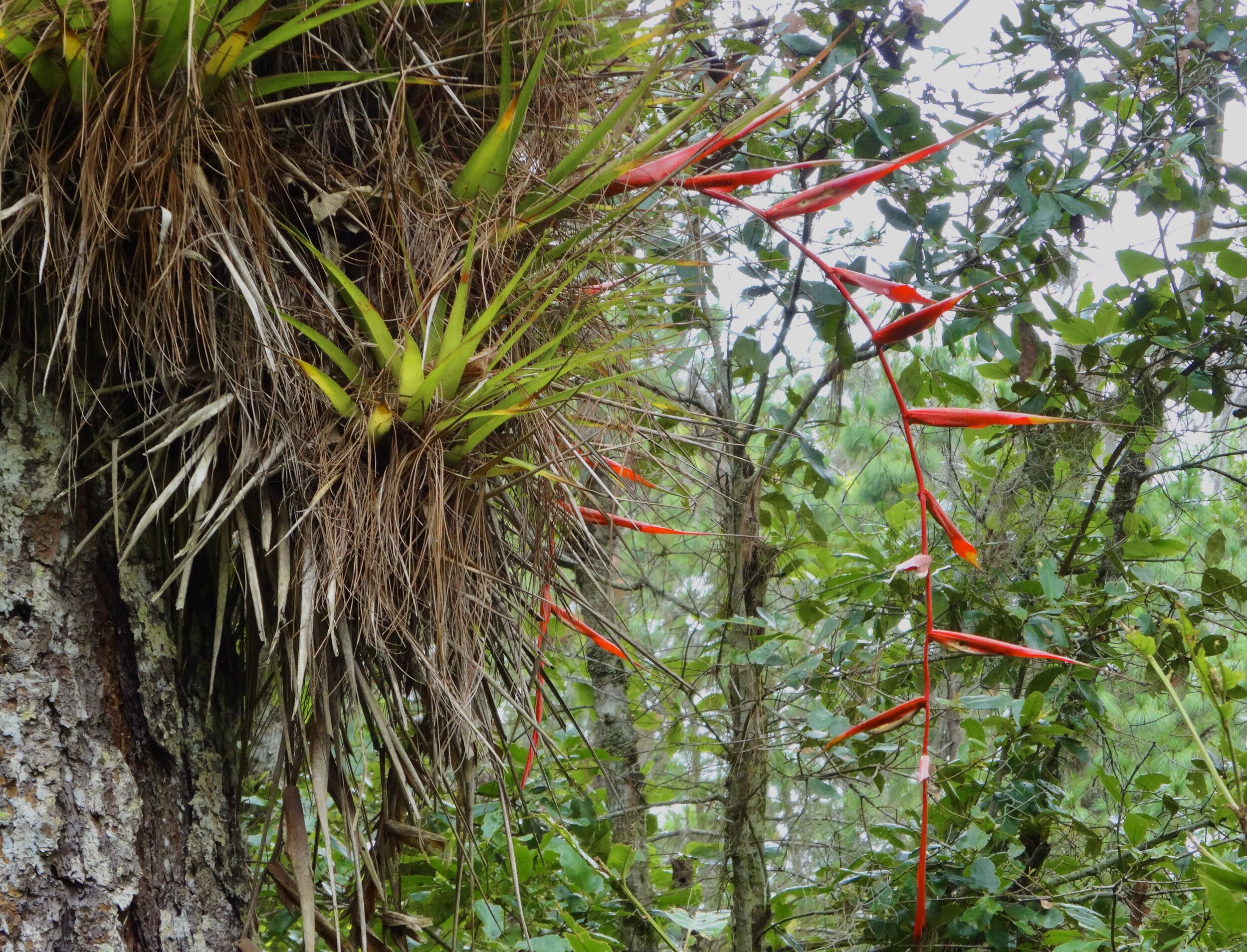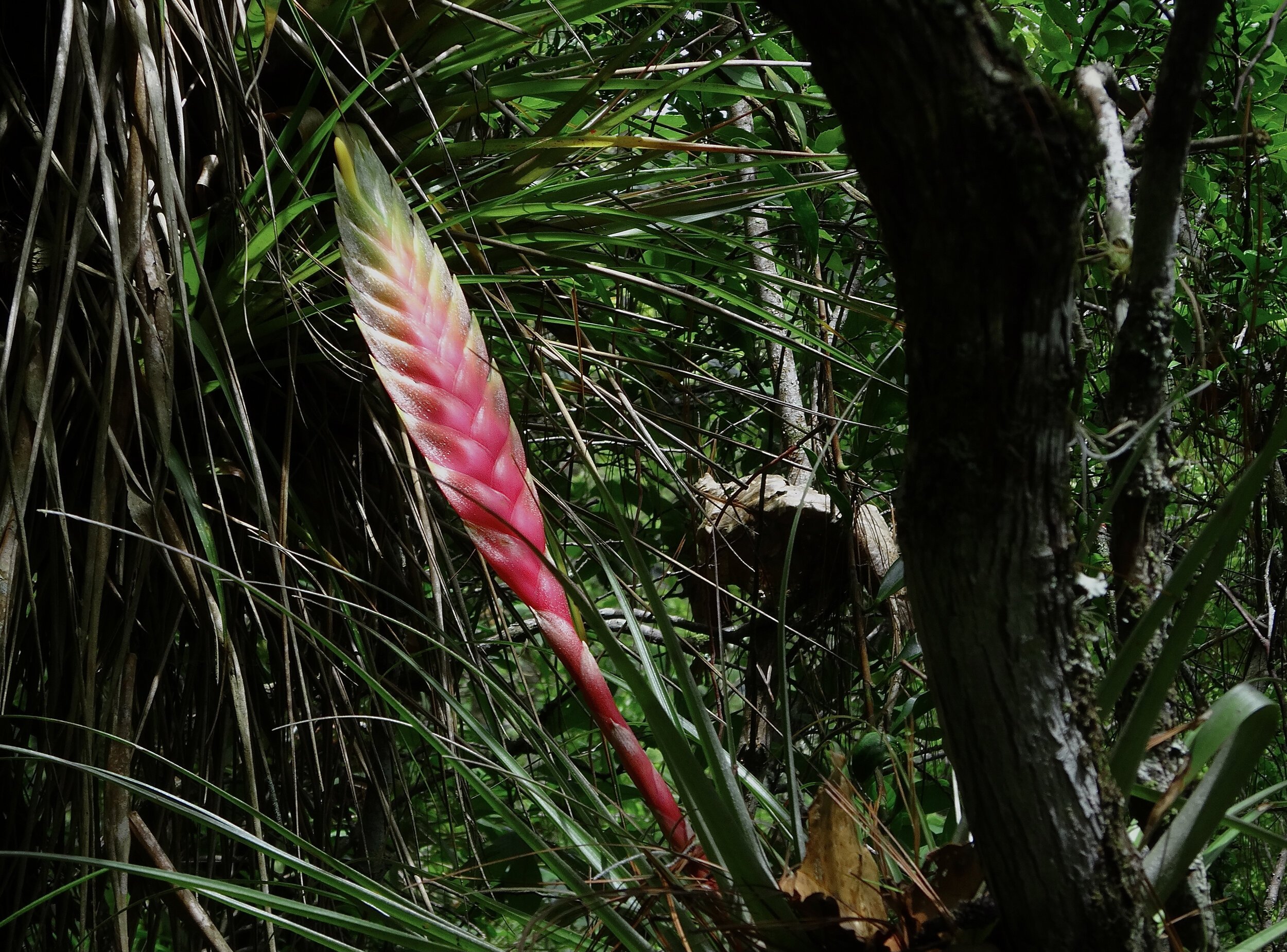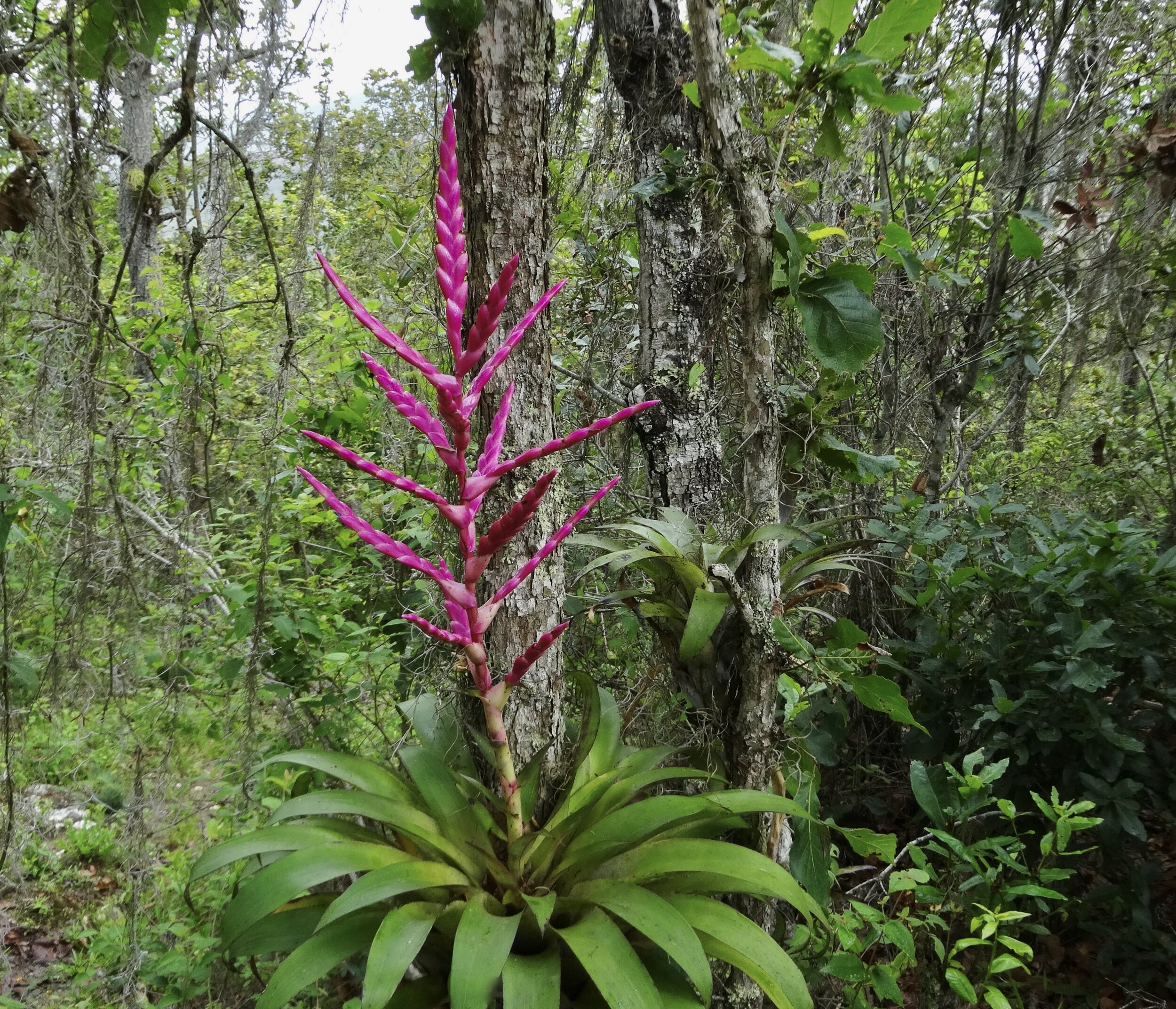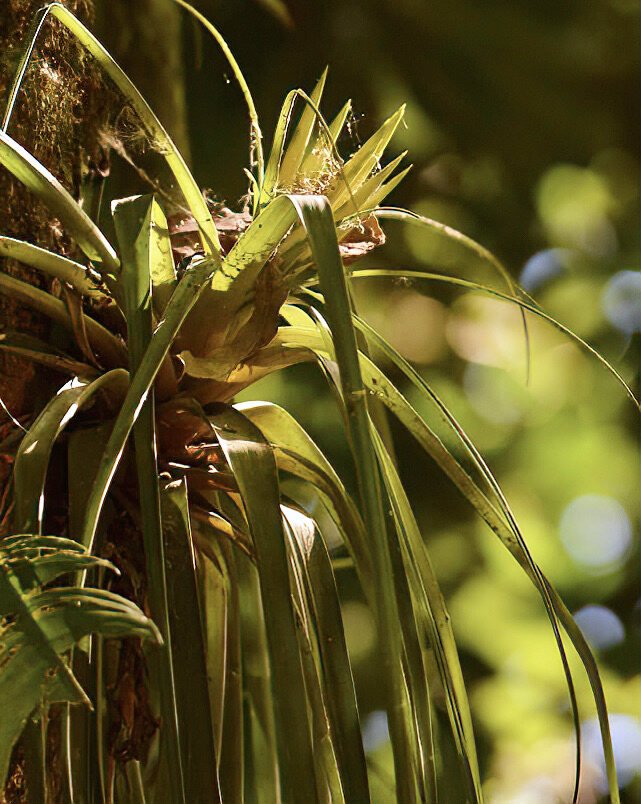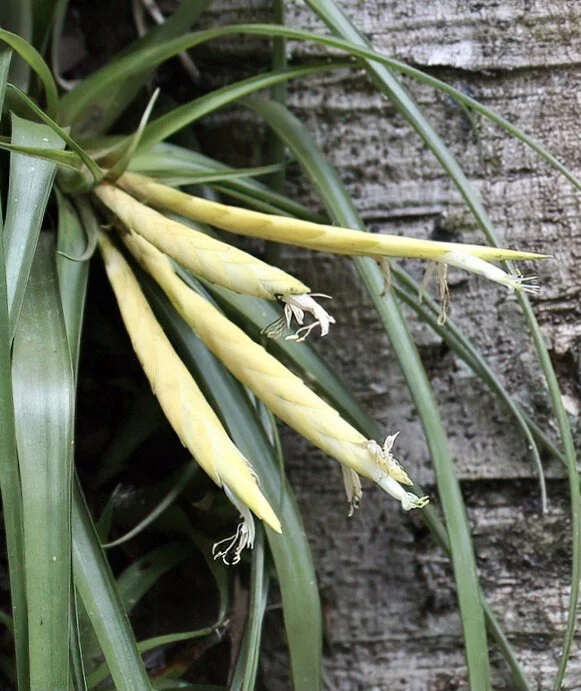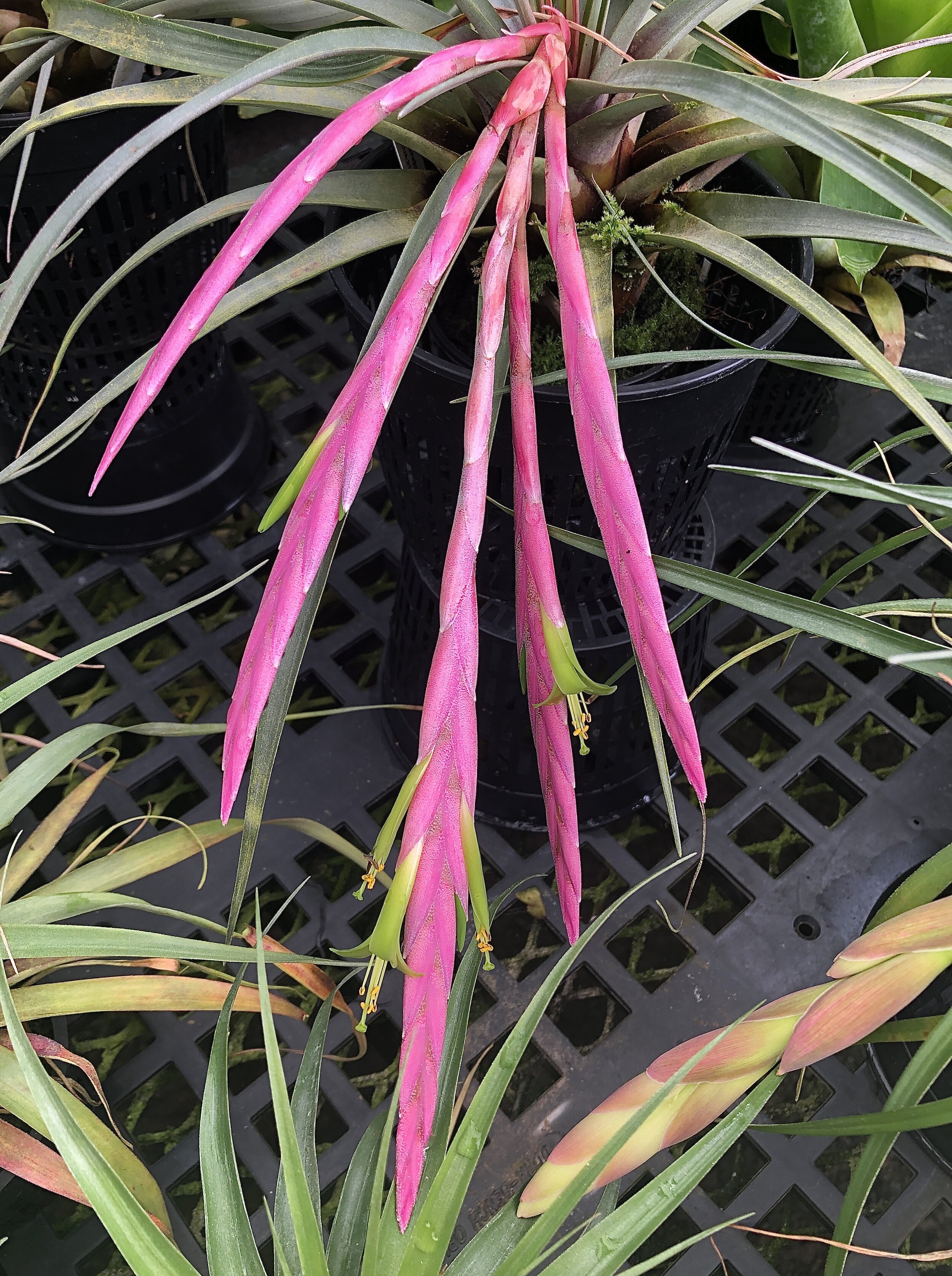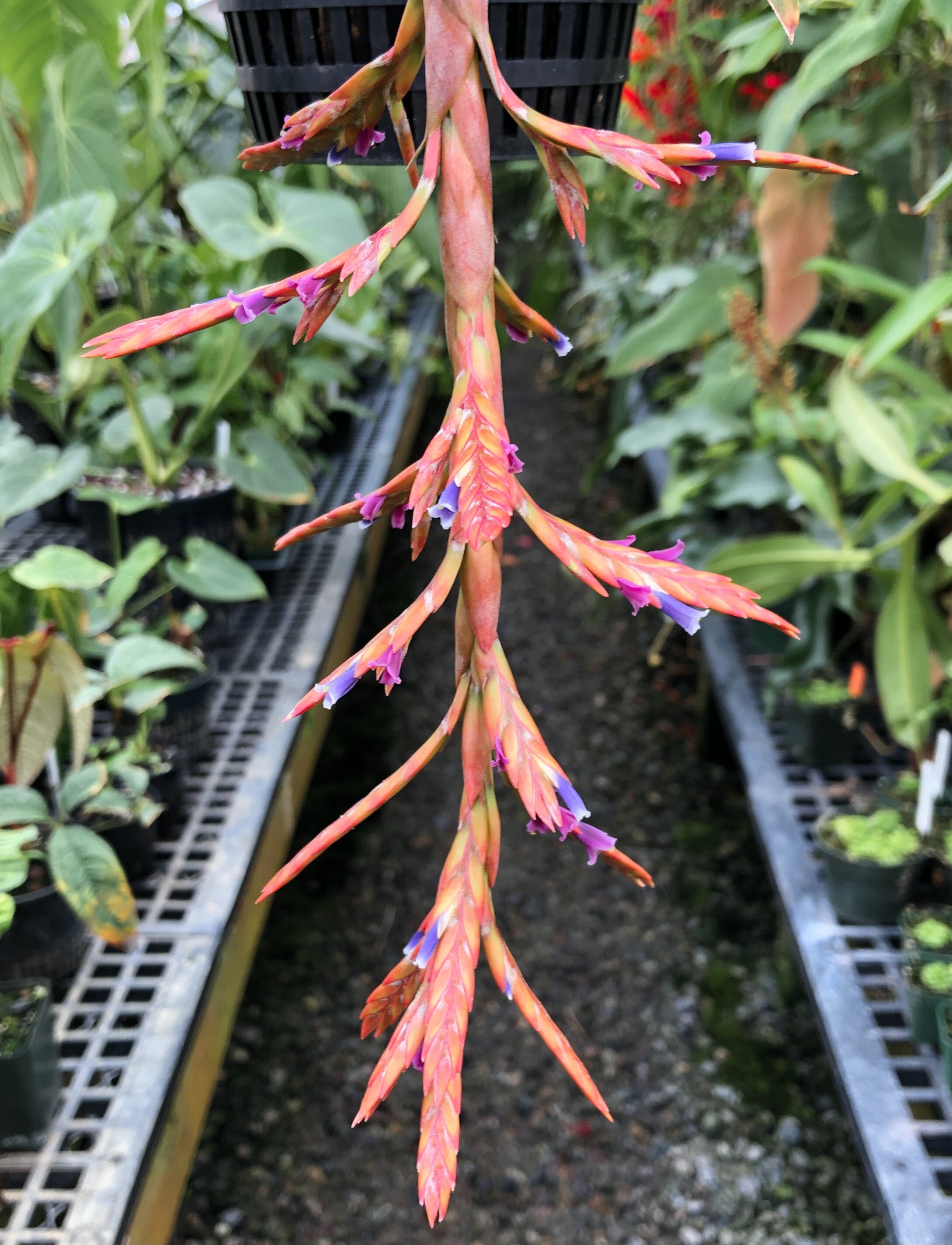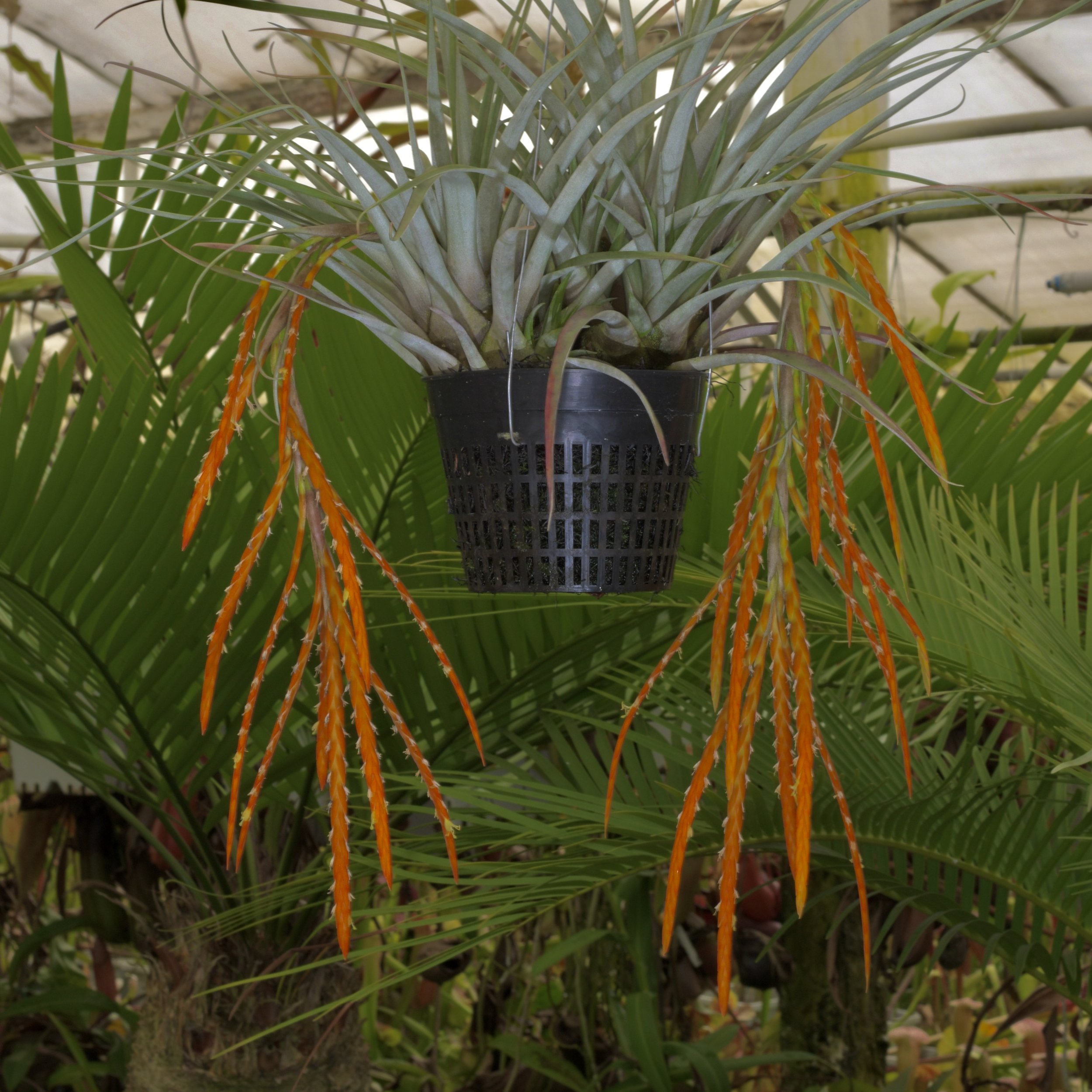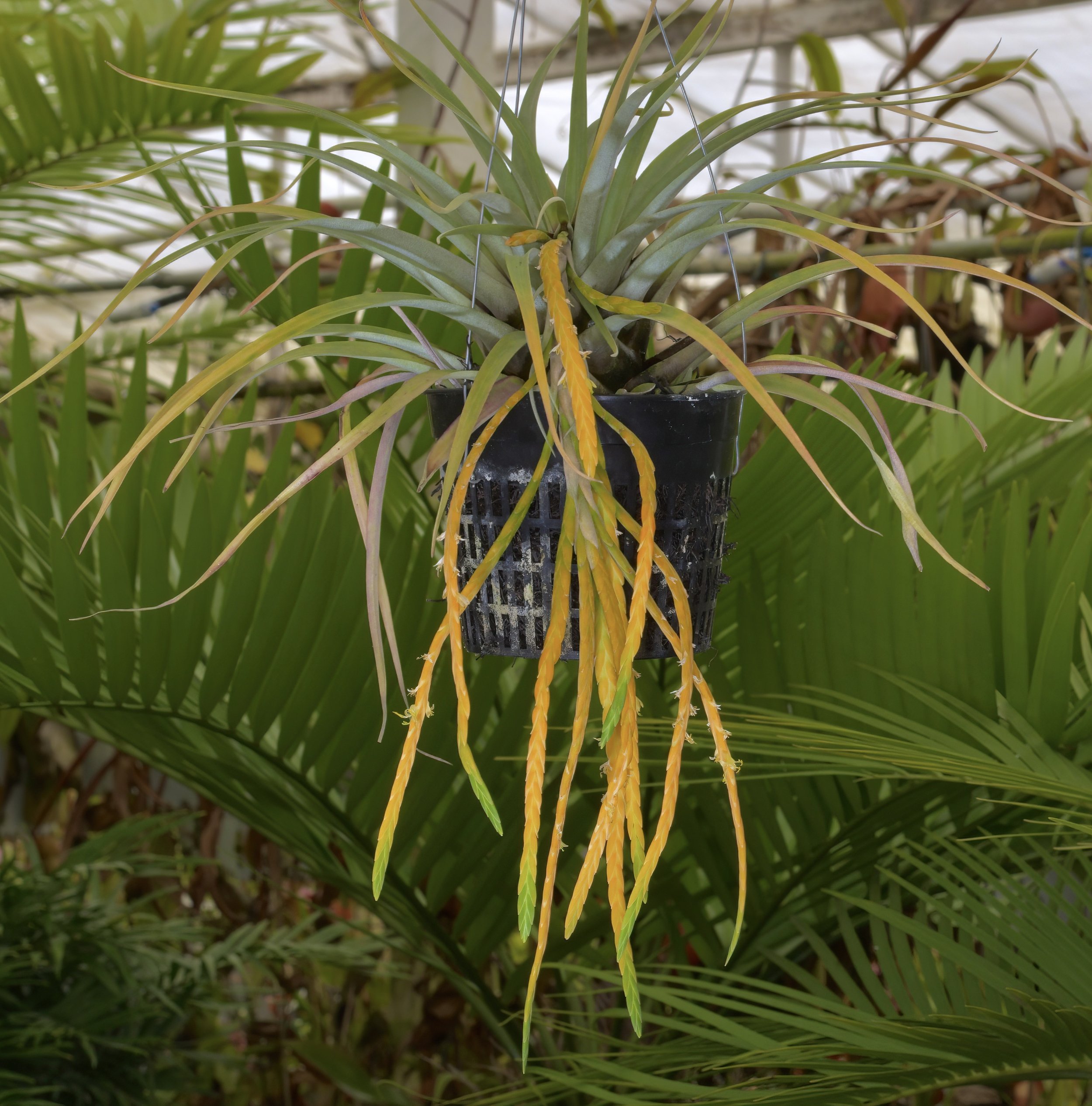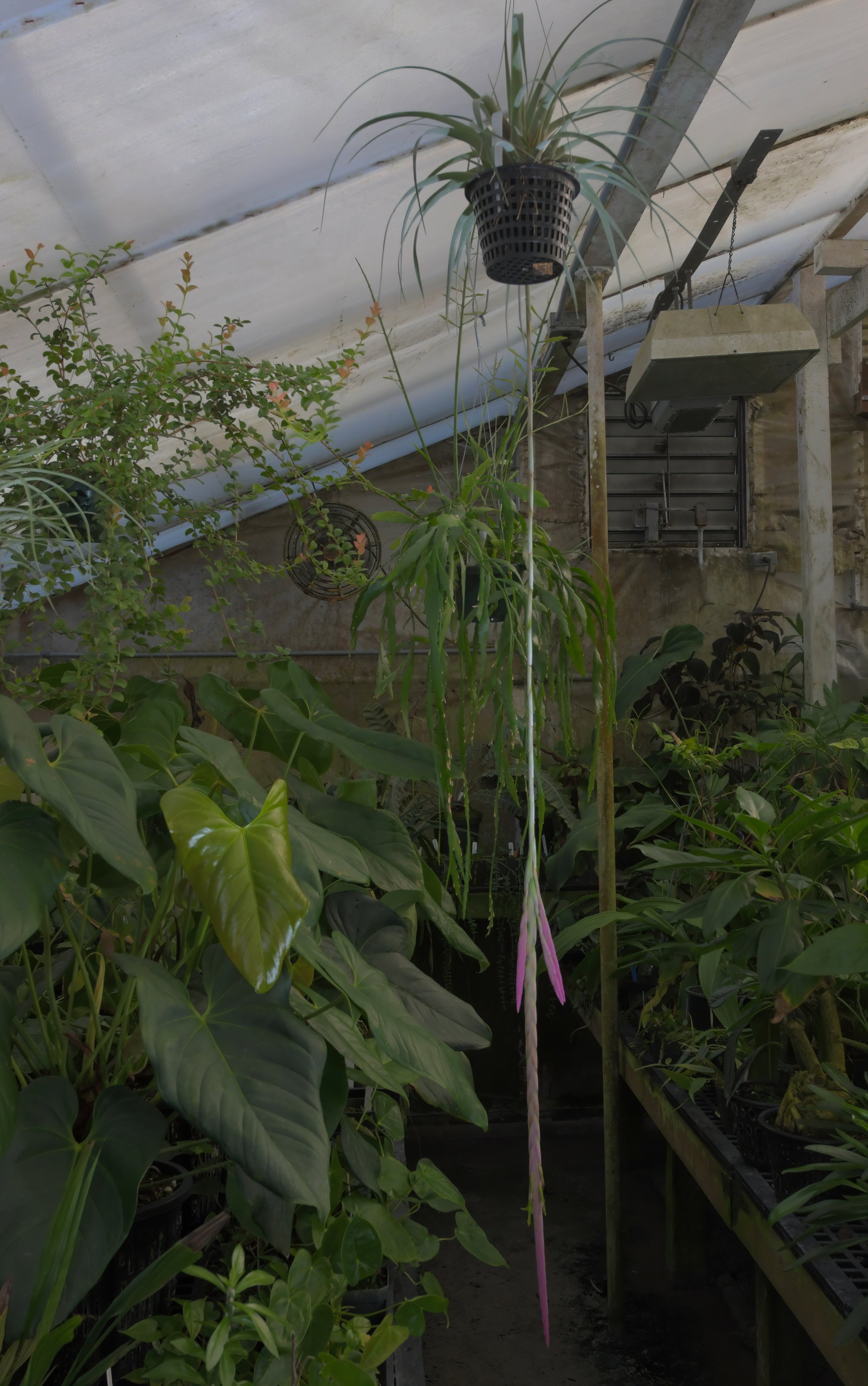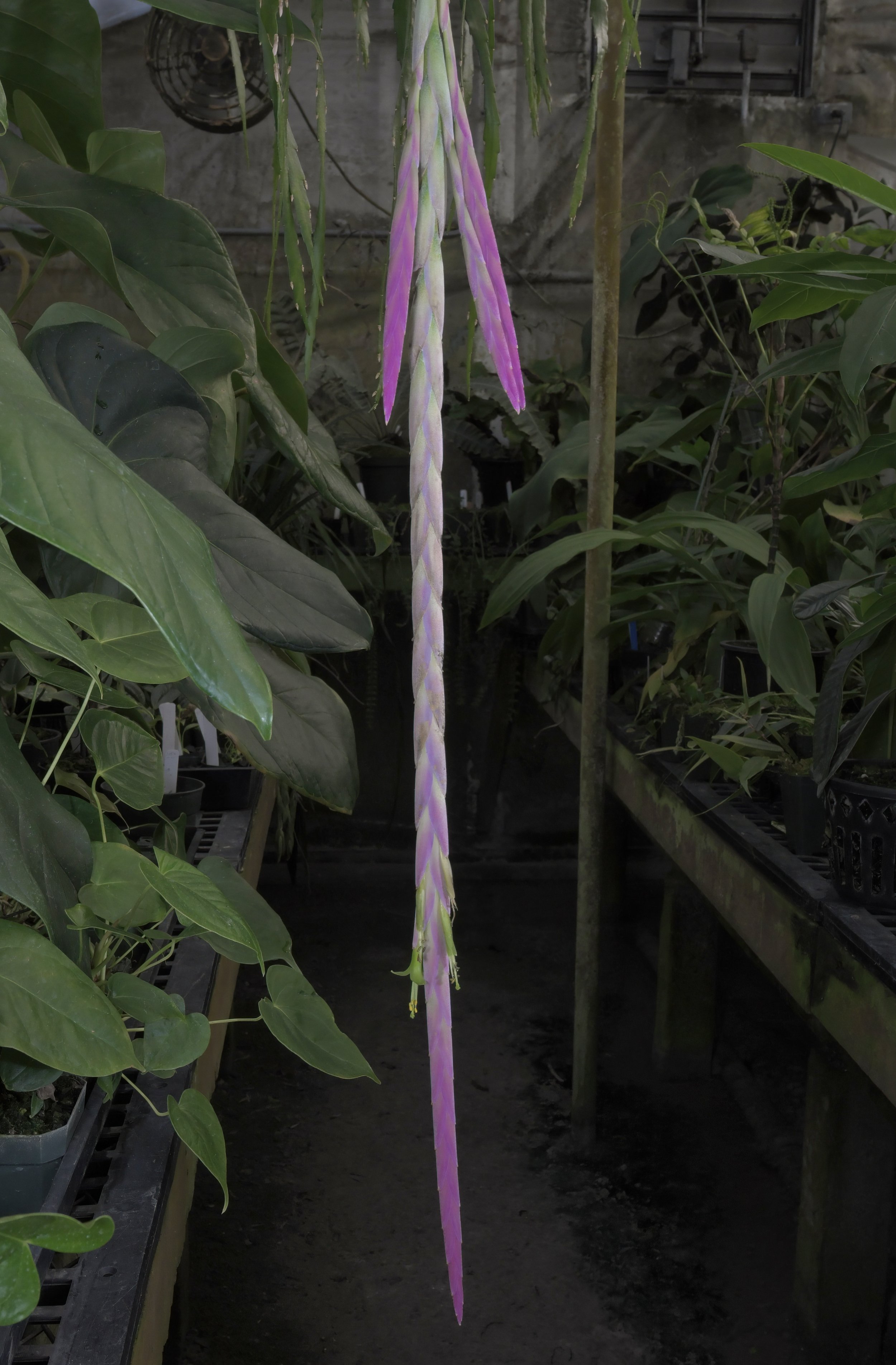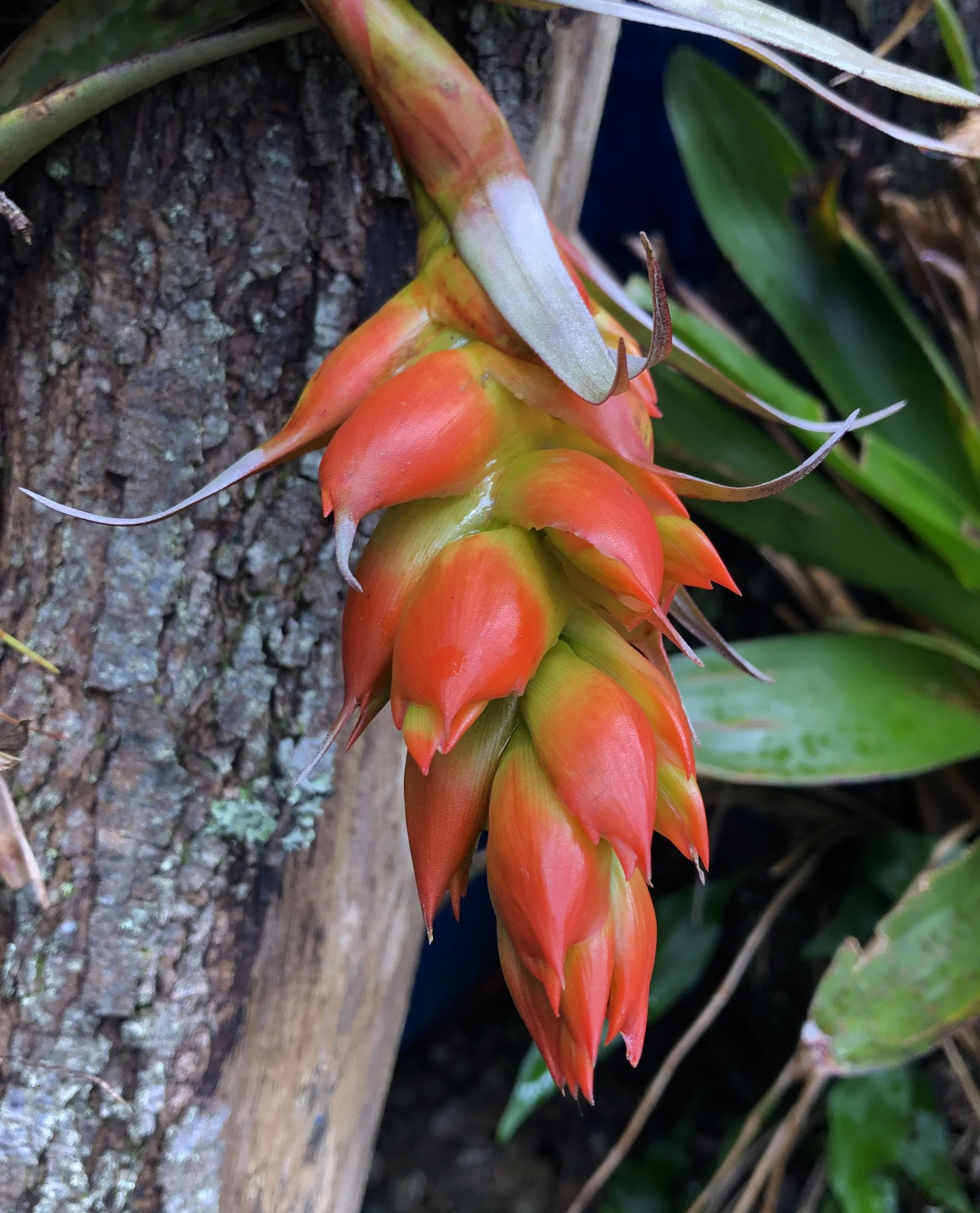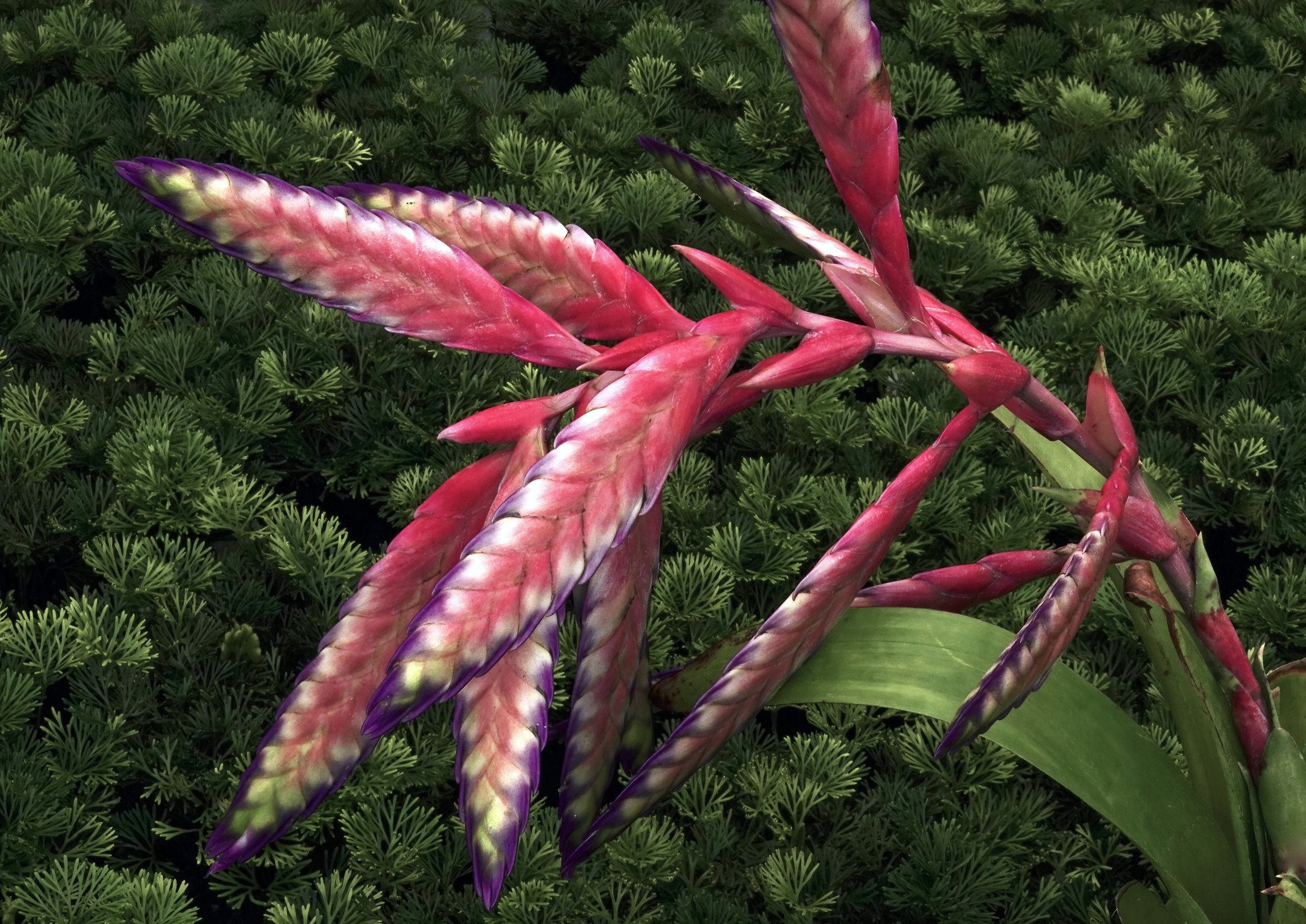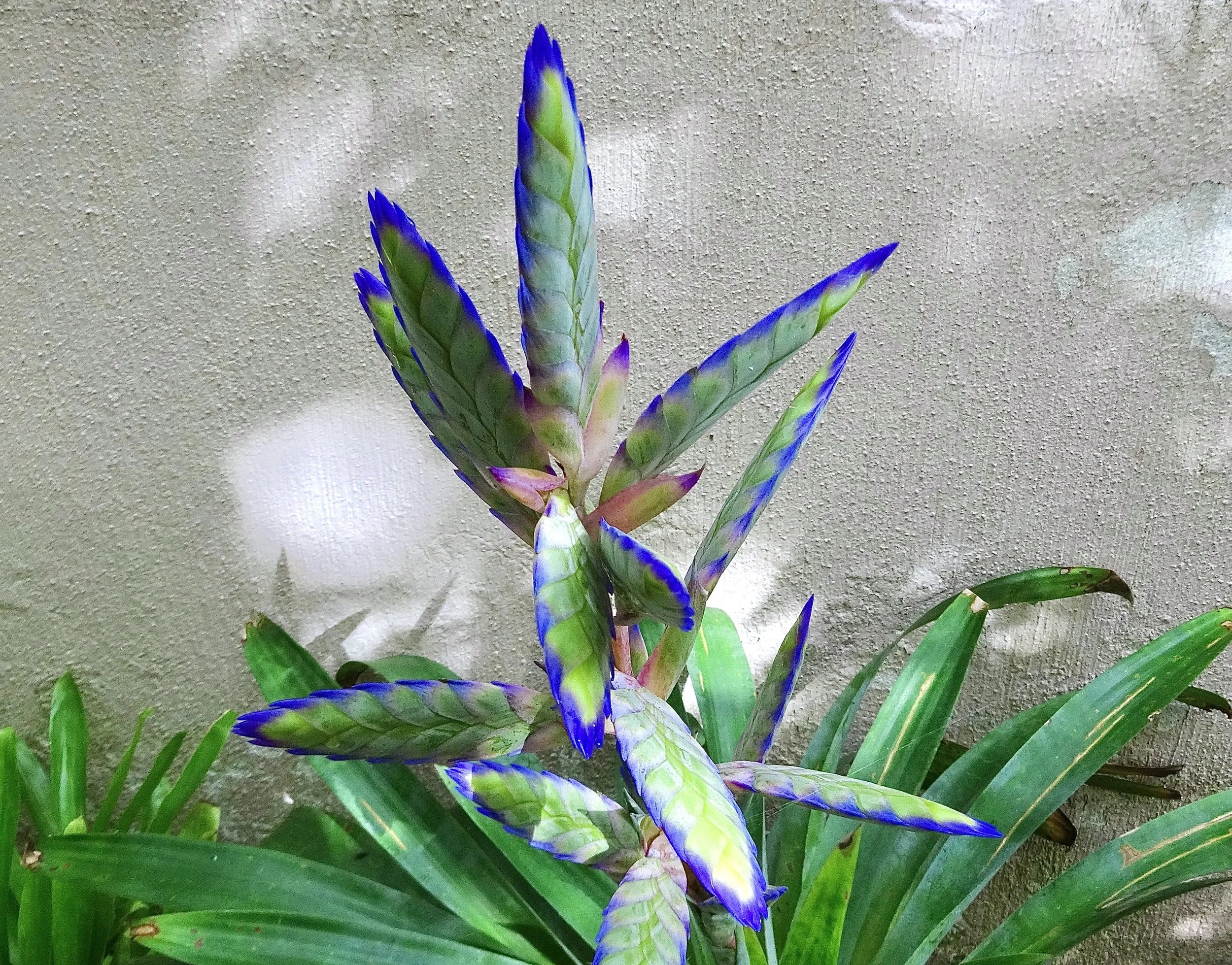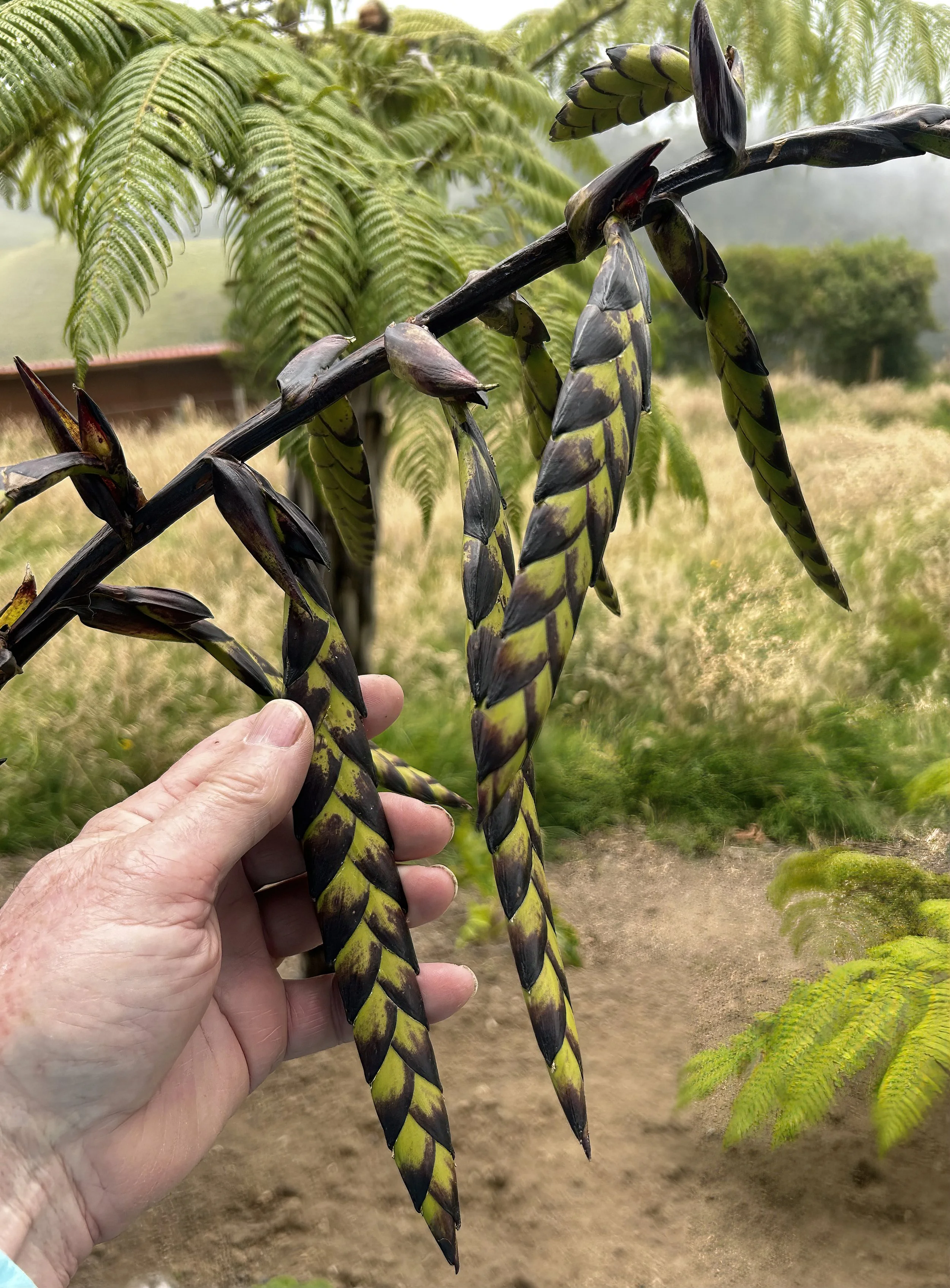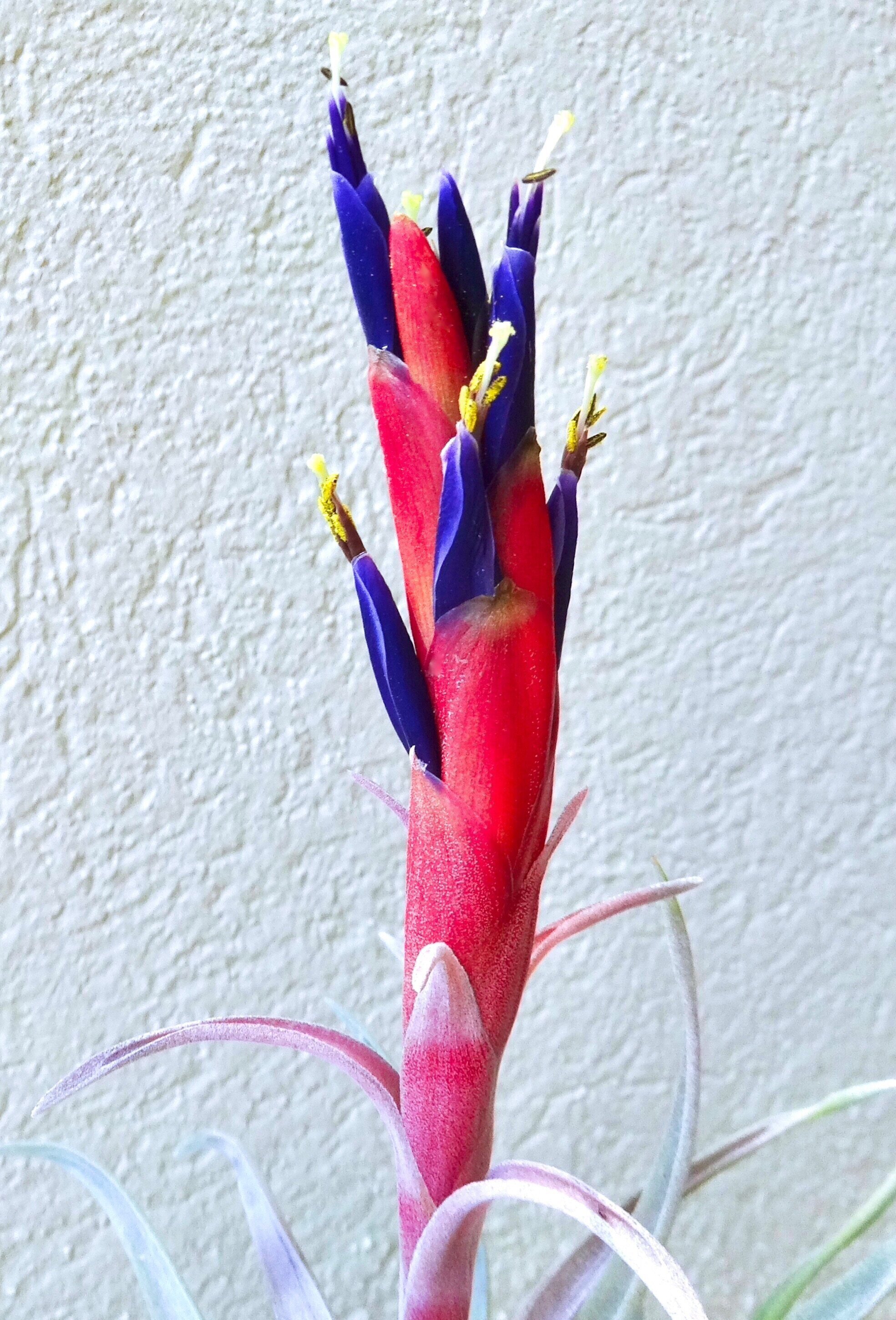La Élite de las Tillandsias - Out of the Curio Bin & into Desire
by Jay Vannini
A few minutes before nightfall, a massive cloud forest oak (Quercus sp.) is shown studded with flowering Tillandsia guatemalensis whose inflorescences appear to glow in stray shafts of light amidst the gathering dusk. This tree is growing in a communal cloud forest reserve in central Guatemala. After decades of over-exploitation for the local cut flower trade at Christmas, sometime around 1995 the local Quiché Maya community banned commercial harvest at this site. Recovery has been relatively swift, with all neighboring oaks carrying similar loads of mature plants. Author’s image taken in late 2021.
The global popularity of bromeliads as house, garden and conservatory plants has increased enormously since the mid-1950s. Over the past decades several have achieved near ubiquity as tabletop and windowsill décor items, as well as finding gainful employment in group plantings for advanced interiorscapes and as colorful display plants for events. For many years now they have been regular fare in florist shops, upscale supermarkets and garden centers. The best known of these include improved forms of the silver vase (Aechmea fasciata), scarlet star (Guzmania lingulata), flaming sword (Lutheria/Vriesea splendens) and the blushing bromeliad (Neoregelia carolinae). Those with glossy green or red leaves and showy inflorescences, together with gray leaf or atmospheric tillandsias, are collectively traded by the tens of millions of plants annually around the world (Linares, 2008; Negrelle, et al., 2012). Their relative ease of care, durability, long-lasting foliage and vivid floral bract color when in bloom has made a number of species and hybrids a leading choice for tabletop and terrace/patio tropical plants. Contemporary mass market hybrids, created mainly in the Netherlands, have largely displaced once popular species due to their fairly simple needs, eye-catching colors, clonal uniformity and very competitive pricing throughout the supply chain.
A high color Guzmania lingulata selection in the author’s collection. A very popular parent of many modern tabletop guzmania hybrids. Author’s image.
During the latter half of the 20th century ornamental bromeliads were produced commercially by nurseries scattered throughout the world. A steady flow of wild-collected material exported by local growers, visiting botanical garden collectors and dedicated plant tourists introduced a huge variety of showy new species to horticulture from remote, biodiverse regions of the Neotropics (Rauh, 1979). As economies of scale and scope became ever more important due to accelerating globalization in the early 21st century, technologically advanced breeding and production facilities for export are now concentrated in a handful of countries. Apart from traditional markets, flowering bromeliads are now also very popular in mainland China (P. Bak, pers. comm.; ProVerde, 2010-2015; van der Phloeg, 2020) although due to anomalies in reporting statistics the true economic dimension of the PRC trade remains a bit of a mystery (Niezen-CoHort, 2018). There is some commercial production of bromeliads in Australia, mostly on the east coast as well as in New Zealand, and rare tillandsias are prized among this region’s bromeliad and succulent plant collector communities (Bromeliads in Australia website; targeted online search by author).
Throughout tropical America bromeliads are also grown on a relatively large scale for the local houseplant and garden trade. Brazil, Colombia, Guatemala, Ecuador, Perú and Costa Rica all have commercial scale specialty bromeliad producers–including a few well-known collectors and breeders–that also export on occasion (e.g., Franz Gruber of Bromelias de Colombia and Chester Skotak’s Dura Flor). Ironically, quite a few Neotropics-based bromeliad nurseries also finish patented varieties from plant tissue culture that are bred in the Netherlands and now sold under license around the world.
Tillandsia is by far the most numerically diverse genus of bromeliads, with eight subgenera and over 750 species accepted at this time (Gouda et al. 2021, cont. updated). In addition, approximately 150 subspecies are recognized (Encyclopaedia of Bromeliads, Version 4), some of which may be elevated to full species status at some point in the future. Several very popular bromeliad species in cultivation formerly included in Tillandsia, notably T. dyeriana, T. cyanea and T. wagneriana have been moved, respectively, to the genera Racinaea, Wallisia and Barfussia (Barfuss et al., 2016).
Shown above, a series of very colorful Tillandsia flowers on commonly cultivated species; one now classified as a Racinaea. Most tillandsias are grown for their showy inflorescences studded with brilliantly colored floral bracts. As shown throughout this article, many have attractive flowers as well. Images: ©R. Parsons 2021.
Members of the genus are distributed throughout the southern U.S., especially Florida, then west from central Sonora state continuously throughout México, Central America and the Caribbean as well as throughout South America to south central Argentina on the Atlantic slope and northern Chile on the Pacific.
As was mentioned in an earlier post on this website that profiled the bromeliad genus Pitcairnia and as is the case with other speciose Neotropical plant genera, it is certain that the true number of Tillandsia species is significantly higher than current inventories suggest. Recent evidence of this is seen in areas of northern Mesoamerica that are generally considered to be well-surveyed by botanists e.g., Tropical and Subtropical Dry Forest ecosystems of the Central Mexican plateau, the Río Grijalva drainage of Chiapas, México and the Río Motagua valley and the Meseta Central of Guatemala that have produced many colorful surprises over the past decade or so, including T. religiosa, T. chalcatzingensis, T. tecolometl, T. carrilloi, T. tecpanensis and T. dicromantha (Ehlers & Lautner, 2011; Velíz & Feldhoff, 2013; Cárdenas et al., 2014; González-Rocha et al., 2015; Hernández-Cárdenas et al., 2020; Mó et al., 2021). Other attractive and interesting novelties have been discovered but not published or are expected to be found in the near future, especially in almost inaccessible montane areas throughout the genus’ range–in particular cloud forests of northwestern South America–that have yet to be systematically botanized.
Evoking images of several large Mesoamerican Tillandsia species that also have tall, bright red inflorescences, this magnificent T. maculata is shown in full bloom in the wet highlands of Morona-Santiago Province, Ecuador. Image: ©J. Raack 2021.
Undisturbed and selectively logged middle and upper elevation cloud forests across Mesoamerica and the Andean countries are very rich in Tillandsia diversity and numbers. Because of their size and often-brilliantly colored foliage, together with showy and long-lasting inflorescences, these plants can be conspicuous features in the landscape where they are common as canopy and cliff-dwellers or when they persist on isolated relict trees in pastures or towns.
A very strikingly colored form of the giant and somewhat variable Bolivian lithophyte, Tillandsia zizkae (formerly lumped with T. krukoffiana) growing on a steep cliff face near Villa Tunari, Cochabamba Department. Only one per customer, please. Image: ©C. Carter 2021.
The hardiness of the more common gray leaf or atmospheric tillandsias is a well-known attribute. They easily survive both lengthy neglect and the sometimes-harsh living conditions of modern interiors that would have had most other tropical houseplants long since consigned to the trash bin. Because of this and like some equally unfortunate mass-produced dwarf succulents, when sold as “air plants” they often end up glued to refrigerator magnets, as bathroom window tchotchkes, dangling as earrings, or languishing in random Etsy-crap, ad nauseum.
Tillandsia schiedeana is abundant in seasonally dry forests throughout Mesoamerica, much of the Caribbean and northern South America. Image: ©E. A. Mó 2021.
Their pedestrian side has sometimes led to the ubiquitous members of the genus in commerce being ignored as “lowbrow” by many rare plant collectors. To accomodate this view–which I admittedly subscribe to–we’ll leave taxa like Tillandsia ionantha, T. butzii, T. caput-medusae and T. filifolia to the Etsy and flea market sellers and proceed to focus on “La Élite”.
Most ornamental tillandsias sold in the U.S. today originated from stock imported from Guatemalan nurseries, which grow a wide assortment of both indigenous and non-native species (Linares, 2008; pers. obs.), and the EU (flasked starts or near-finished green leaf species and hybrids). Domestic production, centered mainly in California and Florida, also plays a major role in supplying large numbers of both unrooted offsets and finished plants for U.S. consumers.
The showy-flowered and compact Tillandsia globosa from coastal regions of southeastern Brazil is an excellent starter species for plant collectors interested in experimenting with the less commonly cultivated members of the genus. At the time of writing T. globosa is relatively inexpensive when offered as single rosettes from specialty bromeliad nurseries in the U.S. Author’s plant. Image: ©R. Parsons 2021.
Another of the attractive smaller species from southeastern Brazil that has recently become available from many mail order sources in the U.S. and the EU, Tillandsia jonesii (Strehl, 2000). Author’s plant and image.
Unlike the enormous global trade in gray leaf or atmospheric tillandsias, the market for green or maculate leaf species is relatively small and specialized. Dedicated collectors from U.S., Germany (especially), Holland and Australia have scoured the New World tropics since the 1950s seeking plants and seed of showy rarities for their collections. To some degree, the latter group of Tillandsia aficionados can now claim greater success growing what are considered challenging species than many of their U.S. counterparts. Indeed, the best all-round informational source on the taxonomy and cultivation of offbeat tillandsias is the Bromeliad Society of Australia’s website, “Bromeliads in Australia” (weblink provided at the end of this article). Despite the family’s growing popularity overall, interest in cultivation of genuinely rare bromeliads in the U.S. seems waning as many talented older collectors retire or die and other exotic plant groups come into vogue (pers. obs.).
Above, a very showy-flowered Tillandsia species growing in mid-canopy on mature oaks in an Andean forest relict at 9,100’/2,800 masl in Cundinamarca Department, Colombia. The white-tipped pink corollas shown in the image on the right are a nice touch. Author’s images.
From an ornamental horticultural perspective, the most striking and desirable Tillandsia species originate from three broad regions known otherwise for their high levels of local floral endemism: Northern Mesoamerican dry, subhumid and mesic habitats from Nayarit State, México through to western Honduras on both versants; the upland and Atlantic forest remnants of eastern and southeastern Brazil; and the subhumid and rainforest uplands of southern Colombia, Ecuador, Perú and Bolivia. Rather surprisingly Costa Rica and Panamá, despite their highly diverse bromeliad floras have contributed few tillandsias to the specialist trade, most notably T. oerstediana and T. kegeliana (a species that also ranges into northern South America), both of which are now in mass market production.
Seed grown giant form of Tillandsia oerstediana and a very colorful, select eastern Panamanian form of T. kegeliana in cultivation. Southern Central America has been remarkably stingy with showy Tillandsia offerings so far when compared to adjacent areas both north and south. Image left shown in a Guatemalan nursery, ©S. Palmieri 2021. Author’s plant and image shown right in California.
As outliers, a few Bolivian and northern Argentine species are also great things to have around the greenhouse or garden, especially the high color forms of Tillandsia lotteae, T. bermejoensis, T. edithae, T. rubella, T. krukoffiana, T. samaipatensis and T. australis. All are reported to grow well outdoors year-round in coastal California and parts of southeastern Australia.
Two giant Tillandsia species that are grown occasionally in specialty private collections and botanical gardens around the world. Shown flowering in nature on cliff faces in south central Bolivia. Image left, T. samapaitensis and right, T. australis. Images: ©C. Carter 2021.
Tillandsia machupicchuensis growing as a lithophyte at the Machu Picchu World Heritage Site, Cusco Department, Perú. Image: ©William W. Lamar 2023.
Another two very popular, compact Bolivian lithophytic gray leaf tillandsias with vividly colored inflorescences that are cultivated outdoors year-round in the author’s California collection. Left, Tillandsia lotteae and right, T. edithae. Tillandsia edithae has several distinct plant forms in cultivation, including the “spiky green” var. araucariifolia. Author’s plants and images.
México is justifiably famous for its remarkable bromeliad flora with 19 genera and over 430 taxa reported for the country (Espejo-Cerna & López-Ferrari, 2018). Oaxaca and Chiapas are the most bromeliad species-diverse states in México by a wide margin, with Oaxaca reporting almost 200 species in total and more than 50 locally endemic taxa. Tillandsia is the most numerically diverse bromeliad genus in the country, with its 230 species representing a whopping 30% of all currently accepted species in this genus (Espejo-Serna & López-Ferrari, 2018; Gouda et al., 2021). For its size, Guatemala is also remarkably rich in bromeliads with 17 genera and 155 species, including many noteworthy tillandsias (Dix & Dix, 2006; Dix et al., 2017; Vannini, 2018). The majority of the larger and most beautifully colored species indigenous to both countries are poorly represented in ornamental horticulture outside of the region. For reasons already mentioned, it is likely that the species numbers previously cited for both countries will increase substantially over the next decade.
It is a pity that almost all of the most beautiful Mesoamerican tillandsias from cloud forests require cool to cold night-time temperatures to thrive and a lot of space to due to their often-imposing mature size. Pure water in large volumes is also a must for many of them. Conversely, several of the more desirable subset of lithophytic and epiphytic species from Mexican Pacific coast Tropical Dry Forests (TDF) are fairly easy to cultivate under warm, subhumid conditions but are disinclined to offset unless the rosette apex meristems are carefully excised (i.e., "cored”) or they are chemically or extreme stress-induced to do so. Note: All three of these propagation techniques definitely involve not insignificant risk of loss of the mother plant, and this should be taken into account before embarking on experimentation with very rare forms. These species are also extremely slow and occasionally tricky to grow from seed. In both cases, the vivid foliage and inflorescence colors seen on these tillandsias in nature seem to elude most bromeliad growers outside of countries of origin.
A flowering group of a very colorful form of the wide-ranging Tillandia excelsa from a cloud forest locality in central Alta Verapaz Department in the author’s collection in Guatemala. This handsome green leaf bromeliad species produces large numbers of putative wild hybrids involving the sympatric T. guatemalensis and T. leiboldiana at several localities in central Guatemala. The hybrid swarms that are prevalent in these areas share key morphological characters of all three assumed parents. Because T. excelsa is relatively fast growing, very showy and offsets readily, when crossed with large, monocarpic forms of T. guatemalensis it is an excellent candidate for commercial-scale local projects looking to produce large numbers of cut flowers from seed grown plants to meet Christmas demand in Chiapas state, México and Guatemala. Authors’ plant and image.
Flowers have been an integral and continual part of the lives of the people of Mesoamerica for thousands of years (Granziera, 2001). Both the civilizations of the central Mexican plateau and the highland Maya in southeastern México and Guatemala are known to have used flowers in religious rites during the pre-contact period, and images shown in stonework, painted stucco friezes and polychrome ceramics associating flowers and deities are well-known. A very showy-flowered Tillandsia species from central México was recently discovered at an archaeological site adjacent to Olmec-influence petroglyphs that bear a very strong resemblance to flowering examples of this same plant (González-Rocha et al., 2015). Other uses for these bromeliads, including parts of several atmospheric tillandsias for medicinal purposes, have been documented by ethnobotanists working in the Neotropics (Bennett, 1990; Estrella-Parra et al., 2019).
Contemporary Mayan cultures continue to employ flowers to adorn their homes and any sacred site across the highlands of Chiapas states and Guatemala (Breedlove & Laughlin, 1993; Jiménez-López et al., 2016; Jiménez López et al., 2019; pers. obs.).
Above left: The 4-5’/1.25-1.55 m inflorescences of Tillandsia guatemalensis, shown above left for sale at a market in Antigua in 2019, are one of the most popular Christmas floral ornaments used to decorate homes and Nativity scenes in central and western Guatemala. Annual harvest figures certainly are in the hundreds of thousands of individual plants (pers. obs.), and this formerly widespread, abundant and large tank bromeliad is now largely restricted to relict populations in protected and inaccessible areas. Shown above right, a vendor’s basket filled with entire plants of T. punctulata together with fir branch wreaths. Images: ©S. Palmieri 2021.
Tillandsia prodigiosa in oak forests of Oaxaca state, México. This species is one of many south Mexican tillandsias harvested annually in large numbers for native floral displays. Image: ©F. Muller 2021.
The showy inflorescences of many tillandsias are widely used to adorn Nativity arrangements and fiestas in town plazas, cemeteries, chapels and churches throughout southern México and northern Central America (Foster & Foster, 1954; Williams, 1954; Haeckel, 2008; Jiménez López et al., 2019; pers. obs.). Together with Spanish moss (Tillandsia usneoides), almost anything local with a big, colorful inflorescence is popular or even a showy small whole plant in flower will do in a pinch. Favored species are T. guatemalensis, T. ponderosa, T. prodigiosa, T. lucida, T. imperialis, T. eizii, T. excelsa, T. punctulata, T. lampropoda, T. velickiana and T. ionantha. The inflorescences of the recently discovered and aptly named T. religiosa, believed to be a narrowly endemic lithophyte in Morelos state, is also harvested for use as altar decoration (Hernández-Cárdenas et al., 2014). This large scale, annual extraction of fully mature, flowering examples of these bromeliads from nature prior to seed release has had a devastating impact on their abundance over the past several decades as suitable habitat shrinks concurrently. Seedling recruitment was reportedly low in one study of a heavily harvested green leaf species in Chiapas state (Castro-Hernández et al., 1999), yet surprisingly rapid in another study that monitored xerophytic Tillandsia recolonization in cloud forest fragments in central Veracruz (Arcuña-Tarazona et al., 2015). Growth rates for larger tillandsias are known to be slow in both nature and cultivation (Hietz et al., 2002; pers. obs.). Many of these commercially extracted plants are well over a decade old. The removal of whole plants also has fatal consequences for their associated microorganisms, arthropod, reptile and amphibian faunas, some of which are considered threatened or endangered (e.g. Abronia lytrochila; Aranda-Coello et al., 2012). In one study that evaluated the illegal ornamental trade in epiphytic plants in Veracruz state, México two decades ago, a single floral arch adorning a single church in Coatepec in October 2001 utilized almost 2,600 wild-collected Tillandsia inflorescences, mostly T. multicaulis (Flores-Palacios & Valencia-Díaz, 2007; Haeckel, 2008).
Herpetofaunal (= reptile and amphibian) mortality associated with ornamental bromeliad collection for commercial trade was examined by Aranda-Coello et al. (2012) at a site in central Chiapas state. Their findings are especially alarming when one projects their documented bycatch losses of arboreal lizards, salamanders and frogs across the wider region. In another study undertaken in the early 2010s in the Sierra Norte of Oaxaca state (Cruz-Ruíz et al., 2012), the arboreal alligator lizard Abronia oaxacae was found living in the tanks of three medium to large Tillandsia species (T. calothrysus, T. prodigiosa and T. violacea). In a sample of 305 epiphytic, tank forming tillandsias that were examined, three individual A. oaxacae were collected. This relationship indicates that extraction of large numbers of flowering T. prodigiosa for the floral trade every year is having a negative impact on the arboreal alligator lizard populations and other associated herpetofauna in this region. Preliminary conclusions that can be drawn from these two studies in southeastern México, together with other casual observations made in Guatemala, suggest that the fates of many Abronia lizard populations are linked to the continued abundance of mature colonies of tank forming tillandsias in northern Mesoamerican cloud forests.
A fine example of Tillandsia multicaulis flowering as a single inflorescence with multiple branches in my California collection. These showy inflorescences are often over-harvested from nature for use as decorations in regional fiestas and religious events in southern México. Author's plant and image.
A procession carrying multiple inflorescences of Tillandsia eizii destined for use as ornaments in the main church at Jacaltenango, Huehuetenango Department, Guatemala. Smartphone image courtesy of and ©Manuel Trinidad Esteban Hernández 2020.
Most arboreal alligator lizards (Abronia species) are closely associated with large, tank forming bromeliads in both oak and mixed tropical broadleaf forests. Despite being harmless and some species threatened with extinction, they are widely believed to be venomous by rural people in southeastern México and Guatemala. Studies in Chiapas state indicate that many are killed on the spot when found during the plant collection process for the regional floral trade. Shown in this image, A. oaxacae, a species that has been collected alive from the tanks in several Oaxacan Tillandsia species subject to annual commercial harvest. Image: ©F. Muller 2021.
Flowering Tillandsia candelifera and related taxa, such as T. imperialis, T. ponderosa and T. yunckeri, are widely harvested for ornamental purposes in the region. This is a large epiphytic species, but is shown here growing as a windfall in the understory in high elevation cloud forest on Cerro Miramundo, eastern Guatemala where it is sympatric with the endangered alligator lizard, Abronia meledona. Author’s image transferred from a 35 mm slide.
As in México and despite annual harvest quotas assigned for the legal collection of several once abundant and widespread Tillandsia species in Guatemala, poaching from protected areas and private property continues unabated there (CONAP, 2020; pers. obs.). Particularly favored species have already been exirpated from some areas in Chiapas state (Toledo-Aceves & Wold, 2008). Current harvest rates across Mesoamerica are clearly unsustainable and lower impact alternatives to existing collection methods should be evaluated (Mondragón Chaparro & Ticktin, 2011). Compounding the negative environmental impact of this harvest, discarded bromeliads and plant parts are mixed with non-compostable holiday waste and end up in Chiapan and Guatemalan landfills (A. Ramírez, pers. comm.).
Brazil’s principal contribution to the Tillandsia species collectors’ market is in the form of ~18 mostly small gray, narrow leaf species with red floral bracts and pink-, red- or magenta-colored corollas, of which just over a half dozen–T. chapeuensis, T. gardneri, T. geminiflora, T. globosa, T. kautskyi, T. sprengeliana and T. sucrei–are now well established in cultivation outside of Brazil. These gems require humidity, good ventilation and careful siting to thrive. Despite having conspicuous trichomes these species mostly require shade and will languish under dry conditions and too-high light. Well flowered specimens of almost all are extremely attractive on miniature to compact plants. Once rather costly and rare in cultivation, a number are now readily available at reasonable prices from U.S. and EU bromeliad sellers. Several were added to CITES Appendix II in 1992 due to perceived commercial collecting pressures on wild populations in regional protected areas (Luther, 1994). Whether this traffic in wild plants was real or not, seed-grown plants propagated outside of Brazil were readily available from specialty nurseries by 2010 and are now commonly cultivated. They were removed from CITES regulated status in 2013, following a petition by the Brazilian environmental authorities (IBAMA).
Above, a half dozen of Brazil’s best and brightest grown by Ron Parsons and the author in California. Despite their compact size, this group of tillandsias (all in subgenus Anoplophytum) contains some of the most beautifully flowered miniature bromeliad species and are highly coveted by specialist collectors. Several are now available at comparatively modest prices. They are excellent subjects for growers with limited space.
Top row (L-R): Tillandsia roseiflora (RP) and T. sprengeliana (JV). Both images: ©R. Parsons 2021. Middle row (L-R): T. geminiflora and T. kautskyi. Lower row (L-R): T. globosa and T. sucrei. Lower four plants and images are the author’s.
A large group of Tillandsia ponderosa in high canopy, montane cloud forest, Jalapa Department, Guatemala. Author’s image scanned from 35 mm slide.
A mixed community of Tillandsia porphyrocraspeda, Racinaea species and other epiphytic bromeliad species on cloud forest edge in southeast Ecuador’s Podocarpus National Park. Image: ©R. Parsons 2021.
An exceptionally robust Ecuadorean form of Tillandsia cf. confertiflora with an inflorescence exceeding 40”/100 cm in length. Under cool conditions this species can maintain excellent floral bract color for over six months. Author’s plant and image.
Colombia, Ecuador and Perú all have exceptionally rich Tillandsia floras. Some of the most attractive Andean country origin tillandsias–mostly from cloud forests as well–were formerly placed in the genus Vriesea and are jokingly referred to by Australian and U.S. collectors as TVs (= Tillandsia-like Vriesea). These include three dozen “green” or grayish leaf species, mostly with pendent or arching inflorescences. In what I consider to be an uncommonly common sense move, these were transferred to the genus Tillandsia by Swiss botanist and bromeliad specialist Jason Grant almost two decades back. This change was not immediately nor universally accepted and to some extent still remains a tad controversial in some circles. See Grant (1993) for more on this. More recently, in a broader taxonomic revision all the plants in this group were placed in the new subgenus Pseudovriesea (Barfuss et al., 2016).
As is the case in Mesoamerica, a number of colorful Tillandsia species are used to adorn fiestas and Nativity scenes in parts of Ecuador and Perú (Bennett, 1990; J. Raack fide J. Manzanares, pers. comm.).
Emergent inflorescence on Tillandsia walteri, a showy bromeliad species occurring from southern Ecuador, south throughout much of highland Perú and into northwestern Bolivia. Image: ©J. Raack 2021.
Above, two showy-flowered TVs in the author’s collection. Left, twice-branched Tillandsia limonensis and right, T. sp. aff. hansonii. Many TVs share showy, lime green or black-striped corollas that contrast with pink, orange and red floral bracts. Author’s plants. Image left, ©J. Vannini 2021, right ©R. Parsons 2023.
Formerly uncommon in cultivation, over the past three decades–but especially since 2000–TVs have gradually become more available to German, Australian and U.S. specialist bromeliad collectors. This is largely due to the fact that for the past two decades Ecuadorean and Peruvian orchid nurseries began exporting a broader and more interesting selection of their native floras, including many attractive bromeliad novelties. Of late, some of the larger, showy lithophytes from high elevation habitats such as Tillandsia petraea, T. walteri and T. tequendamae have made it to U.S. and EU markets, mostly in the form of recent vintage wild-collected, nearly mature plants exported from Ecuador and Perú (pers. obs.). Despite their allure, few growers have the necessary environmental conditions required to succeed with many of these species when freshly plucked from habitat, so the most challenging taxa should best be left to experts or (better yet) in nature. As is the case with their high elevation cousins from Mesoamerica, good light and ventilation, cool night-time temperatures and pure water are key to succeed with them in captivity.
A few 20th century discoveries from the northwest Andes have showy but very unusually colored floral bracts. One of the earliest of these novelties was Tillandsia reuteri (Rauh, 1976) from Cajamarca Department in northern Perú. Exceptionally colored examples of this species have inflated pink or silvery floral bracts with blue to violet margins. The very striking Tillandsia raackii (Luther, 1991) from cloud forests in Zamora-Chinchipe Province in Ecuador has greenish white floral bracts nested in a dark, waxy foliage. A more recent discovery that has just entered very limited cultivation in the U.S. is the giant T. loxensis from Loja, Ecuador (Jaramillo et al., 2018) an extraordinary find with dark violet to almost carbon black floral bracts and violet flowers.
Two large Barfussia species. Above left, the spectacular artist formerly known as Tillandsia platyrhachis from Ecuador and Perú in my garden collection in Guatemala, and right, a nicely-branched, flowering specimen of the recently described Barfussia robusta (Gouda, 2021) from northern Perú growing in a cool greenhouse in California. Barfussia (T.) platyrhachis and several related species including B. (T.) wagneriana were moved to the genus Barfussia by Manzanares & Till in Barfuss et al. (2016). Barfussia is, in my opinion, a well-supported natural grouping of five closely-related species, but it will be interesting to see how sticky some of these recent-vintage genera prove when we have another round of “newer and better” tools available for molecular taxonomists to better determine relationships among this subfamily. A fresh subgeneric or sectional assignment is often less controversial/preferable (?) to erecting a new genus, but suffer from a lack of curriculum-building glamour. Author’s plants and images.
A uniquely-colored epiphytic species from upper elevation wet forests of Zamora-Chichipe Province of Ecuador, Tillandasi raackii flowering in my collection in California. Named after a well-known U.S. bromeliad collector who discovered it in 1990, it was described by Harry Luther in 1991. Some examples can develop even more attractive deep maroon-colored leaves when light intensity is high and temperatures cool. Author’s plant and image.
A colony of the large, widespread Tillandsia species, T. fendleri thriving in an urban environment at Armenia, Quindío Department, Colombia. Note the exploded seed capsules on the spent inflorescences of two of the plants in the center of the image with more on another pair upper right, along with the masses of wind-dispersed seeds and newly-germinating seedlings covering the branches of the tree they live on. Author’s image.
Collection management
An uncommonly cultivated small Tillandsia sp. from Cuba and Jamaica, T. canescens often have very strikingly colored inflorescences, with pale purple flowers at maturity. Author’s plant and image.
While by no means a specialty of mine, I am obviously a huge fan of the genus. At this time I cultivate just over 120 Tillandsia species comprising ~300 individual plants that include many exceptional forms. Because of the generally cool local growing conditions that prevail in coastal northern California, my collection is dominated by cloud forest Mesoamerican and Ecuadoran taxa but also includes some noteworthy species from Pacific versant Mexican TDF grown in a heated greenhouse or outdoors during the warmer parts of the year. Having had a chance to look much closer at the genus during the course of writing this article, I would say that my “wish list” of plants whose accession is within the realm of practicality extends to another 20 or so species, mostly central Mexican, south Ecuadoran and north Peruvian, some of which I have previously grown in Guatemala.
When the late and colorful plantsman Guy Wrinkle (d. 2013) still sold south Mexican TDS origin bromeliads out of his North Hollywood, California nursery, many of the more obscure and desirable Jaliscan, Guerreran and Oaxacan Tillandsia species were sporadically available to adventurous buyers. Since his passing almost a decade ago, most of the most coveted Mexican species in this genus now rarely appear on the U.S. market. Seed from uncommon Tillandsia species collected in México is offered by specialty seed vendors in Germany from time to time. Unless stored dry and below freezing, germination rates will vary between zero to very poor (pers. obs.).
Thick, virgin cork plaques for mounted plants and free-draining bark-based substrates for potted specimens are excellent choices for growing most of these plants. Fern fiber, from sporadic Guatemalan or Fijian exports together with sustainably harvested tree fern products from managed forests in New Zealand, as well as domestically harvested cinnamon fern/osmunda root, are all superb and very hard-wearing growing media that can last for more than a decade in good condition if used in baskets. Due to ready availability and fairly low cost in most countries of origin, carved tree fern pots are widely used to cultivate large Tillandsia species by bromeliad collectors throughout Central and South America. When success is critical and despite its high cost and sporadic availability, pure osmunda fiber is my default choice as a substrate for rare green leaf tillandsias. All of my most valuable species with phytotelma are housed in net baskets designed for hydroponics and potted in pure osmunda.
I do not use sphagnum peat in growing media for any bromeliad I cultivate–never have–and am not a fan of it as a substrate for epiphytes in general. While it is clearly a valuable component in soil mixes for terrestrial plants, I am increasingly opposed to its lavish use in ornamental horticulture. Most U.S. nurseries, botanical gardens and amateur growers seem to favor it still despite its many drawbacks, both environmental and horticultural. In their defense, it is is inexpensive, readily available and produces acceptable-looking mass-market bromeliads for plant sales tables, supermarkets and garden centers. After many years of trials, coir/coco fiber is also verboten around my place. Despite marketing claims to the contrary, in my experience it is usually salt laden on arrival so requires lengthy soaks and multiple water changes prior to safe use, and breaks down rapidly when kept permanently moist. In open baskets it definitely performs better than in closed pots, but coarse grade, composted conifer bark on its own is still a better option.
Three types of high quality fern fibers that are suitable for rare Tillandsia culture, all shown in 6”/15 cm baskets for scale. Left: Domestic osmunda root, middle: Guatemalan medium grade shredded tree fern, and right: New Zealand medium grade shredded treefern. Fern fibers are increasingly available from sustainably harvested sources. Author’s image.
I have also experimented with coarse diatomite (usagi) and medium grade Japanese pumice (hyuga) in plastic net pots as a substrate for a few lithophytic species from Mesoamerican TDF such as Tillandsia carrilloi and T. mitlaensis. Growth rates so far seem almost identical to plants of this species that I have mounted on cork plaques after a few years, but in my opinion the plants potted in hyuga + coarse conifer bark + charcoal (see image below) seem a bit sturdier overall. Specialty mineral substrates like these may prove especially useful for people who grow rare species sensitive to permanently saturated roots on crowded benches, rather than suspended on mounts or in open baskets. Chipped diatomite appears to be more popular among Australian than U.S. bromeliad growers. Pure, medium grade (~6-10 mm) well-washed pumice is a remarkably good substrate for growing or re-establishing many Tillandsia species that are prone to root rot.
Three additional useful substrates for potted lithophytic and epiphytic tillandsias. Left: Medium grade hyuga, middle: Medium grade hyuga + medium conifer bark and horticultural grade charcoal, and right: Multipurpose potted epiphyte mix comprised of fine and medium grade conifer bark, medium perlite, charcoal and New Zealand tree fern fiber. Hyuga may be substituted for the less expensive and significantly inferior coarsely chipped diatomite. Author’s image.
I use nutricote 10-10-17 + micros or blended 1:1 with 13-11-11 + micros (Florikan-NOT Scott’s osmocote) as a top dressing for plants in bark mixes and fern fiber. Cal-Mag Special 17-5-17 at 80 ppm N is fertigated as an overhead drench every two to three weeks during growth, always alternated with daily dousing of pure water that prevents unwanted accumulations of fertilizer salts. Foliar ferts are generally reduced in frequency of applications for flowering plants.
Cork plaques are excellent, long term mounts for Tillandsia spp. that are grown under drier conditions, such as this colony of T. edithae flowering during midsummer on my deck in California. This mount is fully exposed to the elements and more than a decade old. Under permanently warm, wet conditions, cork mounts are far less suitable since they will decompose after only a few years use. Author’s plant and image.
Recommendations for successful cultivation of cloud forest, elfin forest and páramo origin Tillandsia species
Tillandsia ponderosa is a large and iconic high elevation cloud forest bromeliad native to Chiapas state in México, Guatemala, El Salvador and western Honduras. It is often confused by visiting plant collectors and internet armchair taxonomists with T. yunckeri and T. candelifera. The seed-grown plant shown has been fully exposed in bright shade on my terrace in California for almost four years, during which time it has experienced multiple mornings with sub-freezing temperatures and many late summer afternoon spikes to well over 105° F/45.5° C with minimal damage to leaves. Like many of the larger Mesoamerican tillandsias, the very showy inflorescences on T. ponderosa retain excellent color and condition for more than eight months. Author’s plant and image.
Irrigation sources should provide fairly pure water, preferably with a slightly acid pH and TDS under 50 ppm being key. RO filtered and rainwater are excellent options.
Cool nights (= mid 40°s-low 50°s F/4.5-13° C) are definitely far more critical for success with upper elevation plants than cool days. Many of these apparently frail cloud forest CAM plants can shrug off occasional daytime temperature spikes to as high as 105° F/45.5° C, so long as they are well watered, shaded and nocturnal temps drop into the 60°s F/17° C at least (pers. obs.) when heat is extreme.
Plenty of natural light and constant, gentle air flow is also invaluable. Full morning sunshine is useful in enhancing foliage color, especially at higher elevations. All things equal, “hard” culture, unfiltered light, high UV exposure and cool nocturnal temperatures make for colorful leaves and inflorescences.
Properly formulated, dosed and scheduled fertilization is an oft-overlooked component of successful bromeliad culture. Simply put, the no-fert crowd, “Don’t know what they don’t know.” The one notable exception to regular feedings would be applicable to those species that require “hard” culture to really show off their leaf and inflorescence colors. This includes many Mesoamerican species from TDF or partially deciduous oak forests. Coming into bloom, light intensity for these plants should be gradually dialed way up, and foliar fed nitrogen and watering frequency promptly dialed way down.
Widespread leaf tip burn tells you something needs correcting at a very basic level. When I see this condition developing in my plants I find that it is a good “tell” that I’m doing something wrong, usually relating to water quality, watering frequency or something else at root-substrate interface.
Two seed-grown Tillandsia lucida coming into flower in the author’s California collection in late April. Bright light and cool night-time temperatures are required to achieve natural inflorescence color in many montane tillandsias. Select ecotypes of this species are among the most attractive of all the green leaf tillandsias. Author’s image.
Baskets (preferably suspended) are, in my experience, generally preferable to closed pots. Despite the admittedly iffy aesthetics, under high humidity and with proper nutrition, tillandsias of all sizes will root vigorously as well as grow and flower perfectly well–like many vandaceous orchids–in empty plastic and wooden baskets.
Above: One of the most unique and attractive bromeliad sports I have ever come across, an albomarginate form of Tillandsia guatemalensis grown and flowered from a wild-collected seedling and shown at a friend’s home, together with a near-flowering offset grown from a grass pup we tricked off that amazing plant, spiking in my collection in California in August 2023. This is one of the “giant”, monocarpic forms of the species, with the mature rosette exceeding 40”/100 cm in diameter. Due to the large amount of chlorophyll-free leaf tissue on this particular clone, it was exceptionally fussy and slow growing for the first several years. The mother plant shown left also produced a number of non-viable albinos, as well as a couple normal green, offsets. Full UV exposure in the mother plant shown left, versus greenhouse culture for the offset above right right explains the leaf color differences. Image left: anonymous, author’s image right.
Shown below in February 2024, and nine years after removal as a tiny offset from the plant shown above left, a vindication of having invested a considerable amount of time and effort on conserving this magnificent and unique clone for horticulture. Growing leaf-perfect Tillandsia guatemalensis to maturity can be a challenge anywhere, but this one was particularly difficult to succeed with. Final dimensions 42”/108 cm across the rosette’s leaf tips and 48”/122 cm from the base of the plant to the apex of the inflorescence. Author’s plant and images.
A well-flowered Tillandsia fendleri growing in the garden of a private residence in Aguas Calientes, Cusco Department, Perú. Image: ©William W. Lamar 2023.
ELITE TILLANDSIAS - SPECIES OF NOTE
Regions of particular interest are identified below, and the tillandsias from them that I believe are worth a close look by specialist collectors are marked with an asterisk (*).
Species I currently grow or have grown in the recent past are highlighted in bold text. I have excluded many desirable undescribed or newly-described taxa I am familiar with that–as far as I am aware–by and large have not entered cultivation outside of their countries of origin or outlier collections.
Trust me but feel free to verify via web search if you don’t. Everything listed below are very nice-looking plants.
Two Mesoamerican Tillandsia species from Tropical Dry Forest (TDF) flowering in the author’s collection. Above left, putative wild hybrid of Tillandsia xerographica of Guatemalan origin, mislabeled in commerce as T. tomasellii. Above right, the very handsome compact form of T. roland-gosselinii from coastal dry forests of southwestern México. Under warm, dry, bright conditions the exposed foliage on this species and the closely related/conspecific T. rothii can flush bright red. Author’s plants and images.
Western Mexican TDF and subhumid foothill forests (Jalisco, Guerrero, Oaxaca and Chiapas states)
Tillandsia callichroma, T. jalisco-monticola, T. lomae-blancae, T. macdougallii, T. mirabilis*, T. mooreana, T. pamelae*, T. roland-gosselini*, T. rothii*, T. sierrahalensis, T. supermexicana*, T. thyrsigera*, T. tomasellii, T. trauneri, T. werner-rauhiana* and T. xerographica*.
Highlands (mostly) of Puebla, Veracruz, Oaxaca, Chiapas states, Guatemala and Honduras, mesic pine-oak and tropical broadleaf forests
Tillandsia atroviolacea, T. atroviridipetala, T. beutelspacheri*, T. bourgaei*, T. carlos-hankii*, T. candelifera*, T. chlorophylla, T. coalcamensis, T. deppeana (some forms)*, T. eizii*, T. excelsa*, T. fasciculata (exceptional local color “forms”)*, T. flavobracteata*, T. foliosa*, T. flabellata*, T. grossispicata, T. guatemalensis*, T. gymnobotra, T. harrisii*, T. imperialis*, T. kretzii, T. lautneri, T. lampropoda, T. leiboldiana*, T. lucida*, T. macrochlamys, T. malzinei, T. mateoensis, T. mixtecorum*, T. multicaulis, T. nervata, T. orogenes, T. nuyooensis*, T. oaxacana, T. ponderosa*, T. prodigiosa, T. juerg-rutschmannii*, T. standleyi*, T. subteres, T. tecpanensis, T. tricolor, T. verapazana*, T. violacea*, and T. yunckeri*.
A gallery of showy central Guatemalan cloud forest tillandsias in pine-oak succession at a selectively logged private reserve in Baja Verapaz Department. Clockwise from upper left: Tillandsia rotundata, T. standleyi, T. lucida, and T. lampropoda. Author’s images.
Above, images of the newly described (July 2021) Tillandsia atitlanensis from middle elevation cloud forest on Guatemala’s central Pacific slope. Together with T. hintoniana from Guerrero State in México, these species are almost unique in the genus for its combination of cream-colored bracts and white flowers in non-alba form plants. Images: ©José Monzón-Sierra 2021.
Tillandsia eizii flowering in Chiapan cloud forest. This spectacular bromeliad species is endemic to high elevation forests southeastern México and western Guatemala, with a disjunct population in southwestern Honduras. Image: ©Fred Muller 2021.
Tillandsia lautneri, a high elevation specialty from montane cloud forests of eastern Chiapas and western Guatemala, photographed near the type locality in Huehuetenango Department, Guatemala. Plants in commerce traded under this name in the U.S. bear little resemblance to plants at this site. Author’s image.
A colorful dwarf form of the widespread and variable Tillandsia leiboldiana flowering in cloud forest of Baja Verapaz Department, Guatemala. These compact individuals, heavily spotted with violet or red, were formerly referred to as var. guttata or T. sparsiflora. Since populations of this handsome plant form pop up sporadically across the range of T. leiboldiana from Chiapas, México through to central Costa Rica, it is unclear whether all should be lumped under this name. This particular population has rosettes that mature between 6-8”/15-20 cm in diameter. Author’s image.
Colombian, Ecuadorean, and Peruvian mesic foothill, cloud and elfin forests
T. andreettae*, Tillandsia barthlottii*, T. brevilingua*, T. buseri, T. confertiflora, T. confinis*, T. cylindrica, T. engleriana*, T. flagellata*, T. fragrans*, T. hansonii*, T. incurva*, T. ionochroma*, T. kentii*, Tillandsia kickae*, T. limonensis*, T. loxensis*, T. lutheri*, T. maculata*, T. (B.) moorei, T. penduliscapa*, T. petraea*, T. (Barfussia) platyrhachis, T. porphyrocraspeda, T. pseudo-floribunda, T. raackii, T. renatae, T. restrepoana*, T. rhodosticta*, T. (romeroi) gruberi, T. sagasteguii*, T. stenoura*, T. superba*, T. tequendamae*, T. turneri*, T. violascens*, T. (B.) wagneriana*, T. walteri* and T. wurdackii*.
Another pair of attractive, compact sized TVs shown above. Left, a high color form of the widespread Tillandsia incurva and T. aff. heterandra. Author’s plants and images.
A selection of potted, maculate leaf tillandsias and racinaeas being grown a bit too shaded in the author’s collection. Tillandsia ionochroma flowering center. Author’s plant and image.
Two floral bract color forms of the southern Ecuadorean and north Peruvian cloud forest TV, Tillandsia barthlottii. This fairly compact species is very rewarding in cultivation; easy to grow and easy to flower with long-lasting and brightly-colored inflorescences when grown cool and bright. Author’s plants and images.
Tillandsia cf. myriantha growing on emergent branch in high canopy, Cundinamarca Department, Colombia. Author’s image.
Above, an exceptional example of Tillandsia penduliscapa from central Ecuador flowering in the author’s collection in California. This amazing species, closely related to the better-known T. limonensis (shown earlier in the article), has one of the longest inflorescences in the genus. Shown here at 65”/1.67 m in length from the rosette cup, it will continue to elongate through final flower emergence. While the inflorescence is usually simple, this clone has three branches off the base of the section containing showy flowering bracts. Despite its rarity in cultivation and exotic appearance, this species is surprisingly compact in terms of plants size and easy to grow, although it clearly needs plenty of height for proper growth. Author’s image, plant ex-Jerry Raack.
Tillandsia turneri var. turneri, Cundinamarca Department, Colombia. Image: ©Jay Vannini 2024.
Above, two ecotypes of the showy Tillandsia reuteri from cloud forests at intermediate elevations of southern Ecuador and the Cajamarca Region of northern Perú. As is evident here, both inflorescence colors and plant size vary substantially across its range, but floral bracts all share pure blue to violet outer margins. This lovely bromeliad thrives under cool, bright conditions but is reportedly water quality-sensitive in cultivation. Author’s plants and images.
An attractive, compact, cool-growing Ecuadorean TV species circulating in the trade and (with reservations) tentatively identified as Tillandsia portillae. This plant shares leaf and floral characters from both that species and some forms of the closely related T. porphyrocraspeda. Its taxonomic status remains uncertain. Author’s plant and image.
Bract details of a windfallen Tillandsia franciscii in a private garden at ~10,500’/3,200 masl in Caldas Department, Colombia. A giant montane bromeliad species that is visually similar to its more familiar relative, T. clavigera, it is unlikely to thrive in collections outside of origin. Image: ©Jay Vannini 2024.
Clusters of Tillandsia tequendamae growing mid-canopy in high elevation cloud forest near the type locality in Cundinamarca Department, Colombia. The bract color of plants in this area varies from orange to deep red. Pendent inflorescence aside, this widespread species is superficially similar and closely related to the plant identified in the a previous image as T. sp. cf. portillae. Author’s image.
Tillandsia sp. aff. restrepoana, lowland rainforest in western Colombia, cultivated in the Tropicario at the Bogotá Botanical Garden. Author’s image.
Inflorescence of a beautiful, newly-described southern Ecuadorean bromeliad, Tillandsia renateae Gouda, Manzanares & Raack 2021. A somewhat variable, high elevation cloud forest species that is in limited cultivation in the EU and U.S.. Author’s plant and image.
Brazilian Atlantic tropical mesic forest relicts
Tillandsia brachyphylla, T. chapeuensis, T. geminiflora*, T. globosa, T. heubergeri, T. kautskyi*, T. reclinata,T. roseiflora*, T. sprengeliana* and T. sucrei*.
Hybrids in nature and cultivation
Tillandsias have long been known to hybridize promiscuously in their native habitats both within the genus or even outcrossing to Guzmania monostachia in at least one case (x Guzlandsia barbiei). An exhaustive compilation of putative natural hybrids is published online by Gouda & Butcher (cont. updated) and lists almost 190 taxa. This trait is especially noteworthy in some of the Mesoamerican species such as Tillandsia fasciculata, T. brachycaulos and T. capitata, as well as Tillandsia complanata and T. argentina in South America (Gouda, 2020; Gouda & Butcher, cont. updated). In most cases elsewhere, putative wild hybrids are generally considered local or uncommon in nature (e.g., T. x floridiana and T. x smalliana in Florida - Luther & Benzing, 2009).
Older pasture on foothill primary wet forest edge in Morona-Santiago Province, Ecuador. There are large numbers of conspicuous epiphytic bromeliads, principally Tillandsia species, that persist on almost all the isolated trees visible in the foreground. Rain and cloud forest-associated bromeliads that manage to survive harsh conditions on isolated trees in degraded habitats are still valuable stores of germplasm. They can generate both pollen and wind-dispersed seed to establish new individuals in adjacent habitats. Land management practices in the Neotropics should promote the conservation of epiphyte-laden trees in pastures and parks. Note that, despite their narrow trunks, many of the mountain cabbage palms (Euterpe precatoria var. precatoria) shown center to right retain heavy bromeliad loads. Image: ©J. Raack 2021.
Having worked with this genus along the length of the bromeliad species-rich Río Motagua valley in central and eastern Guatemala from the mid 1970s onwards, I hypothesize that wild hybridization is accelerating due to habitat degradation and loss and that this phenomenon is likely widespread across fragmented ecosystems in the Neotropics.
Flowering Tillandsia carrilloi in the author’s collection. Full exposure to several hours of direct morning light and cool nights appears to enhance color in both this species and the closely related T. zacapanensis.
The diverse flora of the upper and middle Motagua valley in Guatemala was subject to the twin evils of unregulated, wholesale commercial bromeliad, cactus and orchid collection as well as widespread deforestation of its very biodiverse arid and TDF ecosystems first in the late 19th century (Ossenbach, 2009) and then from the early 1970s into the early 2000s (pers. obs.). That was when the first real efforts to halt relentless ornamental plant poaching and safeguard tracts of lightly disturbed dry forest in private areas located in the valley were initiated by local conservation authorities. In the interim two Guatemalan Tillandsia species, T. xerographica and T. harrisii, ended up on CITES Appendix II in 1992 because of rampant harvest of wild stocks (Luther, 1994). For a variety of reasons, my interaction with the flora and fauna in this area was more or less constant from 1975 onwards into the mid 2000s. I can personally attest to the rapid, massive population declines due to overcollection of some bromeliad species–esp. T. xerographica, T. streptophylla, T. zacapanensis, T. capitata, T. harrisii and T. ionantha–that occurred while large scale wild collection was unchecked from the 1970s through to the late 1980s. This activity, coupled with deforestation and annual wildfires, left many once abundant regional Tillandsia taxa reduced to small, widely scattered populations hanging on in largely inaccessible or overlooked forest fragments in the foothills and upper elevation canyons. A recently described lithophytic species from an adjacent connected subhumid corridor (T. carrilloi) was also heavily exploited from its sole known roadside locality in subdesert habitat in the Chiquimula Department in the late 2000s and into the last decade before being grown at scale from wild-collected seed in Guatemala and the U.S. (Véliz & Feldhoff, 2013; pers. obs.). Fortunately, like T. harrisii and T. xerographica this very attractive plant, while still costly, is now readily available from commercial production in Guatemala and one source in the U.S. (pers. obs.).
Synchronous flowering among Tillandsia species existing in close proximity favors the creation of wild hybrids. Above T. excelsa and an orange-bract form of T. lautneri blooming in montane alder (Alnus sp.) forest in Huehuetenango Department, Guatemala. One good example of this type of syntopy is shown above. While the inflorescence development of these two are not quite in sync, other individuals of both species growing in adjacent trees were. Author’s image.
Two closely-related and endangered atmospheric tillandsias from seasonally dry cliff faces at middle elevations of northern Central America. Left, a brightly colored form of Tillandsia harrisii and, right, a pink blushed spike on a choice T. hondurensis clone. These species are now produced in large numbers from seed and offsets in nurseries around the world, eliminating the need for further wild collection in Guatemala and Honduras. Putative natural hybrids involving both species crossed with T. fasciculata are reported (Gouda & Butcher, cont. updated). Tillandsia harrisii is also believed to hybridize with T. riohondoensis at one locality in Zacapa Department and this may partially explain the hybrid swarm sold by Guatemalan exporters as different T. capitata types. Author’s plants and images.
Severely degraded successional TDF along the foothills of the western Sierra de las Minas, facing the middle Río Motagua valley in El Progreso Department, Guatemala. The south-central Guatemalan highlands are visible to the right in the distance. This unique ecosystem historically housed an incredibly abundant and diverse xerophytic Tillandsia flora. The central Motagua valley once harbored what was probably the largest known accessible population of T. xerographica, that flourished well into the late 1970s before being almost extirpated by export-driven plant poaching and habitat loss a decade later. Recovery after protection measures were implemented remains uneven. Author’s image taken in 2006.
As native avian and insect pollinator populations declined alongside preferred plant species and suitable habitat (due to loss of floral resources and the need to travel longer distances to forage) wide corridors occupied by annually fired grass and rotational export crops opened between forest fragments that required increasingly longer movements of flying animals between plant populations (Bustamante-Castillo et al., 2018; pers. obs.). It seems likely that increased observations and reports of natural hybrids between tillandsias throughout the Neotropics evidence both a natural evolutionary process in some regions as well as the unexpected byproduct of fairly recent deforestation and unregulated plant extraction in others (E. Gouda, pers. comm.; pers. obs.).
Tillandsia ‘Wildfire’ (T. multicaulis x deppeana), a particularly beautiful green leaf hybrid. Breeder and image: J. Arden. See Arden (1992).
Tillandsias have always been popular with bromeliad breeders. Older, well known U.S. tillandsia hybridizers include John Arden (d. 2015), Mark Dimmit, Pamela Koide and Paul Isley. In particular, John Arden’s large Tillandsia hybrids stand out from most others because of his frequent and almost unique use of showy Mexican green leaf species. Unfortunately, many of his most striking selections are now very rare in cultivation and hard to locate (R. Spivey, pers. comm.; pers. obs.). Some of the most famous primary crosses made by all these individuals are beautiful plants. The mass market hybrids xWalfussia ‘Creation’ (Corn. Bak, 1985) and xW. ‘Antonio’ (Skotak, 2010), descend from three parents formerly considered tillandsias and are also very attractive when well-grown. Unfortunately, some contemporary crosses made by others are, frankly, a tad uninspired and are often noticeably less attractive than their parents. The better quality T. ‘Steve’ variants made by Florida breeder Steve Correale are one noteworthy exception. In my view, many new Tillandsia hybrids seem to suffer from results of the “whatever works” syndrome whereby novice or apparently unimaginative bromeliad breeders have thrown available pollen at hand on anything receptive in the hope that it sticks and ends up a commercial success. There is a current glut of substandard, lookalike Tillandsia hybrids based on Chiapan and Guatemalan TDF species offered on eBay and Etsy in the U.S. (pers. obs.).
Mexican bromeliad weevils – A cautionary tale for plant smugglers
Plant tourists and careless nursery owners often dismiss as scaremongering the risk that unregulated, so-called “backpack” or “suitcase” plant and seed imports pose to both their own collections and native floras. This incredibly selfish point of view can lead to and has led to overtly reckless practices by ornamental plant smugglers, such as risking regional transmission of Panama disease of bananas (Fusarium oxysporum f. cubense-FOC Race 4) in Colombia, Central America and elsewhere in the wet tropics. The fallout from the accidental introduction of a previously obscure and seemingly unimportant, but ultimately very invasive bromeliad-feeding beetle on indigenous U.S. bromeliad flora via a live ornamental plant import in the late 1980s has been catastrophic and ongoing (Cooper et al., 2010).
Mexican bromeliad weevils (Metamasius callizona) were first detected in southeast Florida (Fort Lauderdale) in 1989 and are believed to have entered the country from an import of bromeliads from Veracruz state (Larson & Frank, 2000; revised 2016). By 2009 it had spread to 22 Florida counties and had caused severe, widespread declines in Florida populations of Tillandsia species. Most (12 of 16 species; all the tank/phytotelmata and bulb forming taxa) native tillandsias are now considered threatened or endangered (Frank & Cave, 2005; Cooper et al., 2010), most notably the giant wild pine (Tillandsa utriculata). Bromeliads, especially those with water-filled tanks, have long been recognized at keystone species in their environment (Gilbert, 1980) and have been identified as the equivalent of epiphytic wetlands by some (Jocque & Field, 2014). Elimination of the plants from ecosystems where they are common has a negative cascade effect on the flora and fauna that are dependent on these niche habitats (Aranda-Coello et al., 2012).
By the early 2000s introduced bromeliad weevils occupied basically all suitable tank bromeliad habitats in Florida (Frank & Cave, 2005). Fortunately, these species occur elsewhere in the Caribbean and Mesoamerica, but the massive decline of Florida populations and its unique germplasm is of great concern. In one study, losses to a mature bromeliad population on the Enchanted Forest Sanctuary in Brevard County in 2007, less than a decade after this weevil was first found in Florida, were essentially 100% (Cooper et al., 2010). Other species of Metamasius are known to feed on and colonize wild bromeliads in other parts of the Neotropics. Despite the USDA having identified bromeliad weevils as important pests and requiring post-entry quarantine for bromeliads destined for Hawaii (USDA APHIS-PPQ, February 2021), notoriously lax agricultural inspection at Miami, Florida port of entry continues to allow imports of poorly cleaned, wild-collected examples of these and other ornamental plants from South America (Larson & Frank, 2000; revised 2016; pers. obs.). Because native bromeliads occur in habitats occupied by sensitive wildlife, chemical spray controls are not an option. A biological control, the tachinid fly Lixadmontia franki, was imported from Honduras and a reproductive colony established in the mid 2000s. (Cooper et al., 2011). Flies were approved for release and 660 flies were introduced from August 2007 through May 2009. Later in the program other lab produced flies were released, totaling 3,100 at four separate sites. This trial failed and other avenues to conserve Florida’s critically threatened native bromeliad flora are still being evaluated. For additional information see: Save Florida’s Bromeliads website.
End Notes and Acknowledgements
The recently described Ecuadoran giant, Tillandsia loxensis, has unusually-colored floral bracts and violet flowers. This remarkable bromeliad species has recently entered limited cultivation in the U.S. Image: ©C. Carter 2021.
Well known bromeliad researchers Eric Gouda and Derek Butcher have invested countless man hours assembling and curating several exhaustively researched online bromeliad data bases that include The Encyclopaedia of Bromeliads, Bromeliads in the Cloud, Brom-L and assorted digital media in DVD and USB formats. These resources are of immense value to Tillandsia and other bromeliad enthusiasts. In an era dominated by an endless supply of half-assed, copy + paste internet “WikiKnowledge”, it is easy to take carefully curated, genuinely valuable data bases such as these for granted. Both men merit the gratitude of the bromeliad collecting and research community for making these excellent reference materials freely available on the internet.
The Encyclopaedia of Bromeliads may be accessed here: https://bromeliad.nl/encyclopedia
Brom-L may be accessed here: https://florapix.nl/brom-l/
Bromeliads in Australia may be accessed here: http://www.bromeliad.org.au
Clicking on any of these links or pasting their URLs in your browser’s address bar will take you off site. Use your back button to return to the beginning of this article.
The author color coordinating with a particularly attractive example of Tillandsia standleyi in selectively logged lower montane pine-oak forest in the highlands of central Guatemala. Older colonies like this one that are spared by forest managers are valuable resources for population restoration efforts. Image: F. Muller/©J. Vannini.
As is often the case, I am indebted to Ron Parsons for providing a number of wonderful photos of these plants in nature in Ecuador as well as in cultivation in California. San Francisco Bay Area bromeliad aficionado Carl Carter provided a trio of gorgeous shots of giant Tillandsia species flowering on cliffs across the highlands of central Bolivia as well as the image of a flowering T. loxensis shown left. Over the past several years, Carl has been a very valuable source of information on the distribution of many uncommon tillandsias and other bromeliad genera throughout remote parts of the Andean countries, their successful (or not) cultivation in California, and exactly who grows what of interest (to me) around here. He is well-known among Bay Area growers for his unfailing generosity when it comes to sharing rare plants of all kinds. Fred Muller provided a trio of beautiful images of T. eizii, T. prodigiosa, and Abronia oaxacae from the montane oak forest in southeastern México. Thanks also to my very good friend Silvia Palmieri of Orquídeas S y M of Guatemala City, Guatemala for the image of some of her cultivated Tillandsia oerstediana block and going out of her way to take pictures of flowering tillandsias in Christmas markets in Antigua Guatemala and Guatemala City. Fellow Esotérico Bill Lamar added a great image of T. machupicchuensis in nature. Cobán-based Guatemalan orchid researcher and friend Edgar Alfredo Mó provided information on the newly descibed T. atitlanensis as well as images of the plant in nature taken by José Monzón-Sierra, together with the image of the flowering T. schiedeana colony in nature in central Guatemala. My hermano Juan José Castillo took over the management of the very extensive bromeliad collection I left behind in Guatemala and has done an outstanding job keeping it more or less intact over the past decade. Bromeliad biologist and taxonomist Eric Gouda shared his thoughts on the impact that habitat degradation might be having on Tillandsia hybridization in nature, a link to his recent article on natural hybrid tillandsias and another to the Encylopaedia of Bromeliads. Eric has also generously identified some problematical bromeliad taxa over the years. Noted U.S. bromeliad collector Robert Spivey provided his insights into the late John Arden’s remarkable bromeliad hybridization program, observations of wild tillandsias in Ecuador together with his experiences growing them in cultivation in the southeastern U.S.. Likewise, well-known bromeliad explorer and dedicated rare Tillandsia collector Jerry Raack was equally generous in providing his invaluable field observations together with a steady stream of cupidity-inducing images–three of which are included above–of the gorgeous epiphytic bromeliad flora native to isolated Ecuadoran and Peruvian Andes habitats. He also shared information on his experiences growing delicate montane bromeliad species under glass in the northeastern U.S.. Some years back, Dennis Cathcart of Tropiflora suggested a clever propagation trick that was employed to successfully stimulate grass pup growth on the albovariegated T. guatemalensis shown above. The late Kurt Meyer Sr., founder of Tropi-Maya and subsequent related Tillandsia production and export enterprises, enthusiastically encouraged my budding interest in bromeliads when I first arrived in Guatemala in 1975. Early on, Kurt Papá suggested some very interesting areas in the central and eastern parts of the country worthy of botanical exploration that kept me happily occupied for several months!
¡Mil gracias a todos!
Tillandsia biflora is very widespread in southern Central and northern South America. It has some of the most variably colored foliage of any species in the genus. This heavily mottled upland Ecuadoran clone grown in my collection has showy bright pink inflorescences as an added attraction. Author’s plants and image.
References Cited
Aranda-Coello, J. M., L. M. Ochoa-Ochoa and E. J. Naranjo-Piñero. 2012. Evaluación de algunos efectos de la extracción tradicional de bromelias sobre la herpetofauna de los bosques de Chanal, Chiapas. Acta Zoológica Mexicana. Vol. 28. No. 3: 621-624.
Arcuña-Tarazona, M. T. Toledo-Aceves, A. Flores-Palacios, V. J. Sosa and M. L. Martínez. 2015. Post stripping recolonization of vascular epiphytes in cloud forest fragments in Mexico. Journal of Tropical Ecology. Vol. 31. Issue 6. Pp. 499-508
Arden, J. 1992. Notes on Two New Cultivars. Journal Bromeliad Society. 42 (2): 62. (Tillandsia ‘Wildfire’ and Vriesea ‘Inferno).
Barfuss, M. H. J., W. Till, E. M. C. Leme, J. P. Pinzón, J.M. Manzanares, H. Halbritter, R. Samuel and G. K. Brown. 2016. Taxonomic revision of Bromeliaceae subfam. Tillandsioideae based on a multi-locus DNA sequence phylogeny and morphology. Phytotaxa 279 (1): 001-097.
Bennett, B. 1990. The Ethnobotany of Bromeliads: Indigenous Uses of Tillandsias in the Southern Andes of Peru. Journal Bromeliad Society. Vol. 40 (2): 64-69.
Breedlove, D. and R. M. Laughlin. 1993. The flowering of man. A Tzotzil botany of the Zinacantán. Smithsonian Contributions to Anthropology. 35 (1-2): 1-706.
Bromeliads in Australia (cont. updated). http://www.bromeliad.org.au
Bustamante-Castillo, M., B. E. Hernández-Baños and M. C. Arizmendi. 2018. Hummingbird Diversity and Assemblage Composition in a Disturbed Tropical Dry Forest of Guatemala. Tropical Conservation Science. Vol. II: 1-15.
Castro-Hernández, J.C., J. H. D. Wolf, J. G. García-Franco and M. González-Espinosa. 1999. The influence of humidity, nutrients and light on the establishment of the epiphytic bromeliad Tillandsia guatemalensis in the highlands of Chiapas, Mexico. Revista de Biología Tropical. Vol. 47 (4): 763-773.
Consejo Nacional de Áreas Protegidas (CONAP). 2020. Licencia y guía de transporte para el género de las Tillandsias. https://conap.gob.gt/licencia-y-guia-de-transporte-para-el-genero-de-las-tillandsias/
Cooper, T.M. 2006. Ecological and demographic trends and patterns of Metamasius callizona (Chevrolat), an invasive bromeliad-eating weevil, and Florida’s native bromeliads. (Master’s thesis) University of Florida, Gainesville. 69 pp.
Cooper, T. M., R. D. Cave and J. H. Frank. 2010. The Mexican bromeliad weevil (Metamasius callizona): Changing Florida’s canopy. https://conference.ifas.ufl.edu/geer/past/geer2010/Presentations/Tuesday/Royal%20Palm%203/am/0920%20T%20cooper.pdf
Cooper, T.M., J. H. Frank, R. D. Cave, M.S. Burton, J.S. Dawson and B.W. Smith. 2011. Release and monitoring of a biological control agent, Lixadmontia franki, to control an invasive bromeliad-eating weevil, Matemasius callizona, in Florida. Biological Control. 59 (3): 319-325.
Cruz-Ruíz, G. I., D. Mondragón and A. Santos-Moreno. 2012. The presence of Abronia oaxacae (Squamata: Anguidae) in tank bromeliads in temperate forests of Oaxaca, Mexico. Revista Brasileira de Biologia. 72 (2): 337-341.
Dix, M. W. and M. A. Dix, 2006. Diversity, distribution, ecology and economic importance of Bromeliaceae in Guatemala. In: Cano, E.B. (ed.) Biodiversidad de Guatemala, Volumen I. Universidad del Valle de Guatemala and CONAP. Pp. 200-210.
Dix, M. W, G. Palomo-Muñoz and M. A. Dix. 2017. Bromelias del Jardín Botánico del Departamento de Biología de la Universidad del Valle de Guatemala. Revista de la Universidad del Valle de Guatemala. (34): 20-30.
Ehlers, R. and J. Lautner. 2011. A new discovery from Guatemala - Tillandsia tecpanensis. Die Bromelie. 3. Pp. 122-127
Espejo-Serna, A. and A.R. López-Ferrari. 2018. La familia Bromeliaceae en México. Botanical Sciences 96: 533-554.
Estrella-Parra, E., M. Flores-Cruz, G. Blancas-Flores, S.D. Koch and F. J. Alarcón-Aguilar. 2019. The Tillandsia genus: history, uses, chemistry, and biological activity. Boletín Latinoamericano y del Caribe de Plantas Medicinales y Aromáticas. 18 (3): 239-264.
Flores-Palacios, A. and S. Valencia-Díaz. 2007. Local illegal trade reveals unknown diversity and involves a high species richness of wild vascular epiphytes. Biological Conservation. 136: 372-387.
Foster, M. B. and R. Foster 1954. Bromeliad Fiesta in Mexico. Bromeliad Society Bulletin. Vol. IV, No. 6.
Frank, J.H. and R.D. Cave. 2005. Metamasius callizona is destroying Florida’s native bromeliads. In: Hoddle, M. S. (ed.) USDA Forest Service Publication FHTET-2005-08. Vol. 1. Second International Symposium on Biological Control of Arthopods; 2005. Sep 12-16; Davos, Switzerland. USDA Forest Service. Washington, D.C. Pp. 91-101.
Gilbert, L. E. 1980. Food web organization and the conservation of Neotropical diversity. In: M. E. Soulé and B. A. Wilcox (eds.) Conservation Biology. An evolutionary-ecological perspective. Sinauer Press. Sunderland, MA. Pp. 11-33.
González-Rocha, E., R. Cerros-Tlatilpa, A. Espejo-Cerna and A. R. López-Ferrari. 2015. Tillandsia chalcatzingensis, a new species from the state of Morelos, Mexico. Phytotaxa 227 (2): 182-188.
Gouda, E. J. 2020. Natural hybrids of Tillandsia argentina and a few others previously published as species. Journal Bromeliad Society, 69 (2): 87-98
Gouda, E. J. and D. Butcher (cont. updated). Bromeliad Putative hybrid List. http://bromeliad.nl/hybridlist
Gouda, E. J., D. Butcher and C.S. Gouda. (cont. updated). Encyclopaedia of Bromeliads, Version 4. University Botanic Gardens, Utrecht. https://bromeliad.nl/encyclopedia
Grant, J. R. 1993. True Tillandsias misplaced in Vriesea (Bromeliaceae: Tillandsioideae). Phytologia (1993) 75 (2): 170-175.
Granziera, P. 2001. The Concept of the Garden in Pre-Hispanic Mexico. Garden History. Vol. 29 (2) 185-213.
Haeckel, I. B. 2008. The “Arco Floral”: Ethnobotany of Tillandsia and Dasylirion spp. in a Mexican Religious Adornment. Economic Botany. Vol. 62, No. 1. Pp. 90-95.
Hietz, P., J. Ausserer and G. Schindler. 2002. Growth, maturation and survival of epiphytic bromeliads in a Mexican humid montane forest. Journal of Tropical Ecology. 18 (02): 177-191.
Hernández-Cárdenas, R. A., E. González Rocha, A. Espejo, A. R. López Ferrari, R. Cerros and R. Ehlers. 2014. Tillandsia religiosa, a new species from the state of Morelos, México. Phytotaxa 184 (1): 053-057.
Hernández-Cárdenas, R. A., A. Espejo, A. R. López Ferrari and S. A. L. Lara-Gardínez. 2020. Tillandsia dicromantha (Bromeliaceae), a new species from the state of Oaxaca, Mexico. Phytotaxa 447 (2): 081-087.
Jaramillo, N., J. Manzanares and A. Gutiérrez. 2018. A new species of Tillandsia (Bromeliaceae) from Loja, southern Ecuador (T. loxensis). Journal of the Bromeliad Society. Vol. 68: 1. Pp. 5-9.
Jiménez López, D. A., I. A. Trejo-Cruz and E. Mó. 2016. Uso Ceremonial de bromelias epífitas en Las Margaritas, Chiapas, México. Desde el Herbario CICY 8: 193-98.
Jiménez López, D. A., J. Solorzano, H. Vibrans and A. Espejo. 2019. Ceremonial Use of Bromeliads and other Vascular Epiphytes in Cemeteries of Two Indigenous Communities of Las Margaritas, Chiapas. Economic Botany 73 (1) Pp. 1-6.
Jocque, M. and R. Field. 2013. Aquatic invertebrate communities in tank bromeliads: how well do classic ecological patterns apply? Hydrobiologia. 730 (1). 14 pp.
Larson, B. and J. H. Frank. 2000; revised 2016. Mexican bromeliad weevil. Featured Creatures, Entomology & Nemtaology. University of Florida. http://entnemdept.ufl.edu/creatures/orn/m_callizona.htm
Linares, H. 2008. Tillandsia sp. – Gallitos Bromeliaceae. AGEXPORT, UE Doc. 53. 4 pp.
http://portal.export.com.gt/Portal/Documents/Documents/2008-10/6250/2112/Ficha53%20-%20Tillandsias.pdf
Luther, H. E. 1991. Miscellaneous new taxa of Bromeliaceae. Selbyana 12 (1):86-7
Luther, H. E. 1994. A guide to the species of Tillandsia regulated by Appendix II of CITES. Selbyana 15 (1) Bromeliads: 112-131. Marie Selby Botanical Gardens. Sarasota, FL.
Luther, H. E. and D.H. Benzing. 2009. Native Bromeliads of Florida. Pineapple Press, Sarasota, FL. 144 pp.
Mó, E., R. García-Martínez and J. Monzón-Sierra. 2021. Tillandsia atitlanensis (Bromeliaceae: Tillandsioideae), a new Guatemalan species with white flowers. Lacandonia 23. Vol. 15 (1):23-30.
Mondragón Chaparro, D. and T. Ticktin. 2011. Demographic Effects of Harvesting Epiphytic Bromeliads and an Alternative Approach to Collection. Conservation Biology. Volume 25.(4): 797-807
Negrelle, R. R. B., A. Anacleto and D. Mitchell. 2012. Bromeliad ornamental species: conservation issues and challenged related to commercialization. Acta Scientarum. Biological Sciences. 34 (1): 91-100
Niezen, O. and CoHort Consulting. 2018. Overview of the horticultural sector in China, 2018. CoHort Consulting, Beijing, PRC. 75 pp.
Ossenbach, C. 2009. Orchids and Orchidology in Central America. 500 Years of History. Lankesteriana 9 (1-2):1-268. Universidas de Costa Rica.
Pierce, S., K. Maxwell, H. Griffiths and K. Winter. 2001. Hydrophobic Trichome Layers and Epicuticular Wax Powders in Bromeliaceae. American Journal of Botany. 88 (8): 1371-89.
ProVerde Trade Strategies. 2010-2015. The European Market for Bromeliads Pot Plants and Bromeliad Cuttings. ProVerde NL. 1 pg.
Rauh, W. 1976. Bromelienstudien–1. Neue und wenig bekannte Arten aus Peru und anderen Ländern (5. Mittelung). Trop. Subtrop. Pfanzenw. 16: 207-259.
Rauh, W. 1979. Bromeliads for Home, Garden and Greenhouse. Blandford Press. 431 pp. (originally published in German as Bromelien: für Zimmer un Gewächshus in 1970).
Save Florida’s Bromeliads. undated. https://www.savebromeliads.com\
Toledo-Aceves, T. and J. H. D. Wolf. 2008. Germination and Establishment of Tillandsia eizii (Bromeliaceae) in the Canopy of an Oak Forest in Chiapas, Mexico. Biotropica. 40 (2): 246-250.
USDA APHIS-PPQ. 2021. Plants with Additional Requirements>Plants Allowed Importation Only under Postentry Programs. Specifically mentions…”Bromeliaceae family…https://www.aphis.usda.gov/aphis/ourfocus/planthealth/import-information/permits/plants-and-plant-products-permits/plants-for-planting/buying-selling-plants-seeds-online/plants/plants-additional-requirements-ecommerce
van der Phloeg, R. 2020. Breeding the exceptional (Corn Bak). Floraculture International. Chilton, Oxfordshire, United Kingdom. November-December 2019. Vol. 29 (6): 32-36.
Vannini, J. P. 2018. Alligator lizards in the air: Guatemala’s bromeliads and their cold-blooded tenants. Exotica Esoterica. 25 pp. https://www.exoticaesoterica.com/mesoamerican-nature/2018/7/30/alligator-lizards-in-the-air-guatemalan-bromeliads-and-their-cold-blooded-tenants-9nzat
Véliz, M. and U. Feldhoff. 2013. Tillandsia carilloi (Bromeliaceae), A New Species from Guatemala. Cactus-Adventures International. 98:2-9.
William. L. O. 1954. Tillandsias at Christmas Time in Honduras. Bromeliad Society Bulletin. Vol. IV, No. 6.
All content ©Exotica Esoterica LLC® 2021, ©Ron Parsons 2021, ©Fred Muller 2021, ©C. Carter 2021, ©J. Raack 2021, ©William W. Lamar 2023, ©Silvia Palmieri 2021, ©Edgar Alfredo Mo 2021, and ©J. J. Castillo Mont 2024.
The author with a showy, wild-collected form of Tillandsia sp. aff. imperialis being offered for sale roadside in central Guatemala. All of Guatemala’s native “green leaf” bromeliads with showy inflorescences are exploited by the local live plant and cut flower trade. In the case of flowering wild plants, few survive extraction from their cloud forest habitats for more than six months. Image: ©J. J. Castillo Mont 2024.
In the subfamily Tillandsioideae, water-repellent waxy cuticular layers are typically associated with Jagrantia/Vriesea monstrum, Catopsis berteroniana and C. nutans rather than cloud forest Tillandsia species, yet many large tillandsias also exhibit this adaptation. It is believed that this feature promotes rapid runoff of rainwater from the leaves into the phytotelma (Pierce et al., 2001). It is also likely that it waterproofs leaf axil tissue and assists in preventing rots. An immature plant of the newly-described T. loxensis in the author’s collection exhibiting a waxy bloom on the lower leaf surfaces and tufts of grass pups developing along the base. Author’s plant and image.
Follow us on:


